
Algarve Tourism Guide
Essential algarve tips, trip planner and complete accommodation guide.
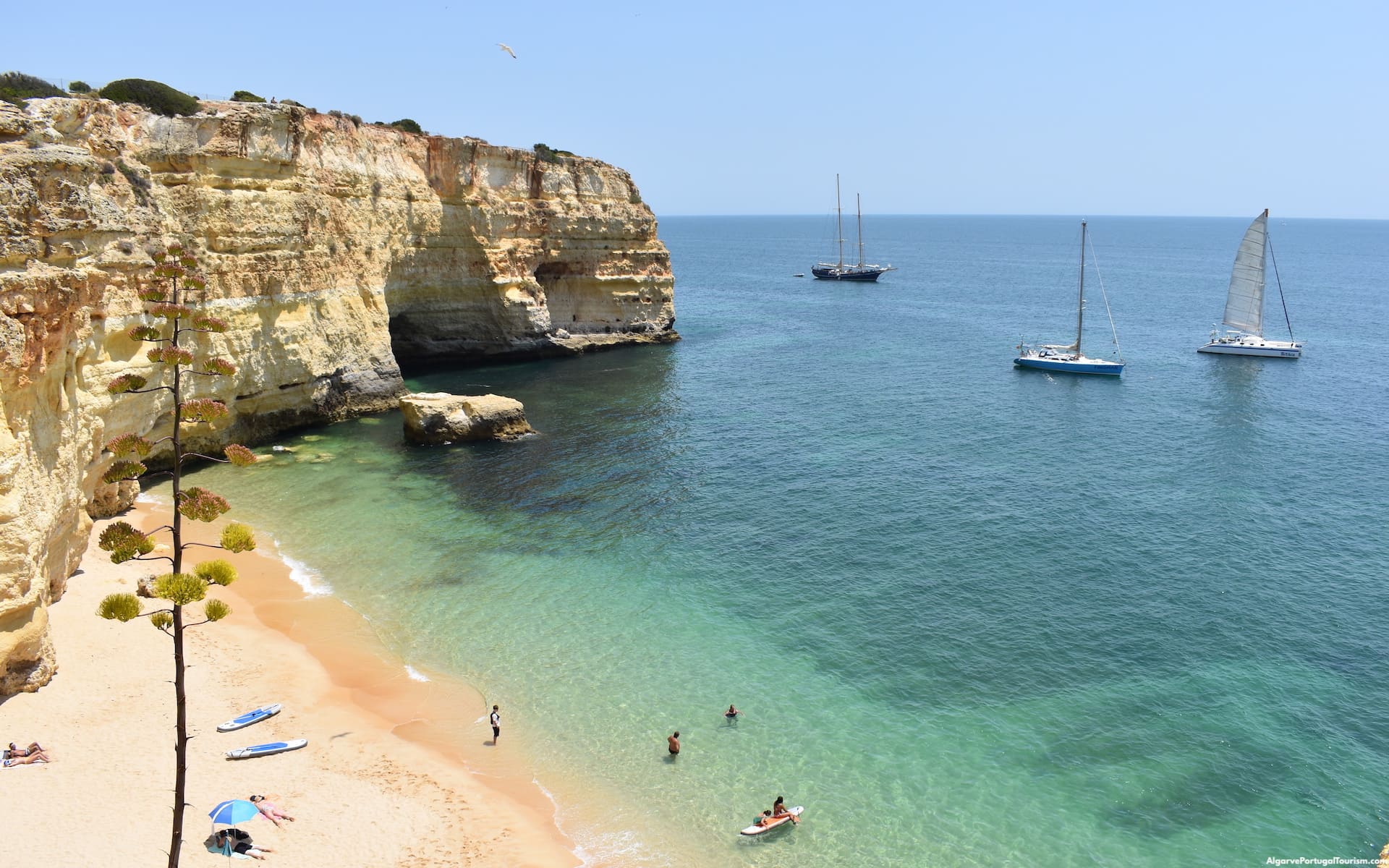
S un-worshippers from all over Europe come to the continent’s southwestern tip for some of its most beautiful beaches , magnificent cliff scenery , fantastic grottoes , world-class golf courses and luxury or family-friendly resorts. Algarve is Portugal’s most visited region, but while it’s a top summer destination for Europeans, it remains a place to be discovered by everyone else. This makes it Europe’s most famous secret, as it’s officially promoted.
Visitors find beaches of every type here -- from people-packed bays with magnificent rock formations to secluded coves, dune islands with golden sand stretching as far as the eye can see, and wild, remote and nearly deserted stretches backed by breathtaking cliffs for nature lovers (and naturists). The waters are shallow and calm for swimming or have the perfect waves for surfers (novices and pros alike). The entire coast is very clean, as certified by the Blue Flag flying at almost every beach.
This was considered the edge of the Earth before sailors ventured into the unknown during Portugal’s golden age of exploration, and there’s something thrilling about standing on what was once considered the end of the world . Windswept capes and pristine landscapes still make it feel that way today, giving it a romantic atmosphere. Although one of the most devastating earthquakes in history destroyed almost everything in the region in 1755, it preserves exotic and traditional architecture , and there are historic sites worth exploring. Then there are the reasonably-priced resorts, the golf, the water parks and surfing that made it a hotspot, and you have a destination for all types of travelers, of all ages and tastes, who want to return time and again.
Algarve Travel Planner
Helpful insider tips to plan the perfect days in the region:.
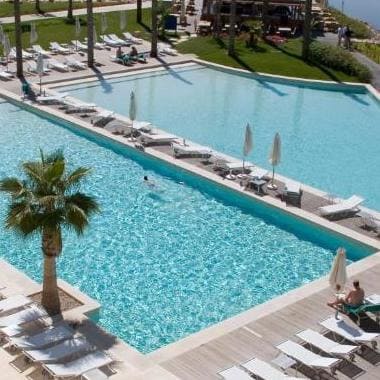
Where to Stay The Best Areas and Hotels
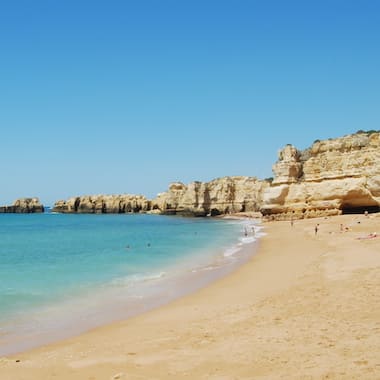
The Best Beaches Choose the Right Beach For You
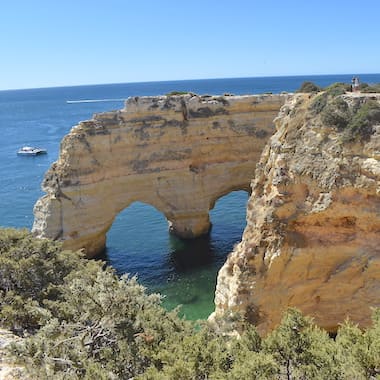
Top 10 Attractions The Best Things to See and Do
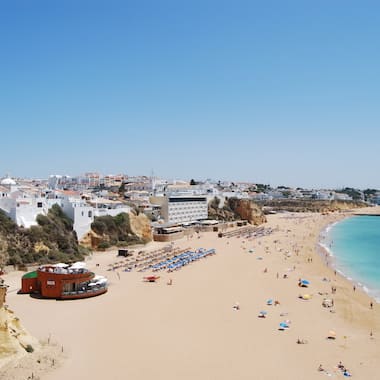
Top 10 Destinations The Best Cities and Villages to Visit
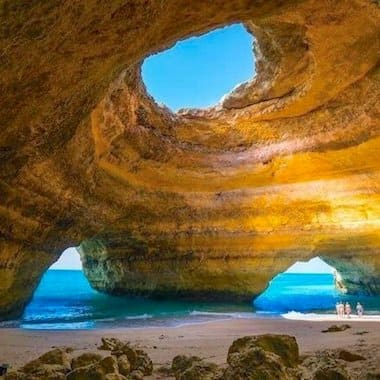
The Best Caves Must-See Natural Wonders
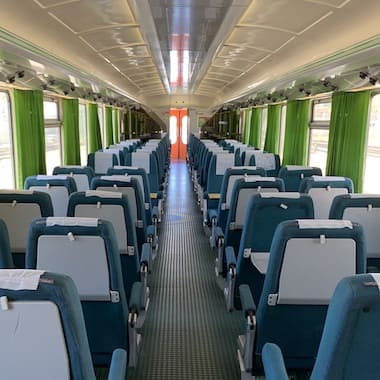
Transportation Guide How to Get There and Around
Which part of algarve is best.
The Algarve region could be divided into three sub-regions -- the east, central, and western Algarve. Each offers a different experience, so where you go depends on what type of holiday you want to have:
Central Algarve
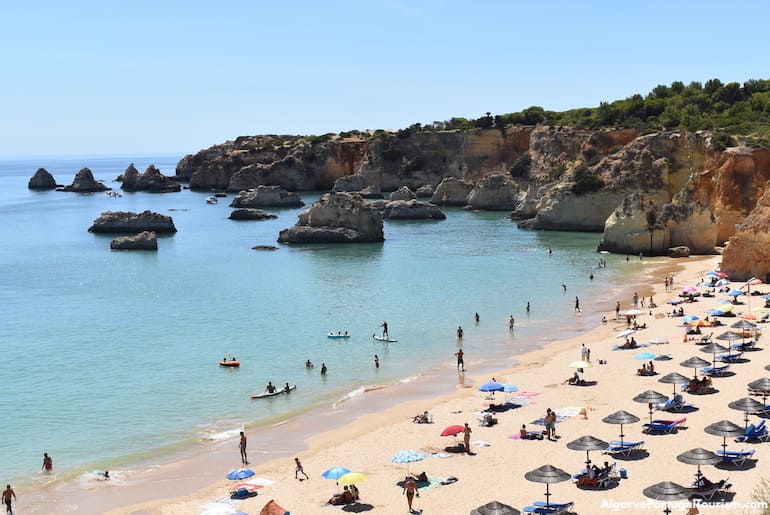
This is where tourism in Algarve was born in the 1960s and the favorite area of British, German and Dutch tourists . It goes from Faro to Portimão and is the most developed area . Some former fishing villages are now major resorts with high-rise apartment buildings and hotels, looking more like Miami or Costa del Sol in some parts (such as Praia da Rocha and Quarteira ). However, there are some extraordinary beaches and caves , including many of the region’s most beautiful (by Lagoa , Carvoeiro and Alvor ), some crowded, others secret, only accessible by boat and waiting to be discovered. Vestiges of a more traditional Algarve can be found in narrow whitewashed streets and on quiet coves. This is where you also find the most luxurious resorts ( Quinta do Lago , Vale do Lobo and Vilamoura ), the water parks and the liveliest nightlife (in Albufeira ). Inland is the historic town of Silves , with the Algarve’s best-preserved castle. Due to the variety of attractions for all budgets, it’s the most visited part of the region.
Eastern Algarve
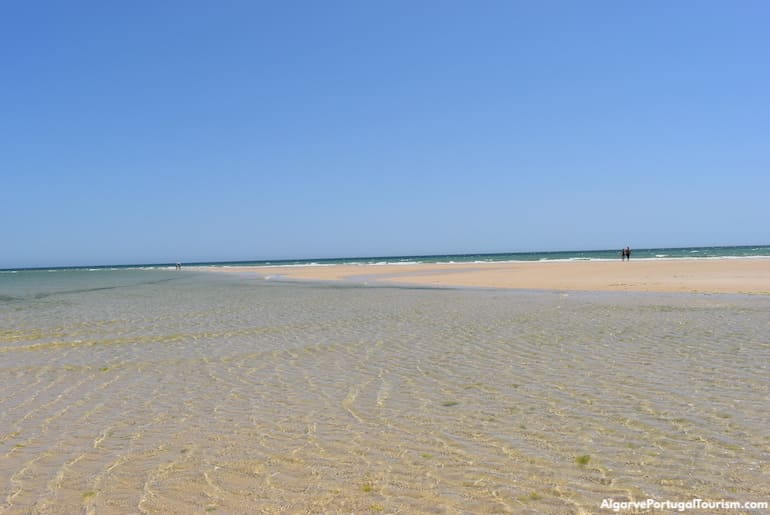
It goes from the Spanish border to the main city and regional capital (Faro, where there’s the international airport), and is mostly visited by Portuguese and Spanish tourists . The coastline says goodbye to caves and cliffs and hello to miles of dunes, lagoons, marshes and a series of sandy islands in the Ria Formosa Natural Park , home to some of the region’s best and most spacious beaches. It’s quieter than the central region and has charming small towns and villages like Tavira , Cacela Velha , Castro Marim and the fishing port of Olhão . These preserve traditional architecture of Roman and Moorish influence and are more typically Mediterranean when it comes to climate and water temperature.
Western Algarve
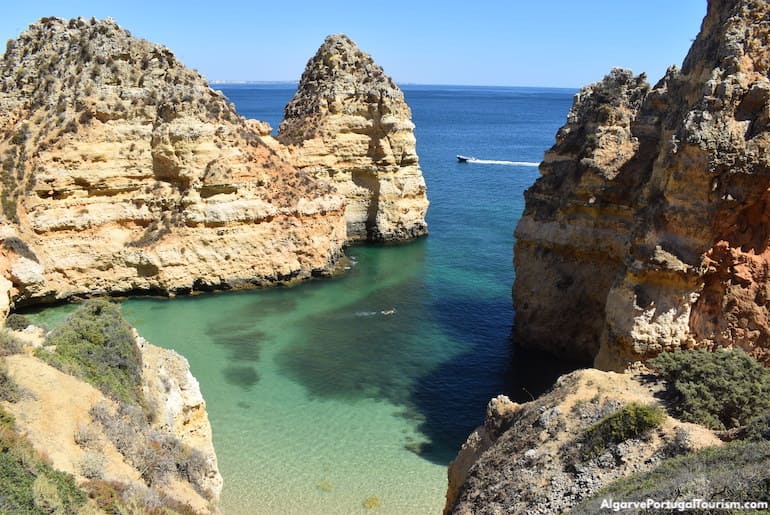
From Lagos to Sagres are small fishing villages and scenic beaches with golden rock formations . In Sagres the landscape changes, with soaring cliffs hiding breathtaking beaches for surfing and naturism . This west coast is the Costa Vicentina , considered the wildest in Europe . While Lagos has become popular with young tourists for its photogenic beaches, Sagres and Costa Vicentina still enjoy relative obscurity and remain the almost exclusive destination of surfers, hippies and naturists.
Algarve Tourism - Frequently-Asked Questions
When is the best time to visit algarve.
Algarve’s Mediterranean and Atlantic climate gives it pleasant weather throughout the year, with warmer and sunnier winters than elsewhere in Europe, but it’s never warm enough for the beach between November and March. However, temperatures and the sea are just fine for golfers and surfers in spring and autumn. The height of the tourist season is July and August (especially August, when families from around Portugal descend to the southern shores), so that’s when you find the beaches at their most crowded and prices at their highest. The best time to go is therefore late June or early September , especially for couples who prefer child-free environments at the beaches and hotels. The weather is suitable for sunbathing from late April to early October . The driest months are July and August, with an average of just one day of rainfall in July and zero days in August. June averages two rainy days and September has about five. There are twelve daily sunshine hours from June to August. High temperatures average 28C (82F) in June, 33C (91F) in July and 32C (90F) in August.
What is Algarve known for?
Algarve is known as one of the sunniest regions in Europe and with some of the continent’s finest beaches , extraordinary rock formations , amazing caves and golden cliffs . It is also one of the most beautiful places in the world ! It was first settled by the Phoenicians, Greeks, Carthagianians, and later by the Visigoths, but it was the Romans and the Moors who most left their mark. There are traces of Roman villas and mosaics around the region, while the many almond, fig and orange trees; latticed chimneys and white domed buildings reflect the Moorish heritage. When the kingdom of Portugal was founded in the 12th century in northern Iberia, it expanded south and conquered “Al Gharb” (“the West”). It was officially made part of Portugal in 1267. Two centuries later it played a major role in the Age of Discovery , when Prince Henry the Navigator established a pioneering navigation school in Lagos and Sagres, where ships were built and expeditions launched. The most visited monument in the region is the prince’s fortress in Sagres , which is a European Heritage Site for its significant role in European history and culture.
What is the most beautiful town in Algarve?
Most people will agree that Tavira is the best-preserved Algarve town and therefore the most beautiful. Others prefer Lagos, since its coastline is stunning and its beaches some of the most photogenic in the region. Carvoeiro is the winner of the smaller towns, serving as a gateway to some of the best and most famous beaches.
How many days should I stay in Algarve?
While many people do head to Algarve for just a weekend, it’s a destination for an extended holiday in the sun. The average length of a trip to Algarve is two weeks . Many people stay for a week, but there are families that stay the entire month of July or August. If you just want to get to know the region, five to seven days will be enough to experience the highlights, including the more famous caves, beaches, islands and monuments. In a grand tour, stopping at the main destinations, we recommend two days in Faro (including a trip to one or more of the islands), two days in Albufeira (beach-hopping), three days in Tavira (including a trip to Cacela Velha), two days in Carvoeiro (for the famous caves and beaches nearby), two days in Lagos, and two days in Sagres (which should include the beaches of Costa Vicentina).
Is Algarve Expensive?
Algarve has always been known as a budget-friendly destination , but that of course depends on where you stay and dine. There are luxury resorts and Michelin-starred restaurants, but also budget apartments and hotels for families, and restaurants serving good-value meals of fresh fish and other local delicacies. It’s certainly cheaper than St. Tropez, Sardinia, Ibiza, Mallorca and the other Balearic islands, or the Greek islands. In fact, it consistently ranks at the top of best-value beach destinations for travelers from the UK and around Europe. It’s considered the most affordable destination for summer holidays in the Eurozone, with prices about 25% lower than on the Costa del Sol, across the border in Spain.
Is Algarve Safe?
Portugal is a very safe country (it consistently ranks in the top 5 in the annual list of world’s most peaceful countries), but, naturally, in a major tourist destination like Algarve, unfortunate episodes do occur. Violent crime is very rare and the vast majority of tourists have a problem-free holiday, but always use common sense as you would back home. Always be aware of petty crime like pickpocketing in crowded places and never leave valuables in your car. It’s also a good idea to head back to your hotel as soon as you spot rowdy tourists and drunken behavior in nightlife areas, where trouble sometimes arises.
How to Go to Algarve
Algarve can be reached by regular flights from most major European capitals, and low-cost airlines also offer seasonal services from smaller cities. The international airport in Algarve is in Faro, which is roughly at the center of the region. There are also 30-minute flights and trains from Lisbon (the slower Intercidades train service takes 3 hours and 30 minutes and the faster Alfa Pendular takes 3 hours).
Do you need a car in Algarve?
You don’t need a car in Algarve if you stay in the major towns of Albufeira, Lagos, Faro, Vilamoura, and Tavira, where beaches are within walking distance and there are good public transportation links (trains, buses or ferries). However, to explore some of the best beaches and the smaller towns, you do need a car, have to rely on taxis or Uber (which will increase the cost of your holiday significantly), or have to plan your itinerary very carefully and use the often very infrequent buses.
Is English spoken in Algarve?
You’ll find that Portugal is the southern European country where English is better and more widely spoken, especially in the cities of Lisbon and Porto , and in Algarve. The British make up the biggest percentage of tourists in the region, so you can expect no problems communicating in English at hotels, most restaurants and shops.
Algarve Tourism - Quick Tips
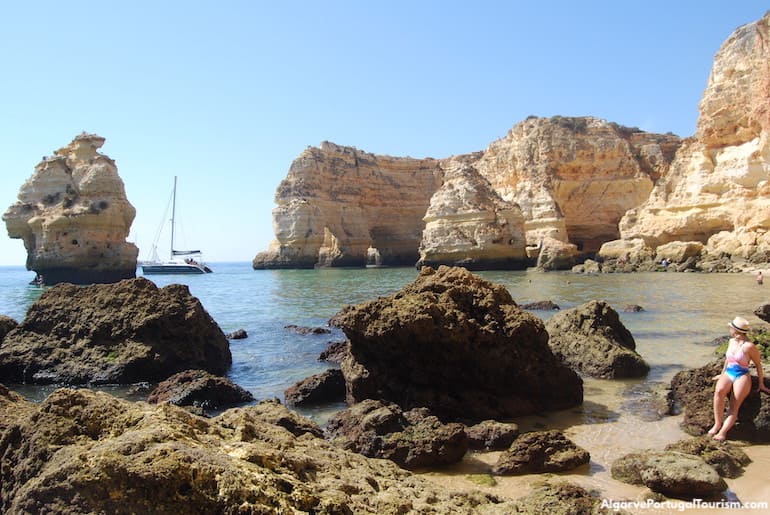
(See links to the different destinations at the bottom of this page)
Best Large Resort Towns - Albufeira, Lagos, Vilamoura
Best Small Resort Towns - Alvor, Carvoeiro
Best Small Villages - Burgau, Salema
Best Destinations for Families - Albufeira, Praia da Luz
Best Destinations for Young Tourists - Albufeira, Lagos, Praia da Rocha
Best Destinations for Mature Tourists - Albufeira, Alvor, Carvoeiro, Tavira
Best Destinations for Surfing - Costa Vicentina, Sagres
Nightlife Destinations - Albufeira (Praia da Oura), Praia da Rocha, Vilamoura
Luxury Resorts - Quinta do Lago, Vale do Lobo
Low-Cost Destinations - Armação de Pêra, Quarteira, Monte Gordo
Best Destinations for Culture and History - Faro, Lagos, Tavira
Golf Destinations - Praia dos Salgados (Albufeira), Quinta do Lago, Vale do Lobo, Vilamoura
Winter Destinations - Faro, Tavira
Official Algarve Tourism Office
Everything you need to plan your visit to Algarve is on this website. It offers complete and entirely independent information from locals and travel experts, not sponsored by or associated with any local institution or organization. However, if you still have any questions when you arrive, pass by the official tourist office at Faro airport. If you’re not arriving by plane, you’ll find tourist offices in all of the region’s main towns. They’re usually found in or around the main squares or pedestrian streets.
Algarve Map
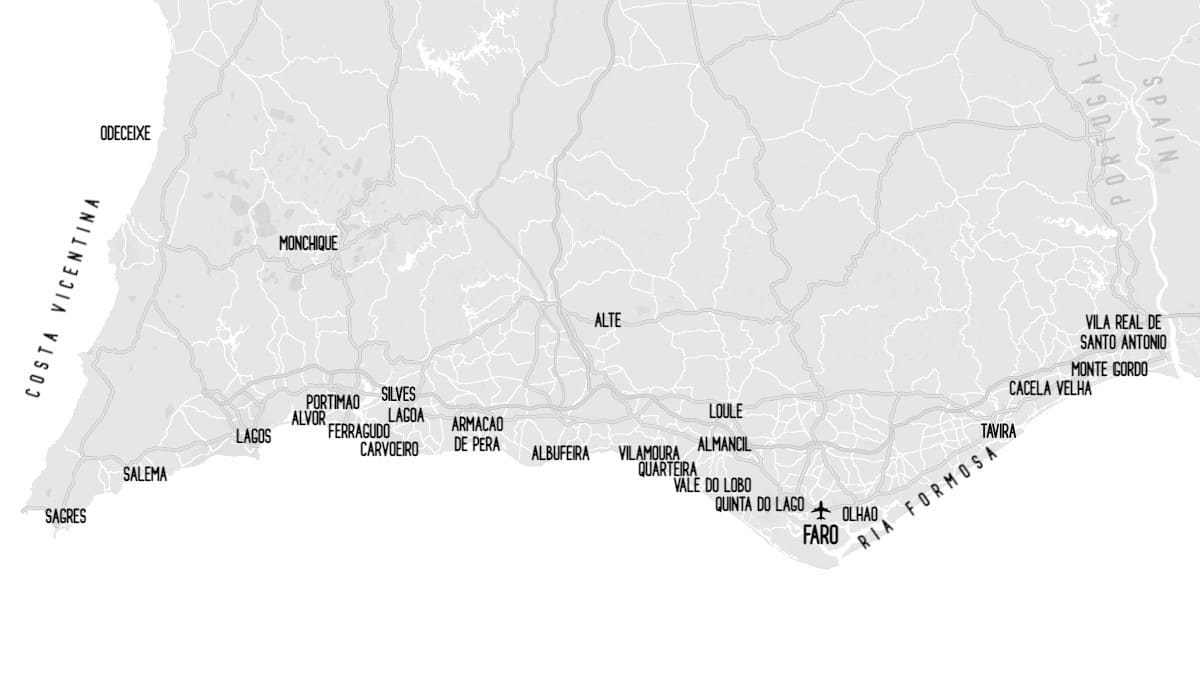
Complete Algarve Guide
Where to stay.
Top 10 Hotels
Beach Hotels
All-Inclusive Hotels
Hotels with Pool
Romantic Hotels
Design & Boutique Hotels
Luxury Hotels
Best Hostels
Budget Hotels
Family Hotels
Best Apartments
What to See and Do
Top 10 Attractions
Top 10 Places to Visit
Top 10 Monuments
Best Caves and Cliffs
Romantic Places
Algarve in Winter
50 Best Beaches
Nude Beaches
Secret Beaches
Surfing Beaches
Gay Beaches
Albufeira Beaches
Alvor Beaches
Carvoeiro Beaches
Costa Vicentina Beaches
Faro Beaches
Lagos Beaches
Olhão Beaches
Portimão Beaches
Sagres Beaches
Tavira Beaches
Transportation
Algarve Transportation
Faro Airport
From Lisbon
Other Portugal Destinations
Lisbon Beaches
Places in Algarve
Armação de Pêra
Cacela Velha
Castro Marim
Costa Vicentina
Monte Gordo
Quinta do Lago
Ria Formosa Natural Park
Vale do Lobo
Vila Real de Santo António
8 of the best places to visit in the Algarve

Feb 27, 2024 • 6 min read
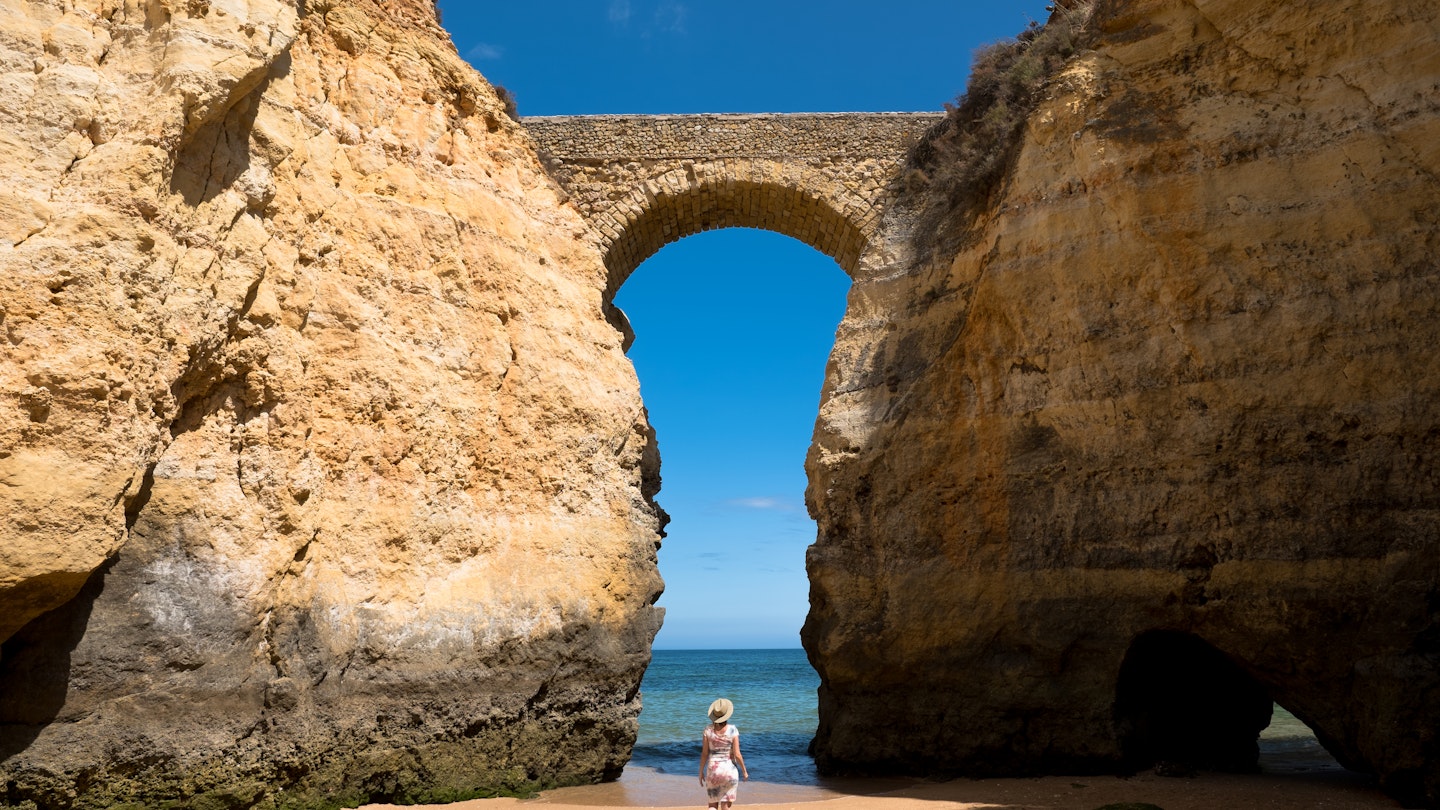
From beaches to culture-packed towns, experience the best of Portugal's Algarve with these top places to visit © David Navarro Azurmendi / Getty Images
The Algarve hits all the right notes when it comes to seaside getaways.
Inviting beaches and great weather are the just beginning of a long list of the region’s many charms. This southern pocket of Portugal also has castles, historic cobblestone centers and cliff-top villages overlooking wild stretches of coastline. Whether you’re traveling solo, heading off on a romantic getaway or seeking a child-friendly place with lots of activities on offer near the seaside, the Algarve has you covered.
To help you plan your visit, here's a rundown of some top places to go.

Best surf in the Algarve
The westernmost town in the Algarve, Sagres has some of Portugal’s most spectacular scenery. At the centuries-old Fortaleza de Sagres , you can walk to the edge of sheer sea cliffs and watch the waves crashing far below.
According to legend, Sagres was where Prince Henry the Navigator founded his school for sailors (cartography, ship design, astronomy and, of course, navigation) back in the 15th century, ushering in the Age of Discoveries. Even more drama – some say the best viewpoint in the Algarve – lies just a few kilometers north at the Cabo de São Vicente , Europe’s southwesternmost point. There, a lonely lighthouse overlooks the jagged wind-whipped cape.
These days, Sagres continues to look out to sea – often in search of great waves owing to the popular surf camps here, or perhaps with an eye toward leaping cetaceans on a dolphin-watching cruise.
Planning tip: The village itself is smaller and quieter than towns in the central Algarve, but if you want some action, you'll find it happening at terrace bars and restaurants along the main drag of Rua Comandante Matoso.
Best place to visit for history
Many travelers fly into Faro and quickly depart for resorts to the east and west. Unfortunately, they’re missing one of the Algarve’s most intriguing towns, with a cobblestone center that’s packed with history. You can feel the hands of time spin backward while entering the walled medieval quarter beneath the neoclassical Arco da Vila. Up ahead, the Sé (cathedral) lords over the town. Built in the 13th century (likely on top of a Roman temple), only a few original elements remain – the rest rebuilt in a mishmash of Gothic, Renaissance and baroque styles after the devastating 1755 earthquake.
Planning tip: Make time to climb to the rooftop for views over the town, then complete your time-travel journey with a visit to Museu Municipal, a domed 16th-century landmark that was once the epicenter of the Jewish quarter.
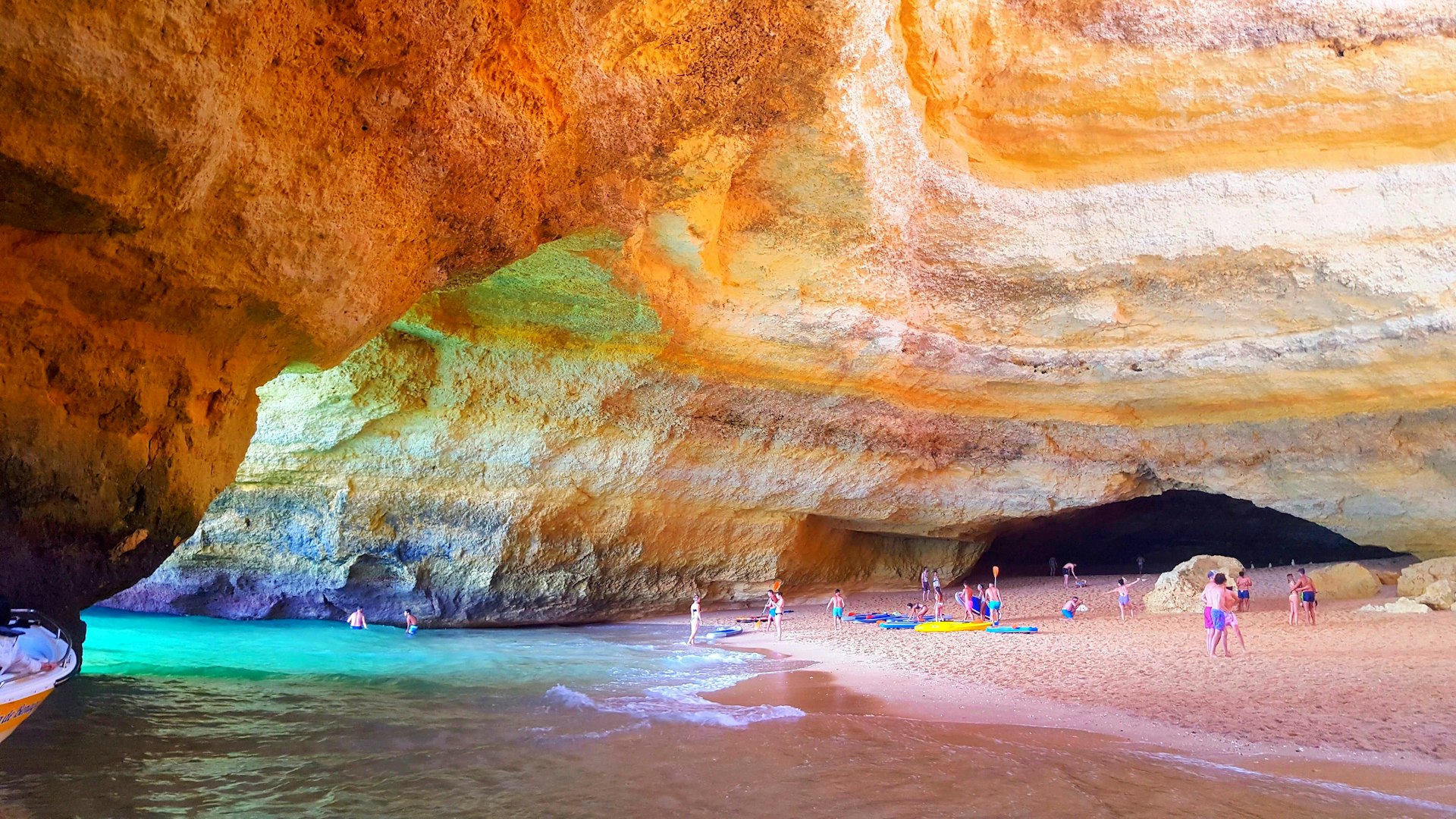
3. Carvoeiro
Best place for families with kids
Backed by whitewashed houses and sandstone cliffs, the beach of Carvoeiro is lapped by calmer seas (watched over by lifeguards), which makes it a great choice for families. Just uphill from the golden sands, the village has a walkable center dotted with outdoor eateries that will please kids and adults alike. A short distance from town, you’ll find some other stunning beaches, including Praia do Vale Centeanes, a perfect spot for some fun building sandcastles.
Planning tip: Carvoeiro is also the launchpad for a wide range of tours, including boat trips to the Gruta de Benagil , a cathedral-sized sandstone cavern lit by sunlight streaming through a hole high overhead.
Best for inland exploring
It’s hard to turn your back to the sea, given those golden sands and aquamarine views. But that’s indeed the best strategy if you hope to discover one of the Algarve’s most attractive towns. Just 15km (9.3 miles) from the ocean, the hillside settlement of Silves stretches along an idyllic bend of the Rio Arade and is home to the most picturesque castle in the Algarve. You can walk the ramparts of the citadel and wander through the exhibitions which describe the invasions and occupations over the centuries. Afterward, you can enjoy food and drinks on the terrace of Café Inglês .
Planning tip: The best time to come is on Sunday afternoons when the cafe hosts live bands.
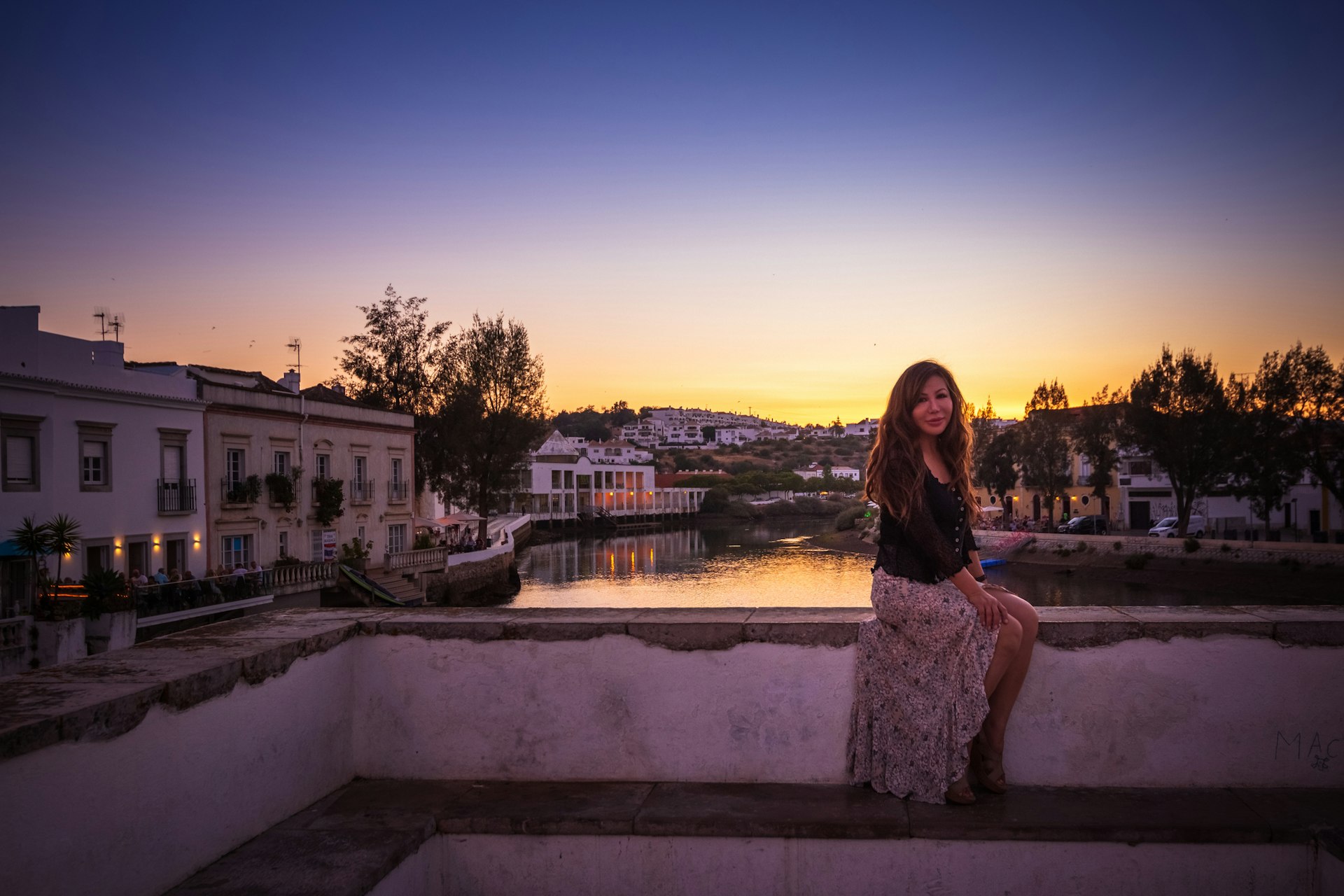
Best for culture, wine and music
It’s easy to fall for Tavira , one of the Algarve’s most captivating towns. A former Roman settlement, Tavira wears its history with pride, with its medieval-esque old quarter, a hilltop castle and an elegant seven-arched span over the Rio Gilão, aptly named Ponte Romana (Roman Bridge), which is, in truth, a 17th-century reconstruction of the original work by Roman engineers. You can learn about cultures of the past at Núcleo Islâmico , which houses a small collection of 11th-century pieces from the Algarve’s days under Islamic rule.
Planning tip: Tavira is also the best place in the Algarve to learn about Portugal’s deep-rooted music traditions. At Fado Com História , you can hear live fado (a soulful style of singing best described as "the Portuguese blues") followed by a wine tasting – featuring vineyards of the Algarve, of course.
Best for dining and nightlife
One of the Algarve’s liveliest destinations, Lagos has a lot going for it. There’s plenty to see around town, starting with its historic architecture – baroque churches, a 17th-century fortress and the old town walls. The beaches nearby draw even more admirers, particularly Praia de Dona Ana, one of the Algarve’s prettiest beaches.
When the sun goes down, Lagos’ allure only increases. Restaurants on the cobblestones and hidden in backyard gardens (like Michelin-listed Artistas ) fill with diners feasting on fresh-off-the-boat seafood. The evening continues at microbrew bars and cocktail lounges dotting the narrow lanes. Take in the scene on the rooftop terrace of Bon Vivant , or join the party people in the dance club below.

7. Carrapateira
Best for wild beauty
The west coast of the Algarve is a rugged landscape of cliff-backed beaches and wild vegetation. As part of the Costa Vicentina (which continues up into the Alentejo), this chunk of the Algarve has some delightful little towns where you can stay while exploring the pristine coastline. Peaceful Carrapateira lies on a headland near two photogenic beaches without a building in sight.
Planning tip: Before heading out on coastal walks or surfing the waves, visit the Museu do Mar e da Terra da Carrapateira, an endearing ethnographic museum with photos depicting traditional lifestyles over the years in Carrapateira.
Best place for couples
The quiet village of Galé is one of the best places in the Algarve for a romantic getaway. The town’s picturesque beach ( Praia da Galé ) is an obvious choice for a day on the waterfront, and even more secluded spots (like Praia das Salamitras) are a short hop from town. Galé has some lovely B&Bs and guesthouses, including the high-end Vila Joya , with its double Michelin-starred restaurant .
Planning tip: Don’t miss the sunset from beach-facing Pedras Amarelas (be sure to reserve a table on the terrace). For a big night out, you can also head to nearby Albufeira , which is lined with restaurants and bars.
This article was first published Jun 17, 2022 and updated Feb 27, 2024.
Explore related stories

Tips & Advice
May 27, 2024 • 6 min read
Portugal is beautiful, historic... and popular. Escape the crowds at these off-the-radar places recommended by our team of Portugal-based writers.
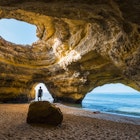
Mar 3, 2024 • 6 min read

Feb 27, 2024 • 3 min read

Feb 25, 2024 • 7 min read

Feb 23, 2024 • 6 min read

Jan 19, 2024 • 11 min read

Jan 2, 2024 • 8 min read
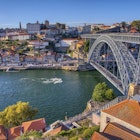
Dec 18, 2023 • 5 min read

Nov 17, 2023 • 7 min read

Oct 25, 2023 • 7 min read
- 1.1 Barlavento
- 1.2 Sotavento
- 2.1 History
- 2.2 Climate
- 2.3 Visitor information
- 4.2 By plane
- 4.4 By train
- 4.5 By boat
- 5.1 By train
The Algarve is the southernmost region of Portugal , on the coast of the Atlantic Ocean . It is Portugal's most popular holiday destination due to the approximately 200 km (120 mi) of clean beaches, the cool, unpolluted water, and the fact that it is relatively cheap, very safe, and overall welcoming.

The cities of the Algarve are traditionally grouped into Barlavento (Windward) and Sotavento (Leeward), the western and eastern halves, respectively.
- 37.318 -8.555 1 Monchique — the inland Algarve, superb food, nature and views
- 37.317778 -8.8 2 Aljezur — close to famous surf spots
- 37.0124 -8.9367 4 Sagres — near Europe's southwesternmost point
- 37.102 -8.672 5 Lagos — narrow, winding streets, quaint shops and wonderful restaurants, with an old inner city inside the remnants of a protective wall.
- 37.1286 -8.586 7 Alvor — a base for visiting the Ria de Alvor Nature Reserve, with a nice beach
- 37.1 -8.466667 9 Carvoeiro — picturesque fishing village
- 37.189 -8.44 10 Silves — first capital of the Algarve which has a Moorish red stone castle
- 37.091 -8.246 11 Albufeira — one of the most popular holiday destinations in the Algarve: lovely beaches, very good climate, with many restaurants, bars and pubs
- 37.071 -8.103 13 Quarteira — a wide, clean beach with clean water and a nice promenade
- 37.019 -7.934 14 Faro — the regional capital, a popular sun destination in the summer, and a base for exploring the surrounding area
- 37.15 -7.883333 15 São Brás de Alportel — inland town with several sights and numerous bed and breakfasts
- 37.0271 -7.8411 16 Olhão — a city near the Ria Formosa and Faro, the largest fishing port in the Algarve; full of character with Moorish-style houses
- 37.126 -7.65 17 Tavira — a city near the Ria Formosa lagoon, one of the most monumental cities in Portugal, with its 37 churches
- 37.219 -7.445 18 Castro Marim — it has a medieval castle, and a popular medieval festival in August
- 37.194 -7.416 19 Vila Real de Santo António — on the eastern bank of the Guadiana river which forms the border to Spain
- 37.469972 -7.473111 20 Alcoutim — landlocked town across from Spain on the Guadiana River

The Algarve ( ahl-GAHR-v(ih) , /aɫ.ˈgaɾ.vɨ/) is rich in culture and diversity. If you are looking for fast paced resorts or a calm tranquil setting either is attainable. The entire region is around 5,400 km 2 (2,100 sq mi). Although the number of permanent residents is under 500,000 the area receives more than tenfold that in tourism each year. The busiest times of year tend to be July and August.
Following the neolithic period of the regions history, approximately 1000 BC, settlements and trading ports were established by the Phoenicians who were attracted by deposits of copper, manganese and iron. They came from the coastal regions of the eastern Mediterranean of modern-day Syria, Israel and Lebanon. Circa 550 BC Portimão was one of the ports founded by the Carthaginians who came from North Africa. In the 2nd century BC the region came under the control of the Romans as they spread throughout the Iberian Peninsular. Many Roman ruins still remain today throughout the Algarve and can be seen in many areas, but the best to visit are probably at the Milreu ruins, 7 km (4.3 mi) from Faro, where buildings that started construction as a Roman villa later became a Christian Church.
Following the collapse of the Roman Empire, the Visigoths took control of the Algarve until the invasion of the Moors from North Africa in 711 AD. At this time, the Visigoths who came from central Europe, were defeated in the Battle of Guadalete by a force of invading Arabs and Berbers.
There followed a period of five centuries of Arab rule in Iberia. The Moors conquered the Algarve in 716. Faro, which had been called Santa Maria, was renamed Faraon, meaning 'the settlement of the Knights'. Even the name of the region owes its origin to the Moors who knew the region as 'al-gharb' meaning 'the west'. There is evidence of the moors throughout the Algarve and Southern Spain, illustrated by chimney stacks, pottery and the Moorish style of architecture, and particularly, the Arabic castle at Silves. The castle was built by Almoravid Arabs in the 11th century out of red sandstone and dried mud and is the best preserved Moorish castle in the country. In the 12th century, King Afonso III, with a little help from English mercenaries, finally evicted the Moors and once again the Portuguese dominated the region, although the area was not fully secure from Moorish attacks until the middle of the 13th century.
Born in Porto in 1394, Prince Henry the Navigator based himself somewhere around Lagos/Sagres, and is considered to be responsible for many of the 'discoveries' made by the Portuguese in the middle ages sending out expeditions to Africa, the islands of Madeira and the Azores. In 1419 he was appointed governor of the province of the Algarve.
Disaster struck on 1st November 1755, with a huge earthquake whose epicentre was reported to have been 200km South-West of the country and registering 9 on the Richter Scale. The coastal areas of the Algarve were devastated by the earthquake and subsequent tsunami. The devastation was not only limited to the Algarve, British naval reports from the period indicate the arrival of a huge wave in the port of Lisbon. The damage to Lisbon was almost total, and following huge political turmoil the person responsible for the reconstruction of the city was the Marquis of Pombal, the then Prime Minister.
The Algarve's geographical position on Europe’s south-western tip in the south of Portugal gives it some special bioclimatic features. Although situated by the Atlantic Ocean, it has a temperate climate with Mediterranean characteristics, more than 3,000 hours of sunshine per year and a low annual average rainfall, mainly during the winter months. Even in the hottest days in July and August a mild breeze from the Atlantic provides relief.
The Serra in the northern half of the Algarve has a considerable influence on the climate of the region. It forms a physical barrier against the cold winds blowing from the north and the lows from the Northwest, thus giving the Algarve coast an almost Mediterranean climate, with low annual rainfall and mild temperatures in winter. Furthermore, it is also a barrier for the misty winds that come from the South.
Visitor information
- Visit Algarve , ☏ +351 289 800 400 , [email protected] . There are numerous tourist offices throughout the Algarve, including Faro airport. ( updated Jun 2021 )
English is in general used as a business language and is spoken in the tourist areas, where restaurant menus are multilingual. If you are travelling in the interior, then you would do well to carry a pocket dictionary with you, and have Wikivoyage's Portuguese phrasebook at hand. Also in case you unexpectedly have to deal with the police, English may not always be understood. You should be careful with any impolite comments – many Portuguese people have spent some time abroad and may understand you better than you think.
International flights into Faro Airport ( FAO IATA ) then (1) by bus: national buses run from outside the airport to the bus terminal regularly throughout the day time on weekdays or (2) by taxi: will be under €10 from the airport to the train station.
The toll motorway A2 leads to the Algarve from the north. You will need to allow approximately 2 hours for the 240 km drive from Lisbon to the A22 north of Albufeira.
From Spain the toll free A49 joins the A22 near Castro Marim in the Algarve after 145 km and about one and a half hours driving.
In the Algarve the toll motorway A22 Rua do Infante de Sagres goes from Lagos in the west to Castro Marim in the east at the Spanish border. Toll tariffs on the A22 depend on the distance and are recorded electronically only. Since the toll was introduced at the end of 2011 the parallel route of the national road EN125 is quite busy during rush hours, because many locals shy away from using the A22 for cost reasons. Cars with a foreign number plate have several options to pay the toll collected by an electronic system on the A22 motorway:
- Toll Card : this card, valid for one year, can be charged with €5-40 and needs to be activated by SMS, entering the license number.
- Toll Service : you can have unlimited use of the A22 for 3 days after activation, for a one off fee of €20 .
- Easy Toll : Payment by credit card (Visa or Master Card), with the toll directly deducted from your bank account
- Via Verde Visitors : renting a so called on board unit (OBU), a device that can be used both on roads with electronic or manual toll collection.
Outside the summer season some airlines reduce their direct flights to Faro, so that Lisbon Airport should be considered as alternative.
There are daily bus connections between Lagos, Olhao, Faro (and many other cities) and Spanish cities such as Seville and Huelva . A single ticket Seville-Faro costs €13 with ALSA and the journey takes 2 hr. Flixbus also has a few connections per day for slightly higher prices.
There are several daily train connections to Algarve operated by CP . Alfa Pendular ( AP ) trains connect Porto and Lisbon with Faro twice (sometimes three times) a day, making several stops on the way, journey time is 5½ hr or 3 hr, respectively. Intercidades ( IC ) trains connect Lisbon with Faro as well, they stop at more places and are a bit slower then AP . They run three times a day, journey time is 3½ hr. There is also one seasonal InterRegional ( IR) train.
In Tunes it is possible to change for Regional ( R) train to Lagos , in Faro to Vila Real de Santo António .
There is a ferry service between Vila Real de Santo António and Ayamonte (Spain). The ferry was once a main mean of transportation although after the construction of the Guadiana International Bridge it is nowadays mostly used by tourists. Naviera Armas operates a ferry to Portimão from Madeira (connecting with Gran Canaria ) with a couple of departures per month.
The Algarve Railway ( Linha do Algarve ) is a convenient possibility to get around Algarve. It connects Lagos in the west with Vila Real de Santo António on the border with Spain , calling at most towns and cities along the way ( Portimão , Silves , Tunes, Loulé , Faro , Tavira, etc.). There is no direct train between Lagos and Vila Real d/S/A. Operated are usually Regional trains, between Faro and Tunes also Alfa Pendular , Intercidades and InterRegional trains. Journey from Faro to Lagos takes from 1h30min to 1h45min.
There is also one part of The Southern Railway ( Linha do Sul ; Lisbon - Tunes), although in Algarve are situated only two stops of this line - Messines-Alte and Tunes. These stations are served by Intercidades and InterRegional trains.
All trains are operated by CP .
Regional bus companies include Eva Transportes and Frota Azul Algarve . Algarve Bus website has a collection of bus information for Algarve region.
A car is often the best way of seeing the Algarve, owing to the limited public transport services. Cars can be hired at Faro Airport and in other towns and cities in the Algarve. Most car rental companies will stipulate a minimum age of 21. Prices start from about €10 a day for a small car and there is often a wide range of cars to choose from.
The Algarve has a good network of roads, but be aware that some country roads are little more than dirt tracks. Roads are however generally well maintained, however, road markings may randomly disappear (in this case stick to the right as far as possible - a favourite Portuguese habit is to overtake, still they are mindful). After many years, the A22 (IP 1) motorway was finally completed in 2007, which goes from Bensafrim in the west all the way to Monte Francisco on the Portuguese/Spanish border. The Algarve, like the rest of Portugal and mainland Europe, drives on the right.
Petrol stations are found all over the Algarve. All stations will sell standard unleaded (95 RON) and super (97 RON) and diesel. Some stations sell LPG ( GPL ) as well. Unleaded petrol is known as gasolina sem chumbo and diesel gasoleo . Petrol prices in Portugal are high in comparison to other European countries; as of August 2009 a litre of 95 RON unleaded costs around €1.33 a litre, 97 RON super €1.47 a litre and diesel €1.06 a litre.

- 37.316667 -8.6 3 Monchique Mountains
- 37.7 -8.35 4 Caldeirão Mountains
- Beaches — over 100 different beaches, each unique in its own way. Marinha Beach ( Praia da Marinha ) is one of the most emblematic and was considered by the Michelin Guide as one of the 10 most beautiful beaches in Europe and as one of the 100 most beautiful beaches in the world
- Golf — If you are a golf lover then you have come to the right place, with over 30 courses dotted throughout the region.
- Hike — there are over 30 hiking trails crisscrossing the region
- Ceramics - the area is known for its hand-painted pottery and azulejos or tiles
The Algarve is famous for its hot and spicy Piri Piri Chicken , which can be found all over. Since it has a big and rich coast, it has a very interesting array of wonderful fish and seafood, from sardines to cataplanas , and many dry fruit sweets that will make your mouth water for more.
Medronho is a traditional fruit brandy, traditionally produced and drunk in The Algarve. Medronho can be fiercely potent and is available in variations ranging from unlabelled local homebrew bottles, moonshine style, to connoisseur tipples at more of a premium price range.
- Youth hostels ( Pousadas de Juventude) can be found in the following places: Arrifana near Aljezur on the western coast, Alcoutim on the Guadiana river, Faro , Lagos , Portimão and Tavira .
- Camping grounds : The Algarve disposes of more than 20 official camping grounds, mostly located on or near the coast.
- Caravaning : To improve the service quality and security for auto caravaning, a new route for motor homers ( Network for Motor-Caravanning in the Algarve Region/RAARA ) was launched end of 2015, comprising 22 infrastructures in total.
- Alentejo — rural plains region to the north
- Évora — city full of historic sights
- Huelva — province of Spain's Andalusia region
- Lisbon — the nation's capital
- Seville — closest major Spanish city
- Fátima – city of the worldwide famous Marian apparitions with an international catholic shrine
- Has custom banner
- Has mapframe
- Maps with static images
- Maps with non-default size
- Has map markers
- Do listing with no coordinates
- All destination articles
- Outline regions
- Outline articles
- Region articles
- Bottom-level regions
- Has Geo parameter
- Pages with maps
Navigation menu

- Faro Guide Algarve
Portugal Guides
- Estremadura
- Viana do Castelo
- Vila do Conde
- More Guides »
- Portugal A-Z
- Portuguese Food
- Gay Portugal
- Restaurants
- Famous Portuguese
- More Culture »
- Hotels in Portugal
- Hotels in Algarve
- Hotels in Lisbon
- Hotels in Porto
- Portugal Hostels
- Spain Hostels
- Banks & Money
- Exchange Rates
- Facts & Figures
- Portuguese Phrases
- Word of the Day
- Portugal Books
Portugal City Guides
- Castelo Branco
- Praia da Rocha
- Vila Real de Santo Antonio
- Caldas da Rainha
- Figueira da Foz
- Monte Gordo
- Ponte de Lima
- Porto Santo
- Póvoa de Varzim
- Santiago do Cacém
- Vila Nova de Gaia
- Vila Viçosa
Portugal City Travel Guide: Faro
Tourist information.
- Around Faro
Internet Cafes
- Accommodation
Getting to Faro
- Local Football Teams
- Faro & Algarve Map
- Luggage Storage in Faro

Faro is the southernmost city in Portugal, and is the coastal capital of the Algarve region. The Algarve occupies the southern end of Portugal, from the Atlantic Ocean coast to the west, all the way to the Spanish border in the east.
Faro is part of the Rio Formosa, a coastal network of lagoons that extends about 40 km along the southern shoreline just east and west of Faro. The nearest beach is about 7 km south of the city.
Faro's history goes back at least 2,500 years, and the city was, in turn, Roman, Byzantine, Visigoth, and Moorish, before becoming Portuguese in 1249.

Not much of really old Faro remains due to earthquakes in 1532 and 1755, and an English army in 1596. However, some fine buildings built after the 1755 earthquake are worth seeing.
As the Algarve's administrative center, Faro has an international airport: Faro Airport , and a university, the University of Algarve. The town has an average population of about 65,000. As with the whole of the Algarve, the population fluctuates with the seasons - summer being the most crowded.
The harbor is the city's hub, and it's a short walk east from there to the main modern shopping and dining street of Rua de Santo Antonio. For night life, go north from the harbor to Rua do Prior for clubs and Conselheiro Bivar for outdoor cafes and bars.
The old, mostly walled, neighborhood of Cidade Velha at the southern end of the harbor and is where the town began as a Moorish settlement. Enter through the neoclassical Acro da Vila , which was part of the reconstruction of Faro after the earthquake in 1755 overseen by Bishop Francisco Gomes. The Acro da Vila features a statue of the patron saint of Faro, Thomas of Aquinas. Faro's city walls (Muralhas de Faro) date from various ages including Roman, Byzantine, Moorish and Christian.
Inside the Old City is the Se, or Faro Cathedral . Christians built it on the site of a former mosque, which was on the site of what had previously been a Roman temple. The original cathedral was then destroyed by the English in 1596 and rebuilt half a century later. Across from the cathedral is the Paco Episcopal (Bishop's Palace), built in the 18th century with some fine azulejos.

The Museu Municipal de Faro (Museu Arqueologico) (Tel: 289 897 400), near the Se is housed in the Renaissance-style former Convento de Nossa Senhora da Assuncao that became a museum in the early 1970s. Although small, it is well worth a visit to see relics of almost 2,000 year-old Faro (then a Roman city named Ossonoba), 10th to 13th century Faro (then a Moorish city), and a collection of beautiful artworks from the 16th to the 19th centuries. Among the displays are some impressive ancient Roman and Islamic artifacts including a beautiful mosaic depicting the God of the Sea. You can exit the Old Town here through the restored Arco de Repouso, with a casting in bronze of the original Moorish charter of the town. Closed Monday.
The Igreja de Nossa Senhora do Carmo (Igreja do Carmo for short) is a picturesque Carmelite Baroque church near the central post office on Largo do Carmo. Its construction began in 1713. The Baroqueness is breathtaking in its gorgeous intricacy, with everything covered in gold leaf brought over from Brazil. Further inside, though is the stark, simple Capela dos Ossos (Chapel of Bones) dating from 1816. It is decorated with the remains of 1,200 monks, viewable for EUR 1.

Down by the marina is the Jardim Manual Bivar , the starting point for the Comboio Turistico trackless train, which does a circuit of the town's attractions. On the edge of the marina is the Maritime Museum (Museu Maritimo). The Teatro Lethes was formerly the Jesuit college of Santiago Maior and holds a lovely miniature reproduction of Milan's opera house, La Scala, built by an Italian doctor after the building was sold off. Enquire behind the hospital within office hours to be shown in.
The Faro Tourist Office is on Rua da Misericordia 8-12 (tel. 289 803 604).

Places to see around Faro
There are a number of interesting places to see within easy traveling distance of the center of Faro.
There are boat trips to the Ria Formosa Natural Park : the uninhabited Ilha Deserta and the channels to the sea that are features of the park.
Visitors can enjoy birdwatching on a catamaran or a traditional wooden boat and visit the southernmost point of mainland Portugal, Cabo de Santa Maria.
Close to the peaceful village of Estoi, north of Faro, are the Ruinas de Milreu - remains of a 1st century AD Roman villa and bath complex. The nearby Palacio de Estoi was built in the late 18th century and is now a lovely pousada (rural accommodation retreat).
Olhao , 9 km east of Faro, has a pleasant Arab-style quarter dating from the 19th century and reflecting the town's trade links with North Africa.
There are ferries from June to September out to two offshore islands: the Ilha da Armona and the Ilha da Culatra.
Loulé is 18 km inland from Faro and, not being a resort, is one of the few places in the area that offers a whiff of the Algarve region's pre-tourist-boom atmosphere. Loulé is also a good place to get traditional local handicrafts - you can actually watch the craftswomen and craftsmen at work making baskets, saddles, woodcarvings lace and leather goods. There is an approximately hourly bus between Loulé and Faro, as well as the train.
Golf courses in the Algarve .

Algarve Resorts
Other places to visit in the Algarve region of Portugal include Albufeira , Alcoutim , Aljezur , Alvor, Cabanas, Cacela Velha, Faro , Ferragudo , Fuseta, Lagos , Loulé , Monchique, Olhão , Portimão , Praia da Rocha , Sagres , Silves , Vilamoura and Vila Real de Santo Antonio .
Faro Shopping
For goods from Faro with a real local flavor, visit the morning market on Largo de Sa Carneiro in the north-east, open between 6.30 am and 1.30 pm.
Faro Eating
Dois Irmãos Largo Terreiro do bispo, 14 Prices for main course: EUR 8-18 Tel: 289 823 337 - reservations recommended.
Adega Nova Rua Francisco Barreto 24 Tel: 289 813 433 Excellent Portuguese food and wine in a woody interior near Faro Station.
Faro Drinking
Bar Columbus Praça D. Francisco Gomes 13 8000 Faro/Algarve Open daily with seating within the bar, in the portico and out on the street in the main square of Faro.
Diesel Bar Travessa Sao Pedro, off Rua do Prior.
List your restaurant/bar/hotel contact Advertising
Cafe Bar Origem is a 24-hour internet cafe. Address: Rua Prof. Dr. Egas Moniz 29-13, Faro, Portugal. Tel. +351 964 216 631
Cafe 2014.faro is an internet cafe not far from the Museu Regional do Algarve (Praca da Liberdade). Address: Tv. de Portugal 2, 8000-329 Faro, Portugal. Hours: 7 a.m. to midnight. Tel. +351 289 822 328

Accommodation in Faro
Faro is chock-a-block with places to stay, and with all competing for guests, most are of excellent quality for reasonable rates. Start your search with the following recommendations, listed from more to less expensive.
Luxury Guest House Opus One offers one of the best possible hotel experiences to be had in Faro, with quarters that truly live up to the name "Luxury." The interior is as varied as it is tasteful, impeccably combining aesthetics and comfort - and not without an element of surprise. The rooms are very spacious and guests can enjoy a private semi-open pool, and Jacuzzis. Even includes a billiard room and music room. The location is prime, down a quiet sidestreet, with the Igreja do Carmo on 2 minutes' walk away, and Faro Train Station only 5 minutes' walk away. Supreme comfort and relaxation in the heart of Faro.
Casa da Madalena Bed & Breakfast has something for everyone in terms of budget, but the private Double Room sleeping up to three people, and including breakfast, is legendary. This beautifully atmospheric space is a blend of modern minimalism and classic old warmth. The location, too, is unbeatable, being in the middle of Faro very near the bus and train stations, the Faro Marina, the Igreja do Carmo, and the Lethes Theater. Boasts an expansive terrace with hammocks for delightful relaxation. Spotlessly clean, and warmly hospitable.
Lemon Tree Stay is a superbly tasteful, restful hideaway near the Praca da Liberdade offering the mod-cons of accommodation convenience with a traditional vibe - and lots of greenery. The architecture is truly Mediterranean, with a tranquil courtyard and numerous other spaces to relax. Guests love the helpfulness and hospitality of the hosts, the central location, the courtyard and rooftop terrace, and the immaculate cleanliness.

Air Travel in Portugal
There are abundant scheduled, charter and no-frills flights to Faro from all over Europe. Portugalia and TAP Fly from both Porto (via Lisbon) and Lisbon. There are TAP flights to Lisbon and Frankfurt and Easy Jet and Ryanair flights to multiple destinations throughout Europe.
Train Travel in Portugal
Faro Station (tel. 289 801 726). If in Lisbon, dial 218 884 025. Four trains a day from Lisbon on about a three or four-hour journey. There are local trains to Albufeira (30 minutes), Lagos (105 minutes), Loule (20 minutes), Tavira (40 minutes) and Vila Real de San Antonio (70 minutes).
There are trains from Faro Station to Lagos and Vila Real de Santo Antonio on the Spanish border on the Algarve Line .
Car Travel in Portugal
From the west, take Route 125. From Spain, get onto N125 going west.
Search and Book Car Rental
Bus Travel in Portugal
There is a bus every hour from Lisbon to Faro, taking 3 and a quarter hours to four hours depending on the route and the traffic. There are local buses from Faro to Albufeira, Lagos, Olhao, Portimão and Vila Real de Santo Antonio (via Tavira). EVA bus company runs a service to Sevilla in Spain via Olhao, Tavira, Vila Real de San Antonio , Ayamonte and Huelva.
There are presently a number of buses leaving daily from Faro's bus station near to Faro train station and arriving at Plaza de Armas bus station in Seville, Spain. Depending on the season buses depart at 8.20 am, 8.25 am, 1.55 pm, 3.35 pm and 5.05 pm arriving at Sevilla's main bus station at 1 pm, 11.45, 5.45, 8.00 and 10.15 pm respectively.
The 8.20 am departure from Faro leaves all year round (except 25 December and 1 January). The 8.25 am, 1.55 pm and 5.05 pm departures run from 26th June-6 September. The 3.35 pm departure runs every day from 7th September to 26th June (except 25 December and 1 January).
Check the EVA website ( www.eva-bus.com ) for the latest departures, journey times and prices.

From Faro Airport
There are two buses from Faro Airport into Faro City: numbers #14 and #16. The local Proximo bus #16 runs from Faro Bus Station to Faro Airport and Praia de Faro. It takes 20 minutes between Faro Airport and Faro Bus Station. The Proximo bus #16 runs from Faro Bus Station to Faro Airport between 5 am and 11pm. Buses from Faro Airport to Faro Bus Station run from 5.20 am-11.20 pm.
The less frequent number #14 bus runs in a circular route from Faro Atalaia to Faro Airport , Faro Praia then on to Forum Algarve and Faro Bus Station.
See here for more information on Proximo buses: www.proximo.pt .
Terminal Rodoviário de Faro (Faro Bus Station) Av. da República 8000-078 Faro Tel: 289 899 760
A taxi should be under 15 Euro to Faro, 70+ to Albufeira, 90+ Euro to Lagos and 30+ Euro to Tavira. Please note these prices are estimates. It would be much cheaper, about half, to arrange your taxi beforehand online with a local Algarve taxi transfer company. We recommend Vitortransfers at Riosultravel, Agência de Viagens e Actividades Marítimo-Turísticas Lda. Alvará 511/86 Tel: +351 919 492 202.
Tips for enjoying Faro in a single day.

Local football teams
Sporting Clube Farense and Louletano.
Founded 1910; Stadium name: Estadio Algarve . Seats 30,000. The stadium now hosts music festivals as well as sports events, but has become something of a white elephant as neither of the two local clubs Farense and Louletano can afford the upkeep of around 3 million Euros a year - a sum the local councils can ill afford either. The Estadio Algarve is often used for an international women's football tournament in spring.
Portugal Hotel & Hostel Accommodation
Featured Hotel
Hotel Monaco 4 km from the beach and 3 km from the center of Faro, 64 well-furnished rooms. All major credit cards accepted. Cable TV, private bathroom & swimming pool.
Book this hotel
Book Hotel Accommodation in Faro
Hotel Monaco
Pousada Sao Bras
Hotels in Portugal - Booking.com
Hotels in Albufeira - Booking.com
Hotels in Algarve - Booking.com
Hotels in Lisbon - Booking.com
Hotels in Porto - Booking.com
Hotels in Madeira - Booking.com
Hostels in Portugal - Booking.com
Hotels in Portugal - Agoda
Hotels in Spain - Booking.com
The average high June temperatures for Portugal is between 22 degrees Celsius and 26 degrees Celsius (72 - 79 degrees Fahrenheit). Get more weather information for Portugal
Faro & The Algarve Map

Visit our partner sites:
- Britain All Over - Britain Close Up
- Britain Visitor - Guide to UK
- Iran Visitor - Guide to Iran
- Beijing Visitor - Guide to China
Portugal Tourist Info. Copyright © 2024 All rights reserved.
Terms of Use | RSS
Web Design by Web Choice UK

Visit Albufeira
The sea breeze on your face, sun-kissed warmth on your skin and a heart set on new adventures…can you feel it? Albufeira has thrills for every traveller.
© 2023 Visit Albufeira | allrights | Developed by Kapta .

14 Top-Rated Attractions & Places to Visit in the Algarve
Written by Paul Bernhardt Updated Dec 22, 2023 We may earn a commission from affiliate links ( )
The Algarve is Portugal's southernmost region, and one of the most popular vacation destinations in Europe. Blessed with a superb coastline and some of the country's loveliest beaches , the province enjoys hot, dry summers and short, mild winters. Warm sea temperatures and gentle winds add to its allure.
The Algarve is a land of contrast, and there's plenty of things to do. More than fifty percent of all visitors to Portugal spend their holidays here. The popular and more developed central region offers lively coastal resorts, first-rate tourist amenities, and some of Portugal's best golf courses .
Farther east, a string of sandbar islands and lagoons form part of a beautiful and protected natural park, and a distinctly Spanish atmosphere pervades the border towns and villages. Over to the west, a very different Algarve beckons. Wilder and more remote, this is a place to escape the crowds and where surfers seek communion with a restless Atlantic Ocean.
For more sightseeing ideas, see our list of the top attractions and places to visit in the Algarve.
2. Vila Real de Santo António
3. alcoutim, 7. vilamoura, 8. albufeira, 10. portimão, 11. serra de monchique, 14. the west coast, tips and tours: how to make the most of your visit to the algarve, map of attractions & places to visit in the algarve, exploring more of the sun-soaked algarve.
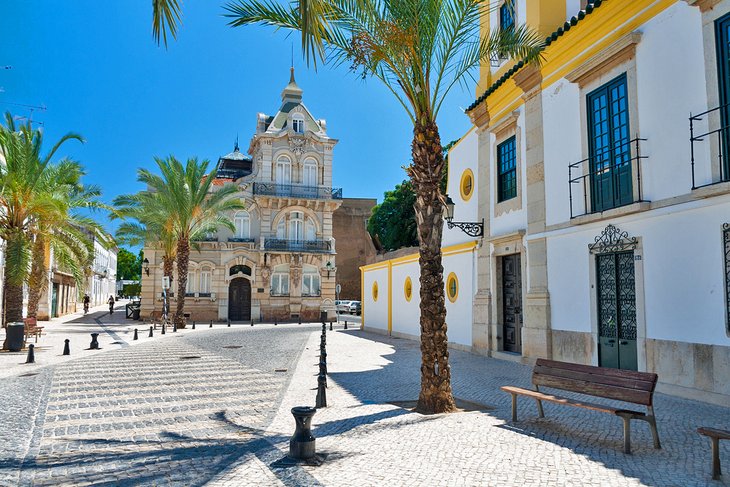
Busy Faro is the capital city of the Algarve, and its international airport is the gateway for many tourists arriving in southern Portugal. As the largest city in the region, Faro accommodates around 50,000 inhabitants and is a modern industrial and manufacturing hub.
It is the Old Town , however, that sightseers will want to visit. Enclosed by sturdy defensive walls, Faro's Cidade Velha sits on Roman and Moorish foundations. The town was badly damaged by the great earthquake of 1755, and what you see today dates mostly from the 18th and 19th centuries.
A warren of cobblestone streets and leafy squares surround the landmark cathedral . Explore farther, and you'll find a number of cafés and restaurants tucked discreetly between rows of tidy houses and artisans' workshops. An excellent museum exhibits treasures unearthed in the area and further afield.
The nearby esplanade harbors a small marina, beyond which lies an expanse of lagoons and wetlands teeming with marine life. This beautiful natural park is also composed of numerous islets and enormous sandbars with their own fabulous beaches , including one named after the city.
- Top-Rated Tourist Attractions in Faro
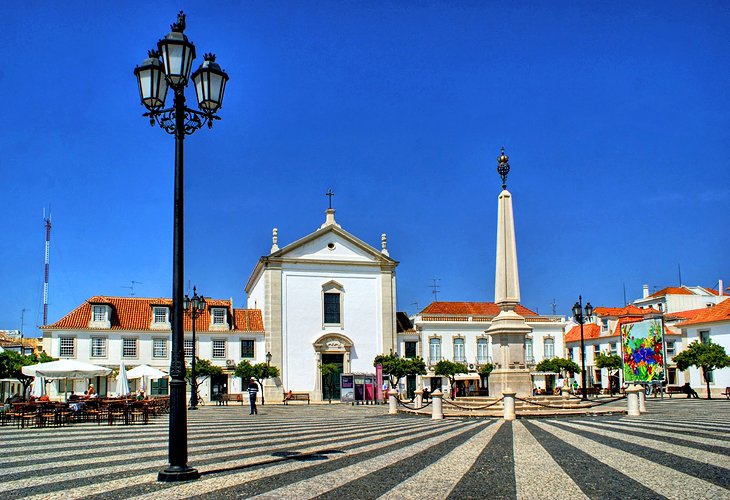
You're as likely to hear Spanish spoken here as Portuguese for this is about as near to Spain as you can get without actually crossing the frontier. Indeed, the shops and markets of Vila Real de Santo António are geared towards visiting Spaniards, but this pleasant border town also has a number of tourist attractions worth investigating.
The excellent Arquivo Histórico Municipal on Avenida da República chronicles the region's almost vanished sardine and tuna canning industry with a spirited interactive exhibition that's free to visit.
The handsome main square, Praça Marques de Pombal , features an eye-catching mosaic sun burst radiating from a central obelisk and is ringed by orange trees and plenty of inviting cafés and restaurants. A fun-filled diversion is to take the ferry from the quay near the marina to the Spanish border town of Ayamonte , with its colorful tapas restaurants and traditionally styled delicatessens. The ferry, which also carries cars, takes around 20 minutes to cross the River Guadiana.
A 10-minute drive north of Vila Real is the spruce village of Castro Marim , which is dominated by an imposing 13th-century castle . Open to the public, its massive ramparts afford fine views over the surrounding coastal Reserva Natural do Sapal nature park.
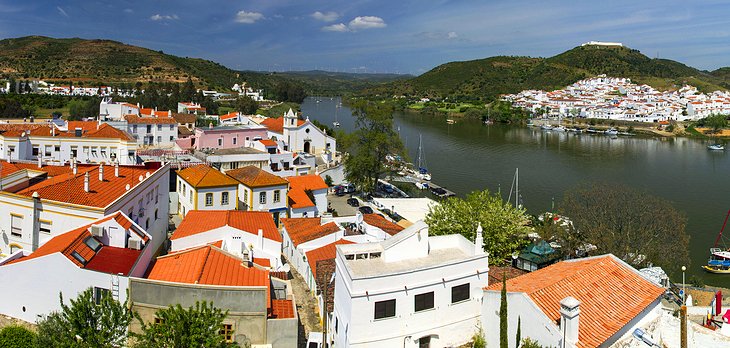
The eastern Algarve's barren and sparsely populated interior is rarely visited, and for the most part remains well off the tourism map. But some 40 kilometers north of Vila Real is the wonderfully scenic border village of Alcoutim.
The drive alone is worth the detour. Rather than using the IC27 dual carriageway, follow the road that hugs the Guadiana River , a broad, meandering waterway that provides a natural border between Spain and Portugal. A smudge of whitewash announces this riverside gem, and the tiny hamlet looks as though it has been created from the imagination of an exceptionally talented artist.
Once a strategic river port controlled in turn by Greeks, Romans, and, notably, Arabs, Alcoutim later played a role as the setting for the peace treaty signed in 1371 between King Fernando I of Portugal and Enrique II of Castile.
It's still a sleepy and tranquil Alcoutim that greets visitors today. The best way to begin sightseeing is by exploring the 14th-century castle (the entrance fee includes access to a small archaeological museum by the main gates). The castle walls afford stunning views of the vicinity and take in the Spanish village of Sanlúcar de Guadiana , set on the opposite bank of the river.
A regular ferry service shuttles between the two villages, but there is an alternative and absolutely exhilarating way to cross the river. On the Spanish side, high above Sanlúcar, is the only cross-border zipline operator in the world. As well as speeding from one country to another, you also cross a timezone - there is a one-hour time difference between Spain and Portugal.
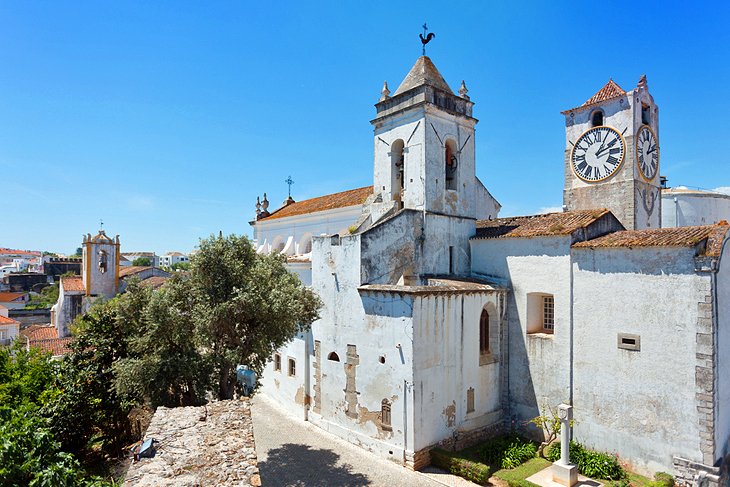
Near the coast in the eastern Algarve, Tavira is one of the region's prettiest towns. Sited on both sides of the broad River Gilão , this is a destination celebrated for its historical legacy, a past shaped by the Romans and later by the Moors, whose settlement by the river was topped by a castle , still visible today.
The hipped roofs that define much of Tavira's architecture are unique to this part of the Algarve. So, too, is the number of churches - 21 in all - that embellish the old town. Straddling the river is an elegant bridge , built in the 17th century on Roman foundations.
An amble along the riverfront is one of the best ways of appreciating Tavira; the palm-lined gardens are flecked with color in the summer months, and a nearby market brims with fresh fruit and vegetables.
Ferries depart from the quay to the Ilha de Tavira , a favorite destination for sun seekers and one of the few islands in the area where camping is permitted. Alternatively, you can join a sightseeing cruise along the Ria Formosa , a beautiful and unspoiled waterway and part of a protected natural park.
- Top-Rated Tourist Attractions in Tavira & Easy Day Trips
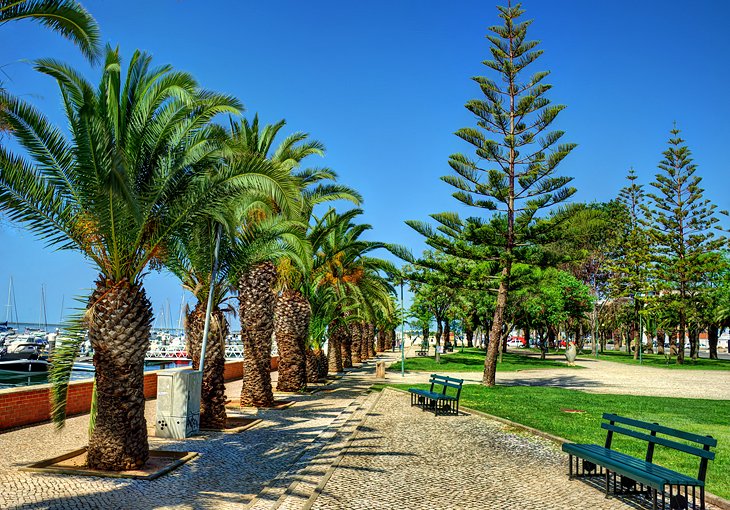
The Algarve's busiest fishing port, Olhão is all about the ocean, and some of the best seafood restaurants in the region are on Avenida da República , the town's vibrant thoroughfare.
Another reason for paying Olhão a call is to browse its incredible harbor front market - the biggest and most animated on the coast. Open at daybreak, the fish market is filled to the gills with an extraordinary array of produce, sleek and silver, and the freshest you're ever likely to taste. Complementing this Atlantic harvest is a rural riot of just-picked fruits and vegetables, a farmer's choice of delicious country fare.
While it radiates a palpable North African atmosphere with its casbah-cluster of whitewashed flat-roofed houses, Olhão is bereft of any major tourist attractions. However, the waterfront town is a great base from which to explore the pristine Parque Natural da Ria Formosa . Visitors can follow a wonderful network of nature trails and discover a wealth of wildlife within its various habitats.
For others, it's Olhão's proximity to the fantastic near-deserted sandbar islands of Armona , Culatra, and Farol that lures them to this particular pocket of Portugal.
- Top-Rated Tourist Attractions in Olhão
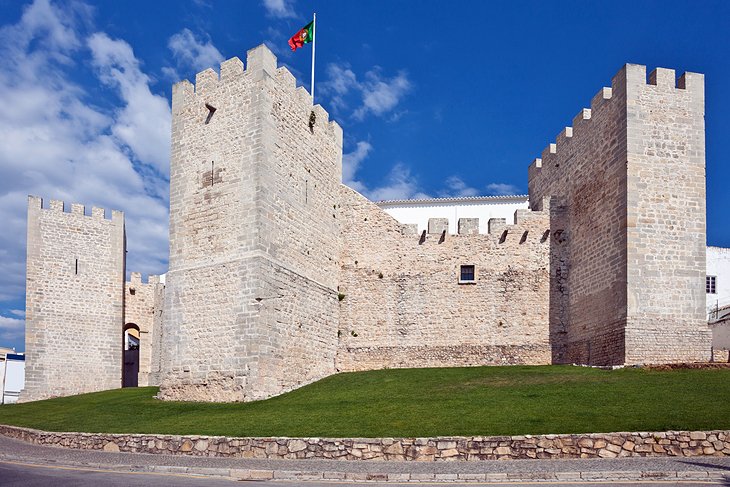
Far from the coast, Loulé is a busy market town of singular character and a fascinating past. The town is best known for its covered fruit and vegetable market , one of the busiest and most entertaining in the Algarve. The sprawling collection of stalls, cabins, and kiosks are arranged in a late 19th-century red-domed building with distinctive horseshoe-shaped windows. On Saturday mornings, the market spills out into the surrounding streets when farmers from outlying districts come to sell their crops.
Loulé has always been a lively commercial hub. The Moors built on Roman foundations to create a thriving center of commerce and constructed a castle here in the 12th century to protect their interests. You can walk the ramparts for fine views over the old town, and there's a small museum set within the grounds.
Arab influence is everywhere. Wander Loulé's backstreets, and you'll discover the ruins of an Islamic bathhouse , the hammam de Al-'Ulyà . In the beautiful 16th-century Capela Nossa Senhora da Conceição , decorated with stunning azulejos tiles, part of the floor reveals the foundations of a 12th-century Moorish house . Explore further, and you'll stumble upon the Igreja Matriz de São Clemente . The church's lofty bell tower originally served as a minaret.
About 25 kilometers northwest of Loulé, Alte is a picturesque village snuggled in the foothills of a mountain range and dotted with flower-filled gardens. To absorb the town's quaint local color, sightseers can stroll along the narrow cobbled streets with their charming white-washed houses or relax at one of the many cafés.
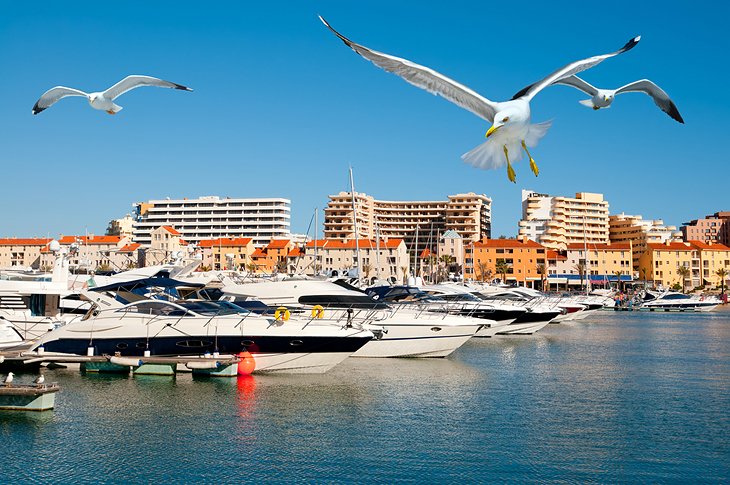
No less than five championship golf courses cluster in and around Vilamoura, making this upmarket coastal resort a favorite with those who want to practice their swing or improve their handicap. Some hotels offer their guests preferential green fees and other inducements such as free shuttle services to and from the clubhouses.
Vilamoura is also synonymous with Portugal's largest marina facility, which offers 825 berths and can accommodate vessels up to 60 meters in length. The esplanade is lined with designer boutiques and pricey restaurants, and is fabulous for people watching, especially in August when Lisbon's jet set tread the boards clad in their designer best.
This is a family-friendly destination with plenty of activities for kids. The boardwalk is the jumping-off point for coastal cruises and other water sports activities, and you can hire pedalos on the sand at Praia da Marina . Elsewhere, the family golf park is an 18-hole mini-golf layout themed around ancient Rome.
Actually, the Romans were here, and the area features the ruins of a 2nd-century villa complex, Museu Cerro da Vila , complete with sunken baths, salt tanks, and striking mosaics.
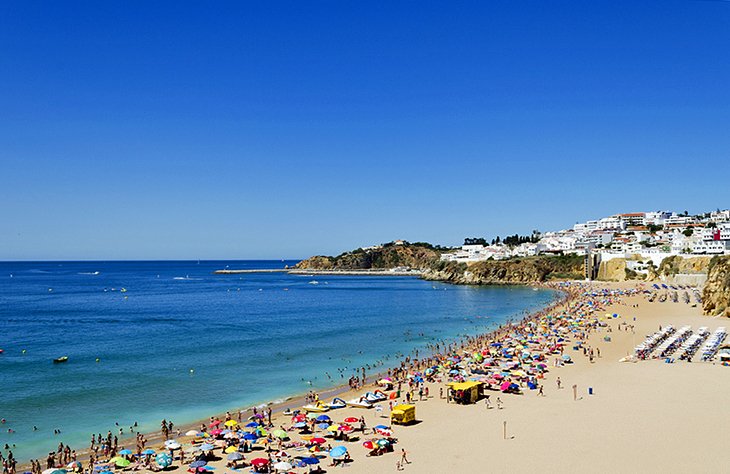
Albufeira is the destination of choice for many Algarve holidaymakers. Its central location on the coast of southern Portugal makes it one of the region's most accessible resorts, and it's a favorite with tourists from across Europe and beyond.
Set on sandstone cliffs above a wide sandy bay, the Albufeira of old was once a quiet fishing village, nothing more than a cluster of whitewashed cottages, a chapel, and a church. Step back further, and it was the Romans who built a castle here, strengthened later by the Moors .
Little remains of their presence, but what Albufeira lacks in historical interest it more than makes up for with its animated spirit and vacation-time atmosphere. The resort's neon-lit streets illuminate a plethora of hotels, cafés, restaurants, and entertainment venues. Top-notch leisure facilities exude an all-round appeal, and Albufeira is often the preferred choice of families.
But the destination's biggest crowd-puller is its beaches . Some of the best stretches of sand in the Algarve are within walking distance of the resort, spectacular cliff-backed coves lapped by warm, shallow water. This is why Albufeira is the tourist capital of the Algarve.
- Top-Rated Tourist Attractions in Albufeira
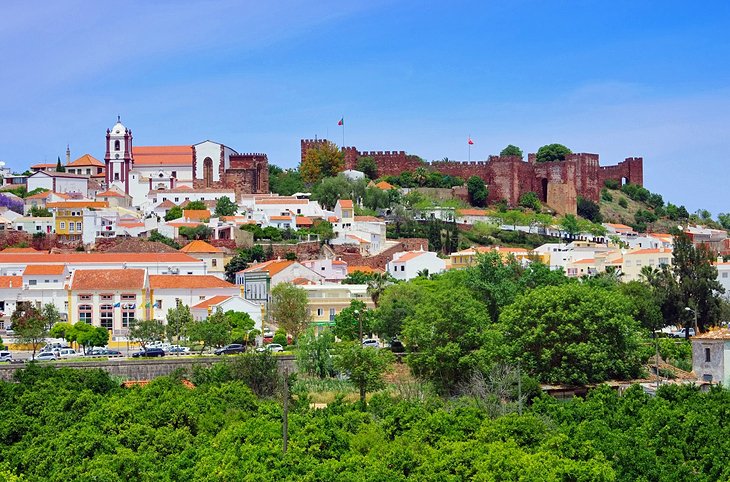
Lying across a hill overlooking a fertile valley embroidered with orange groves, olive trees, and vineyards, Silves is one of the most scenic towns in the Algarve. The landscape, however, is dominated by the town's splendid castle - the grandest monument to Islamic rule in the region.
Built by the Moors in the 11th century on Roman foundations, the castle's dramatic profile is enhanced by its copper-red walls, sections of which extend into the town below. This was Xelb , the Moorish capital of the al-Gharb ("the west"). Another fine example of Islamic presence can be seen in the Museu Arqueológico , where the star exhibit is an impressive Arab water cistern with an 18-meter-deep well.
Silves is worth exploring at leisure. Downhill from the fortress is the Sé (cathedral), built between 1242 and 1577 on the site of Xelb's Grand Mosque. Opposite is the 16th-century Igreja da Misericórdia , replete with a fine Manueline side door.
The town itself is delightful, especially the area along the riverfront, which is lined with a small market and some excellent restaurants. Cruise boats from Portimão tie up here near the old bridge.
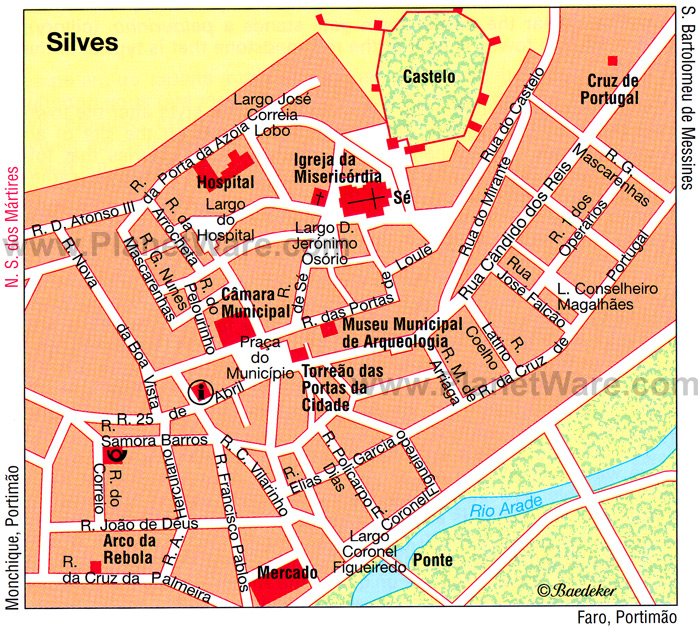
Historically associated with the Algarve's once thriving cannery industry, Portimão has successfully reinvented itself as a destination for tourists who prefer to stay in an urban setting yet remain within shouting distance of a beach resort environment.
The region's second largest city, Portimão enjoys an enviable location overlooking the banks of the River Arade . Endowed with an award-winning museum and a noted theater complex, the city is basking in its reputation as one of the region's liveliest cultural hubs. It's also an international port of call for luxury cruise ships en route to the Mediterranean.
An eclectic choice of tourist attractions and amenities is close at hand. The award-winning Museu de Portimão is one of the region's most engaging visitor attractions . Housed in a former cannery building, the museum chronicles the history of the town's fishing and canning traditions using state-of-the-art interactive effects. Also on display are rare artifacts from pre-historic, Roman, and Islamic periods.
Offshore, a fabulous artificial reef - the first in Portugal - attracts diving enthusiasts from around the world. Inland meanwhile, a Formula 1-standard racetrack hosts sports car championships and other high-profile competitions.
A modern marina set at the mouth of the estuary is within walking distance of one of the Algarve's most famous beaches, Praia da Rocha - a beautiful and alluring stretch of golden sand that fronts the lively tourist resort of the same name.
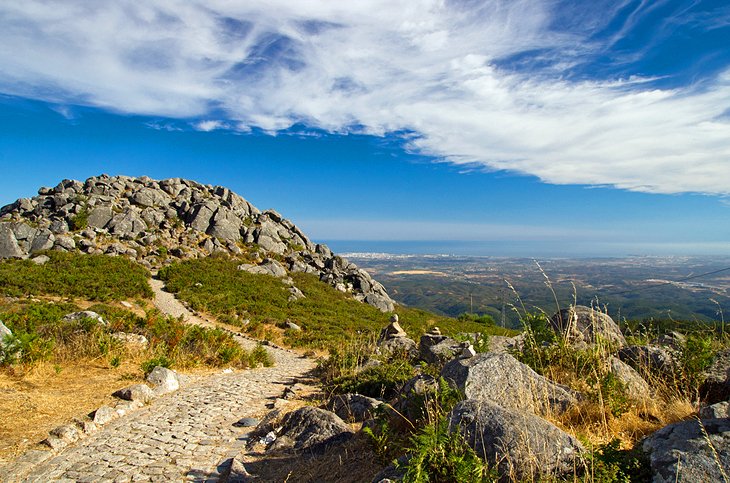
Offering an alternative to the Algarve beach scene is the Serra de Monchique, a rolling mountain range that adds a dramatic perspective to the region's western countryside. Skirted by fragrant meadows of wildflowers, Monchique's slopes bristle with chestnut and eucalyptus, the verdant habitat sustaining an abundance of wildlife.
A network of nature trails snake through the shady woodland; one leads all the way to Fóia , at 900 meters the highest point in the Algarve. On a clear day, the spectacular panorama embraces the region's entire western landmass including Lagos and Sagres, and the Atlantic Ocean beyond.
The pleasant hill town of Monchique is an excellent base from which to explore the area and is noted for its traditional handicrafts: look out for the cadeiras de tesoura , the x-shaped folding wooden chairs based on an ancient Roman design.
And it's the Romans who first took advantage of the warm, curative waters that nourish Caldas de Monchique , a charming spa tucked away in a wooded ravine in the foothills of the Serra. Set around a cobbled square furnished with a restaurant, café-art gallery, and bed and breakfast accommodation, the modern thermal spa offers a tantalizing menu of therapeutic treatments and rituals.
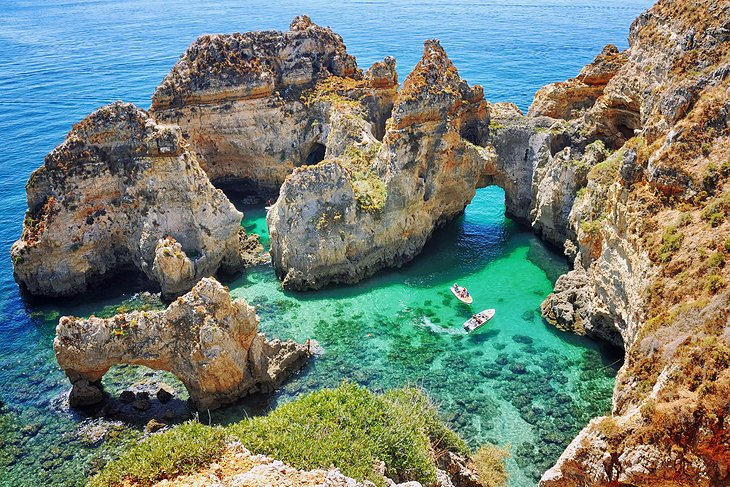
Lagos is the western Algarve's liveliest resort town. It's also of great historical significance. Prince Henry the Navigator launched Portugal's Age of Discovery from Lagos in the 15th century, and the nobleman later became governor of the Algarve. His extraordinary vision, and the bravery of the intrepid explorers who set sail for uncharted waters, helped place Portugal on the world map, and Lagos is proud of its seafaring heritage.
The town's medieval collection of castle walls, graceful churches, and stout sea defenses always captures the imagination of visitors, but it's the coastline that lures holidaymakers. A stunning run of cliffs, caves, and grottoes provide the backdrop to some of the most scenic beaches in the Algarve. A series of spectacular ochre-splashed rock formations contrasts with sparkling azure waters, and the best way to appreciate this idyllic environment is by boat - Lagos's extensive tourist attractions and activities extend to sightseeing cruises and dolphin safaris .
Shopping here is good and inexpensive, and a wide choice of cafés and restaurants provide plenty of culinary distraction.
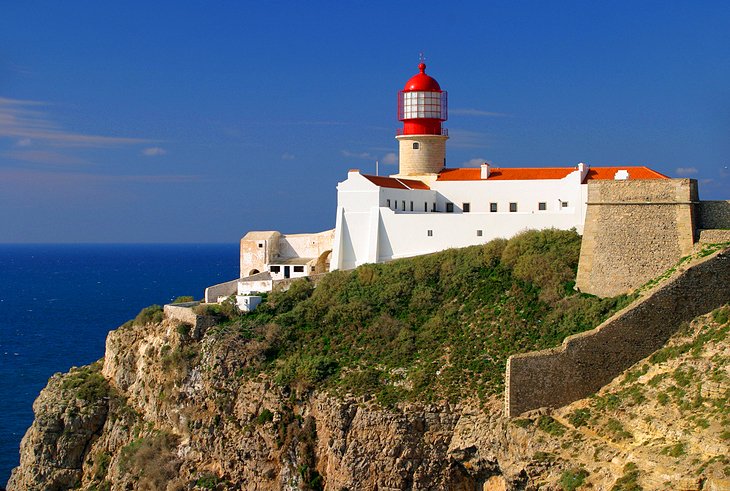
Around 120 kilometers west of Faro, Sagres, continental Europe's southwesternmost community, basks in glorious isolation and is the Algarve's least developed coastal resort. It was here that Prince Henry the Navigator (1394-1460) is believed to have established a school of navigation on a windswept promontory near the town, thus heralding Portugal's remarkable period of maritime exploration.
The chunky walled Fortaleza seen today dates from the 17th-century, but inside the walls, you'll see a giant pebble wind compass, the Rosa dos Ventos , said to have been used by Henry. The adjacent 15th-century chapel of Nossa Senhora da Graça was certainly built on his orders.
Ancient Greek chroniclers described nearby Cabo de São Vicente as "the end of the inhabited earth," such is the austerity of this stark, windblown cape. The lighthouse serves as a navigational beacon, not just for shipping, but also for thousands of migrating birds, and there's a bird-watching festival here every October.
The town itself wakes up in summer to welcome a predominantly young crowd drawn to inexpensive accommodation, simple restaurants, and proximity to some truly fantastic beaches.
Sagres is Europe's surfing capital , and the destination hosts legs of the World Surfing Championships.
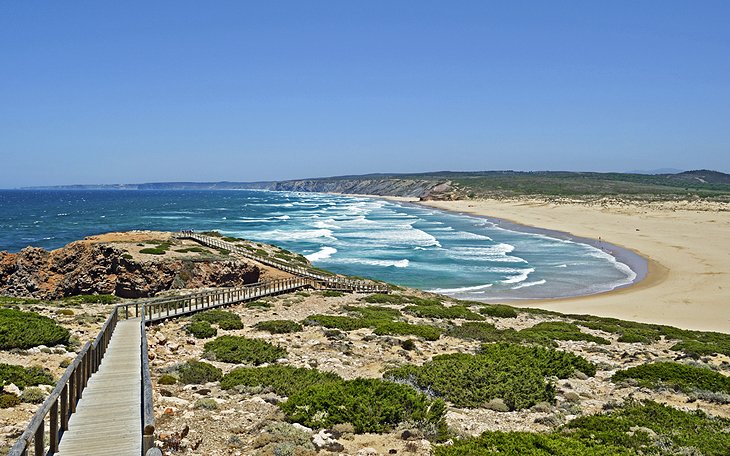
Precipitous sea cliffs, wide-open beaches, and a restless Atlantic Ocean define the character of the Algarve's west coast. Devoid of development, this remote and untamed stretch of coastline is the preserve of the more spirited traveler. Surfers worship the region, drawn by the outstanding rollers that crash onto Praia da Bordeira , Praia do Amado , Praia da Arrifana, and other sandy arenas. Surf schools abound, with many offering free transfers from Faro airport.
Traditional villages untouched by tourism dot the landscape, places like Carrapateira and Odeceixe . Accommodation is scarce, and very often it's the humble campervan that prevails. Unfussy restaurants serve succulent grilled fish and other delicious seafood dishes.
The entire region falls within the boundaries of the Parque Natural do Sudoeste Alentejano e Costa Vicentina , and you can follow a number of footpaths, both inland and along the coast, that showcase its wild and rugged scenery. For a worthwhile cultural diversion, head for the lively town of Aljezur and visit the ruins of an 11th-century Moorish castle , set on a hill with uninterrupted views of the valley below.
Numerous Algarve tours and activity options are available on land and sea, many running throughout the year. These organized tours include expert guides, so you can learn more about the destination while you see the sights.
- Sightseeing by Boat: A popular maritime pursuit is the Kayak and Snorkel Trip in Lagos , a guided excursion along the Atlantic coast. This active three-hour tour delves into sea caves and ancient grottoes for a different perspective of the Algarve. If you prefer not to paddle, the Ria Formosa Natural Park 4 Islands Boat Trip is an excellent choice. Departing Faro, this 4.5-hour tour is conducted at a leisurely pace aboard a 12-person catamaran through one of the most beautiful marine reserves in Europe.
- Sightseeing by Bike: Take a four-hour cycle through the beautiful countryside, past small towns, farmland, and coastal scenery. This Small-group Bike Tour can be tailored to suit your fitness level.
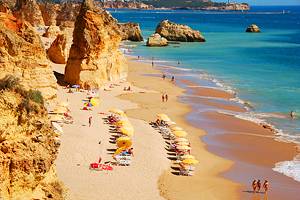
To fully appreciate the Algarve's unique allure, study our Portugal itineraries page for ideas on where to go and what to see . Top tourist attractions in the region include a number of historic castles and world-class golf courses . Several of Portugal's most modern and luxurious beach resorts are found here and of course, the Algarve is renowned for its wide choice of fantastically picturesque beaches .
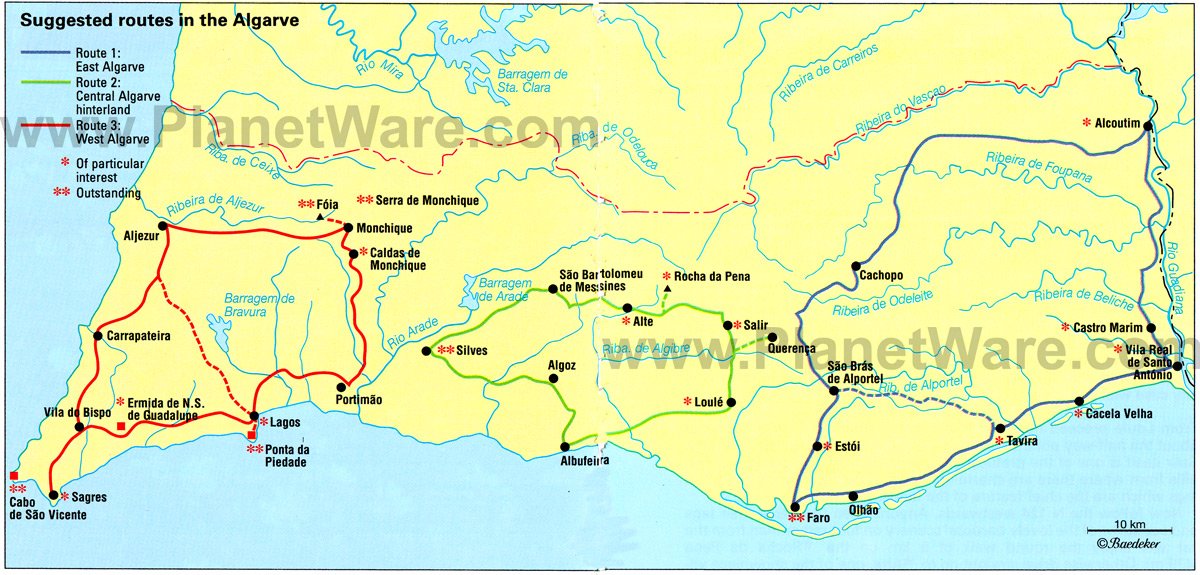
More on Portugal
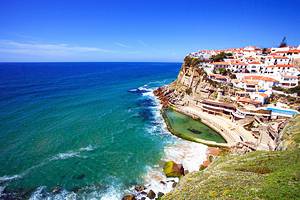
Visit Algarve: The ultimate vacation guide
- Share on Facebook
- Share on LinkedIn
- Email this Page
Visit Portugal
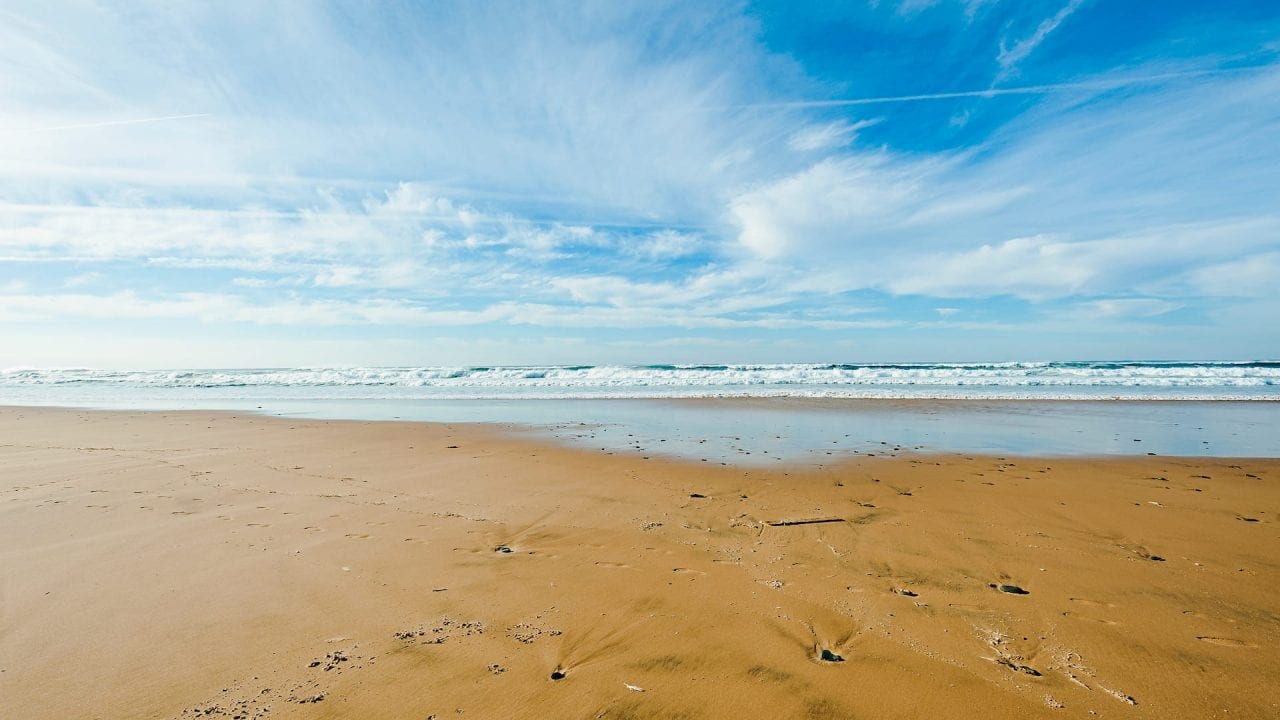
Do you want to visit the Algarve ? Read on to find out why this gem of Portugal is so beloved — we’ll even share some of our favorite secret spots!
- Why visit the Algarve?
The Algarve is considered by many to be the “Florida of Europe” — sunny, located in the southern part of Portugal, and relatively inexpensive as compared to other beach destinations. Plus, it’s safe and very relaxing.
Getting there is easy
Every year, thousands of tourists visit Algarve, coming from the UK, US, Germany, France, Norway, Sweden, and many other countries. The majority of visitors fly directly into the Algarve Airport (Faro Airport). However, given the excellent web of motorways in Portugal, you can reach the Algarve in about two hours from Lisbon by car — so the Lisbon airport is always a good option. Want to take a spin around the Algarve? Here’s how to rent a car in Portugal .
Sun and sand in the South
As the “Florida of Europe,” the Algarve’s weather is even better than in the rest of the country — which is pretty fantastic to begin with . But with 300 days of sunshine per year, it’s no wonder the Algarve is a prime destination for people moving to Portugal!
The Algarve coastline
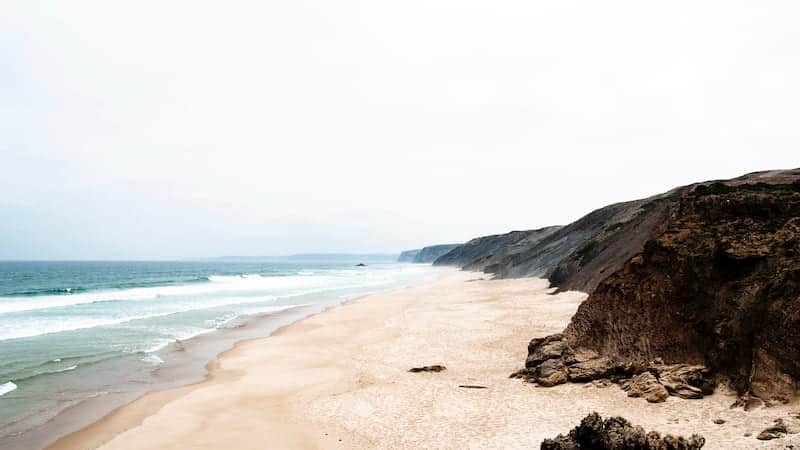
The Algarve is a vacationer’s paradise
If you’re planning a visit to Portugal, put the Algarve on your list. Not sure where to start? One fantastic route is to begin in the easternmost region of the Algarve, near Spain, and drive west. From there, honestly, you could stop at any beach along the way, and we guarantee it’ll be one of the most beautiful you’ve ever seen. Portugal’s good like that. Vacation planners will also want to check out our top 7 holiday villages in the Algarve — to see some of our favorite places down south.
The water is calm, inviting, and, usually warm
In addition to sun and sand, there is the ocean — almost always calm and inviting. But the best part? The temperature! The Algarve’s seaside is sheltered from some of the colder Atlantic waters, making for warmer temps overall.
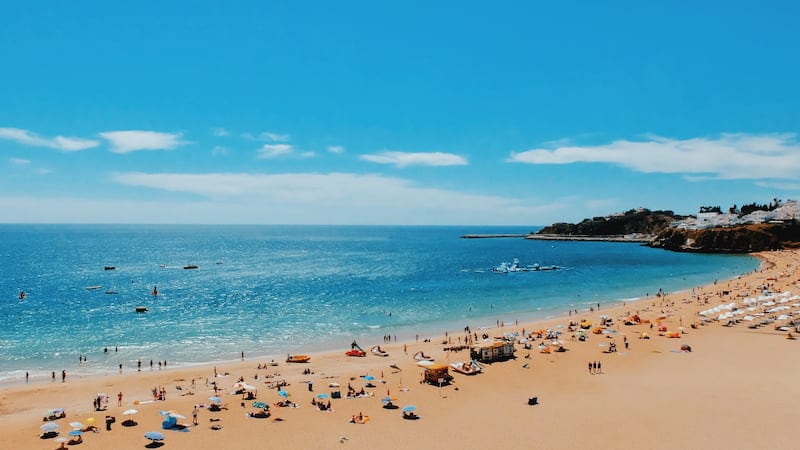
The Algarve is safe, relaxing, and has a bit of everything
Safety always plays a significant role when we’re away from home, and the Algarve is one of the safest areas in the world. Plus, everything happens at a slower pace in the Algarve. From strolling among shops to settling in for a late dinner, nobody is looking at the clock. This mellow mindset lets visitors to the Algarve really let down their hair and leave the usual stresses of day-to-day life behind. Want a more active vacation? There are tons of activities in the Algarve, whether you’re traveling solo or with your family:
- Cave exploring
- Sunbathing at the beach
- Water sports
There’s a lot more going on, of course. Take a look at GetYourGuide to see tours and activities in the Algarve. Planning a visit? Perfect. You can also book experiences in advance.
The Algarve is easy on your wallet
Compared to other beach vacations, a trip to the Algarve can get you more for your money, making it an excellent option for anyone craving sun and sand while still living on a budget. Overall, Portugal can feel less expensive than your hometown (depending on where you live, of course). Find out more about the cost of living in Portugal .
But you can go for luxury, too
If you want to pull out all the stops, we’ve got good news: The Algarve hosts several luxurious resorts that include privileged beach access, private swimming pools, spas, golf courses, and more. According to Booking.com users , these are some of the top luxury destinations in the Algarve:
- Pine Cliffs Village & Golf Suites
- EPIC SANA Algarve Hotel
- Tivoli Carvoeiro
With options like these, why not splurge a little?
- Best beaches in the Algarve
Rejoice, beach lovers! The Algarve is home to more than 150 beaches. Some of the most beautiful include:
- Praia da Falésia in Albufeira
- Praia de Tavira, in Tavira
- Praia da Marinha in Lagoa
- Praia de Odeceixe in Odeceixe
- Meia Praia in Lagos
- Praia de Benagil near Lagoa
- Praia de Cacela Velha near Tavira
- Praia da Arrifana in Aljezur
- Praia da Rocha in Portimão
- Praia da Luz in Luz
Here’s the scoop on some of our favorites:
Praia da Rocha
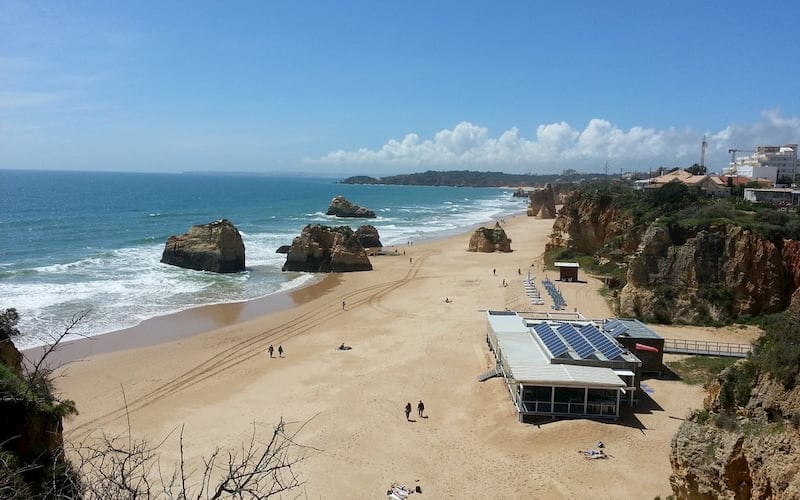
Praia da Rocha is close to the city of Portimão. With its 1.5 km (1 mi) of shoreline, it is one of the most popular beaches in the Algarve (even, perhaps, in Portugal). Its name, Rocha, means rock — and comes from the giant rocks jutting up through the sand along the waterline. Is Portimão calling to you? Here’s an article about spending holidays in Portimão, Portugal .
Praia de Faro
A little to the east, about five minutes from Faro (the central city of the Algarve), you’ll find the Praia de Faro. Technically, it is a narrow, 5 km (3.1 mi) island, connected to the city by a bridge through the natural park of Ria Formosa. Here, you’ll find a main road that parallels the beach. On one side of the road, you have the ocean; on the other, you’ll find an array of restaurants, bars, and vacation rentals. Find out more about visiting Faro here.
Ilha de Tavira
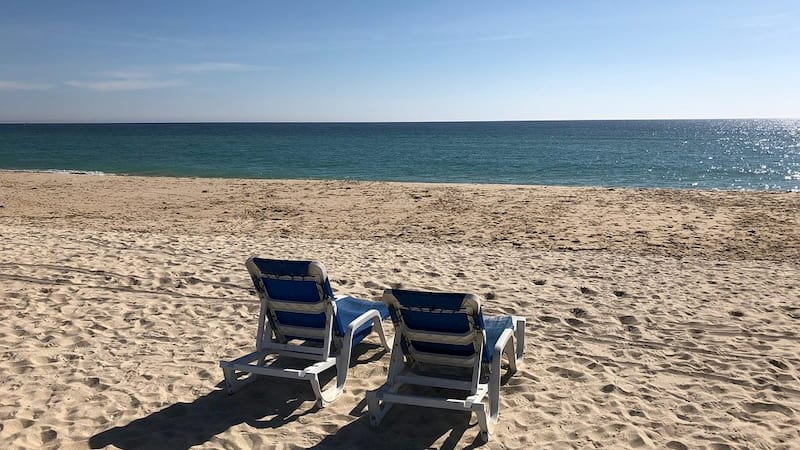
Tavira’s beach is accessed mainly by boat. This means getting there takes a tiny bit of planning, but it’s so worth it. We highly recommend any of the four beaches on the island of Tavira as a destination, so you can experience the magic for yourself. As with other beaches in the Algarve, Tavira has calm, warm water and the beach is clean and tranquil.
Benagil Beach
Benagil Beach is something special. It’s not an accident that many call it the best beach in the Algarve — but even with this high praise, you might have never heard of it. Trust us. It’s a bit hard to reach even with a car, but once you get there — wow.
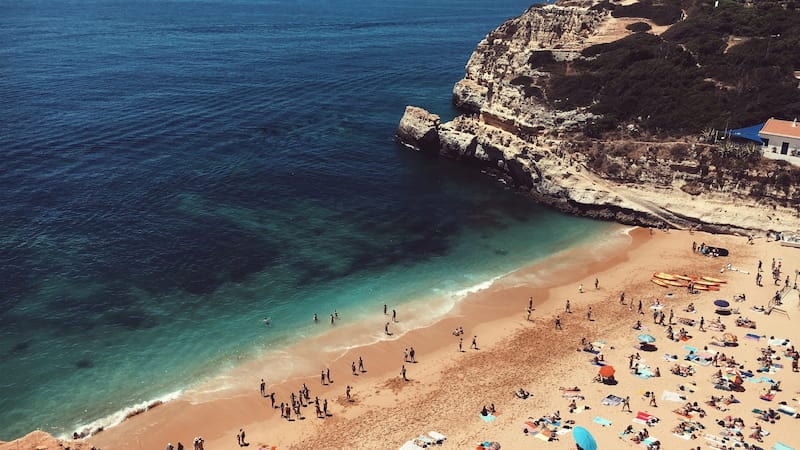
You’ll take enough pictures to fill your Instagram account for a year. To access the beach, you need to go through a “tunnel” inside a huge rock — perhaps not for those who tend toward claustrophobia. However, once inside the beach area, you’re surrounded by a curtain of rocks, so it’s unlikely you’ll feel any wind at all. There’s also a cliff where you might see the most adventurous visitors jumping into the water. Amazing, right? There are many other beautiful beaches in the Algarve, of course. It all depends on which lovely town you decide to stay in for your Algarve vacation. Explore your options below.
- Where to stay in the Algarve
Choosing the best place to stay in the Algarve is not an easy task. To help narrow it down, we’ve identified some of the most popular Algarve cities for tourists visiting Portugal:
- Quinta do Lago
- Praia da Luz
Albufeira is usually very popular with Brits during summer (many even choose Albufeira as a place to buy property in Portugal ). Even so, you’ll still be able to have an authentic Portuguese experience — you just might have to go off the beaten path a bit to find it.
Holidays in Vilamoura
Vilamoura is a resort area known for its golf courses, its famous beach Praia da Falésia, casino, bars, clubs, a wide variety of restaurants, and more.
Visting Quarteira
Near Vilamoura is a small village called Quarteira, which also has its own beach, restaurants, and nightlife. The advantage to planning a vacation in Quarteira is that you can usually find accommodations for slightly less money. Some visitors opt to rent a hotel in Quarteira and visit Vilamoura during the day.
Things to do in Vilamoura
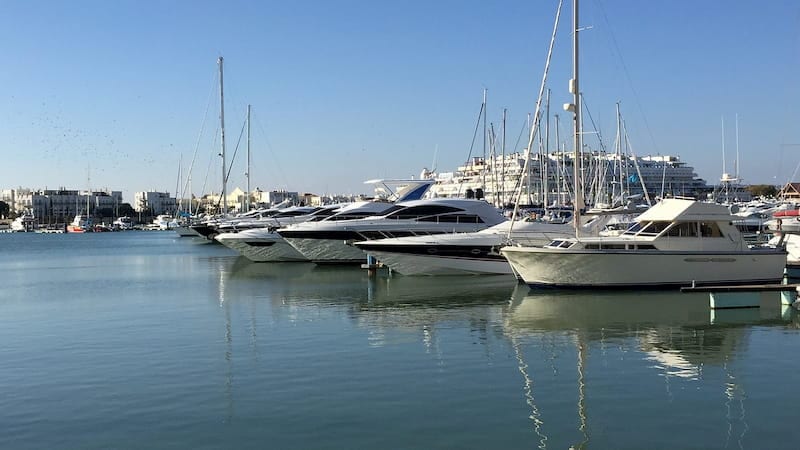
It’s a lively village with something for everyone. At the end of the day in the Algarve paradise, many people enjoy an evening walk around the Vilamoura Marina , stopping for a drink or an ice cream, or just strolling around to check out all the fancy boats. It’s a great way to spend an evening in Portugal. But what about during the day?
Beaches in Vilamoura
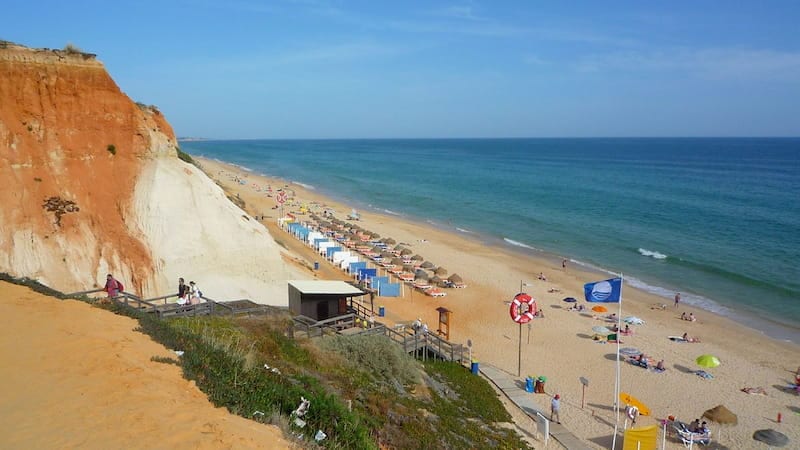
The Praia da Falésia is the most popular beach, as already mentioned — but there are several other impressive choices, including:
- Praia da Marina (you can reach this one on foot)
- Praia da Quarteira
- Praia dos Tomates
- Old Well Beach
For most of these, of course, you’ll need some means of transportation — ideally a car. Learn about renting a car in Portugal .
Costs of holidays in Vilamoura
Vilamoura is not cheap when compared to other places in the Algarve. Maybe not as expensive as spending holidays in Italy, but certainly not the same as spending 14 days in Monte Gordo (which is still in the Algarve). It is, however, an excellent place for a group of friends or families. Sound like your kind of place? Take a look at the top 3 hotels in Vilamoura .
Holidays in Albufeira
What to say about Albufeira? For many years it’s has been the number one choice of British who wish to retire in Portugal or visit Portugal .
Albufeira Strip and nightlife
It’s known for it’s famous Albufeira strip and it’s lively nightlife. It’s the place to go if you’re someone who enjoys loud music, bars in every corner, cheap drinks, and dancing until morning.
But it’s also a place for families
There’s also a place for families in Albufeira. Albufeira is quite a big city (in the scale of the Algarve, I mean), and there are many other areas to take a drink, have an ice-cream, enjoy great food in great restaurants and much more. It’s more affordable than Vilamoura, especially if you compare it in terms of accommodation, as you can see here on booking . Prices vary as there, but you can get a double room in a hotel for 2pax for 165€, in August.
Beaches in Albufeira
And let’s not forget that there are many beaches around Albufeira, especially if you have the chance to rent a car.
- Praia da Oura
- Praia de Albufeira
- Praia do Peneco
- Praia da Baleeira
We’ve also written an article about the Top 7 Holiday Villages in the Algarve that might be useful to read.
Holidays in Quinta do Lago
Quinta do Lago stands out from all other places in the Algarve. Everything in Quinta do Lago is luxurious.
- The gardens are beautiful
- Hotels are luxurious
- Golf courses are huge
- The roads wide
- Service is excellent
- Access to the beach is easy
Quinta do Lago is very famous for hosting celebrities and its’ golf courses.
Accommodation in Quinta do Lago
They call it the resort of the rich. It’s tough to find accommodation for less than 350€ night for a couple in the high season in Portugal.
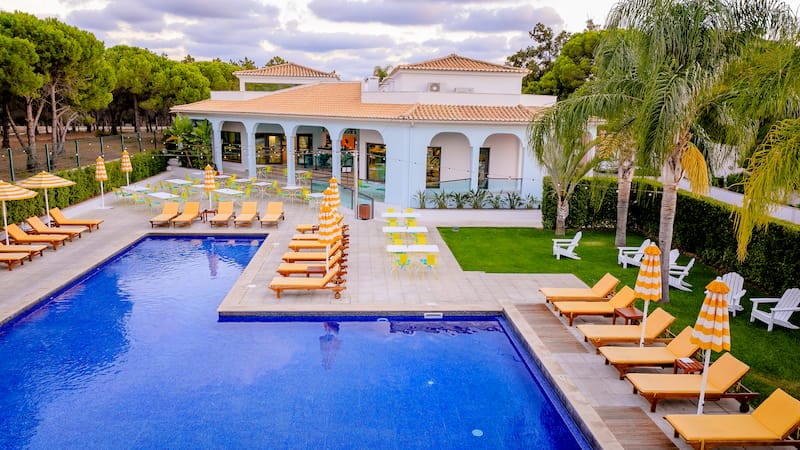
- Holidays in Lagos
Lagos is a small size city but very beautiful and with a distinguished history as it was one of the main ports for Portuguese Maritime Discoveries ( source ).
Beaches in Lagos
There are several beaches near Lagos:
- Praia D.Ana
- Praia do Camilo
- Praia dos Pinheiros
- Praia Porto de Mós
Other things to do in Lagos
Lagos is a very vibrant city, especially during summer, with plenty of bars and clubs. So there’s no lack of fun, that’s for sure. It’s also delightful to walk in the historic city center or the marina. If by chance you get to visit or stay in Lagos, I’d advise doing a day trip to Sagres in Portugal .
Accommodation in Lagos
Prices are similar to staying in Albufeira. You can expect to spend between 150 to 250€ for 2pax if you want to stay in a 4-star hotel. If you are flexible and prefer to cook your meals and rent an apartment, you might save some money, and maybe find some options starting at 100€. There’s also luxurious accommodation in Lagos, but in this case, prices can rise to 400€ per night. See more options for Lagos on booking .
Holidays in Carvoeiro
Carvoeiro is yet another southern Portuguese beach resort. Formerly a fishing village, today Carvoeiro attracts thousands of families who’re looking to retire in Portugal. With less than 2,721 habitats, this village transforms itself during summer.
Things to do in Carvoeiro
Relax. Relax And did I mentioned, relax? Yes, this is the perfect place in the Algarve to go if you’re looking for a peaceful place to enjoy your holidays. There are some other things you can do, such as:
- Catamaran Cruise Trip to the Benagil Caves
- Hike the steep hills and sheer cliffs of the coastline
- Go to the Zoomarine
- Day trip to Silves ( historic village)
See more ideas for your holidays in the Algarve .
Accommodation in the Algarve
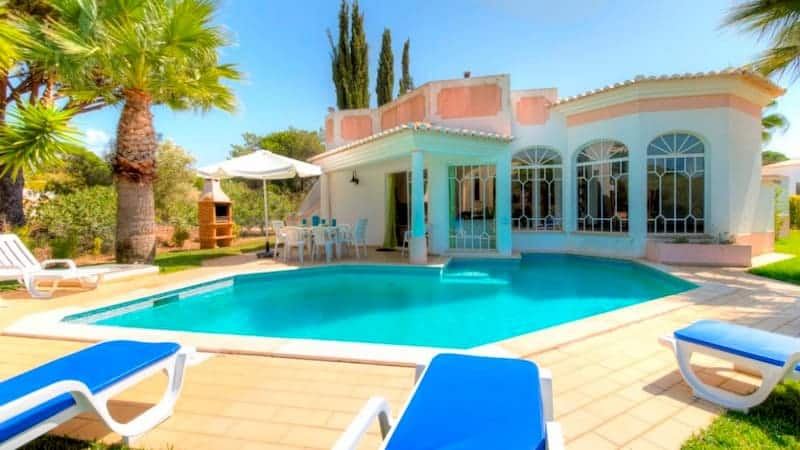
Ok, we have talked about a few things so far, the cities, the beaches and why it’s worth visiting the Algarve. It’s time to talk about:
- How much you can expect to spend
- The best accommodation in the Algarve
Prices for accommodation in the Algarve
In average rates vary according to the season. See here more information about the weather in The Algarve .
During Spring and Autumn
Prices for a 2pax bedroom in a village, such as a Praia da Rocha, can cost on average, 50€ Exceptions: are national holidays
During winter:
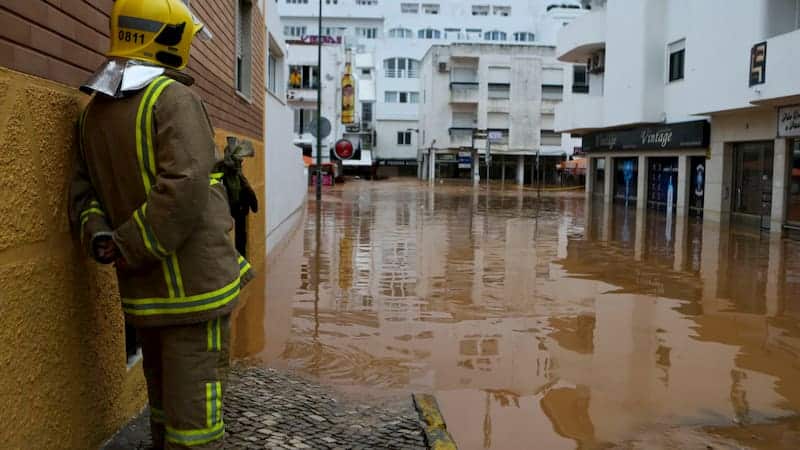
Prices can go as low as 35 for 2pax bedroom, again in Praia da Rocha. Exceptions: Christmas in Portugal and New Years’ Eve
During Summer
Prices go up from June to August where they reach their peak. The same room that costed 35€ can now cost 150€. In September, prices start to go slowly down.
Is accommodation expensive in the Algarve?
Overall I’d say no. Of course, there are different prices for different types of accommodation. Choosing a villa in Quinta do Lago is going to cost you much more than a simple room in an apartment Praia da Rocha. It might also be useful to see what we have written about renting an apartment in the Algarve .
Best accommodation in the Algarve
Four seasons country club, quinta do lago.
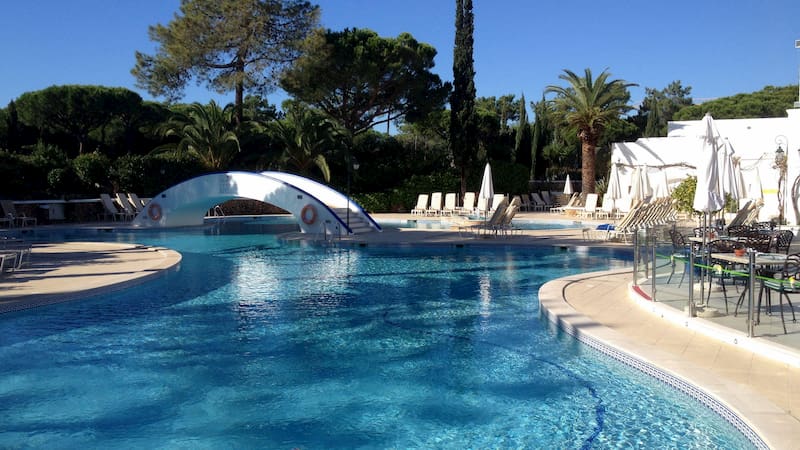
If you are interested in the best of the best, no matter the price, then you should check out the Four Seasons Country Club in the Quinta do Lago. It is considered to be one of the best hotels in Europe. Its proximity to the beaches, services, golf and tennis courts, and their friendly staff make it the tourists’ favorite.
Vila Joya, Albufeira
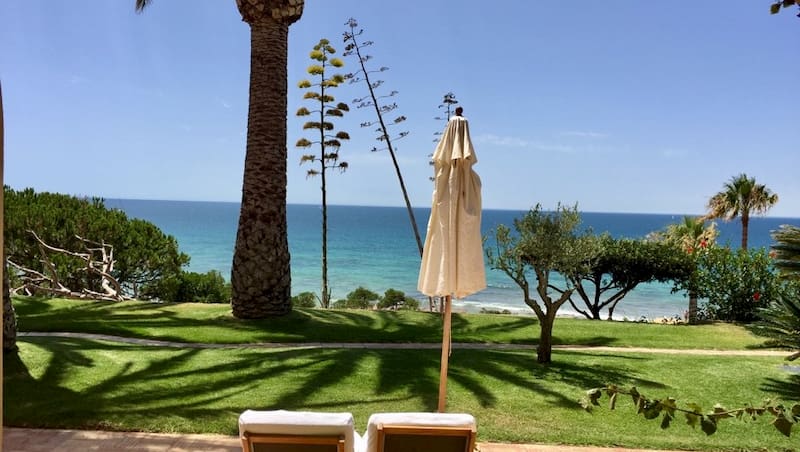
Vila Joya , located near the city of Albufeira, is known not only for its excellent services but also for its restaurant. Many tourists consider the hotel to have one of the best restaurants in the world. Its location enables you to enjoy the beaches nearby and see the beautiful sunset from your room.
Salema Beach Village, Salema
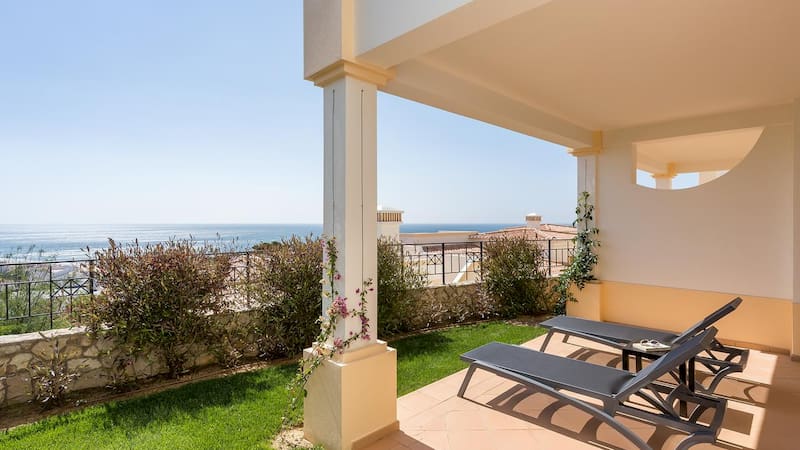
Another excellent option is Salema Beach Village in Salema, between Lagos and Sagres. Salema is a perfect place to stay if you are traveling with your family or a group of friends. They offer several services, but one of the most appreciated is the shuttle service to the beach and back. One thing that characterizes Salema Beach Village, according to those who stayed and enjoyed their services, is the concern with their client’s well-being and experience. If you would like to know more about visiting the Algarve, subscribe to this exclusive mailing list, that only tourists interested in Portugal have access.
Advice choosing accommodation in Algarve
There are many other options, and you can see them all here on the main front page of booking , and search according to hotels (or different kinds of accommodations best reviewed) or according to the aspects that are important to you. Our main advice is: do it in advance. People start planning their family holidays in the Algarve in January, which means the best opportunities will be gone.
What’s the real cost of spending holidays in the Algarve?
So to sum up costs, I’d say that for the average family of four, two parents, two children, the costs would be as follows:
- accommodation: 250 euros per night
- Food: 150 euros per day (assuming you have one meal out)
- Rent a car: 40 euros per day + 50€ for the tank (for one week)
- Fun and activities: 350€ per week
- Calling a Taxi or Uber: 30 euros per week
- Flights 250€ come and go (if bought in advance)
Total: 4940€ So you’d need at least 4940€ to spend a decent time in the Algarve, for 4pax. From there, the price can decrease if you cook at home, if you don’t do activities, or increase if you want a better accommodation and more comfort. Reading our article about the cost of living in Portugal might help plan your expenses. Ok, we finally get to the “tasty” part of the Algarve, food!
- Best Food in the Algarve
The Portuguese food is full of fresh fish and seafood , and that’s even more prominent in the Algarve, where the ingredients are so readily available each day. It is difficult for us to pick some dishes you should ask for when visiting the Algarve. The offer is impressive, and the most straightforward answer would be: “Try them all!”.
Eating fish in the Algarve
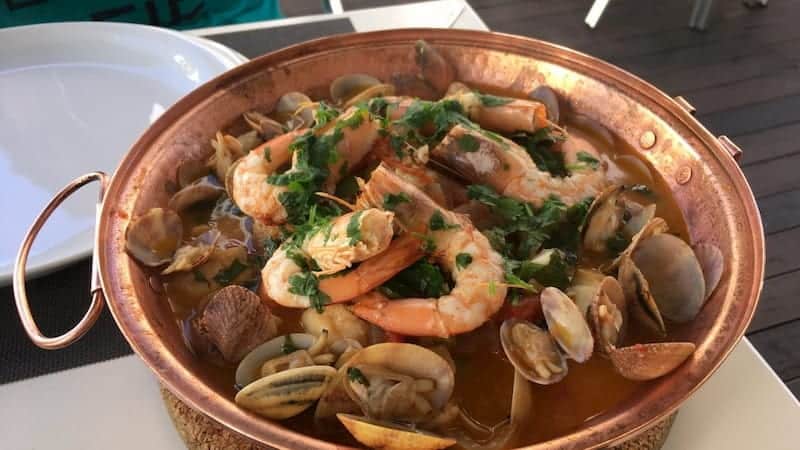
However, if we would have to choose, then you should ask for ‘ clams in Cataplana ‘ or ‘ Algarvian-style conquilhas ‘ for starters. The soup could be any fish soup. The monkfish rice (“ Arroz de tamboril “) is an excellent choice as a main course. Let’s face it, and you can’t go wrong with seafood.
Eating chicken
You can also try to find Frango da Guia (similar to Nandos ). Although Frango da Guia is originally from the small village “Guia” near Albufeira, it quickly spread throughout Algarve, and you can find it in several restaurants.
Other options
There’s plenty to taste in the Algarve, and that includes:
- Traditional Portuguese cuisine
- Chinese restaurants
- Japanese restaurants
- Italian restaurants
- Churrascarias (bbq spots)
Algarve Desserts

And, if you still have some room for dessert, try the egg threads (“fios de ovos”), carob pie, or almond and chocolate cake. Oh well there’s plenty of options as you can see here in this Portuguese desserts website (not in English) If you are wondering if there are any places you should stop by and eat some excellent food, we have some ideas for you.
- Best Restaurants in the Algarve
Vivendo Restaurant, Meia Praia, Lagos Vivendo Restaurant is one of the best surprises people encounter when visiting the Algarve. Although it is considered to be a little hidden and could be a little heavy on the wallet, their quality and attention to detail will undoubtedly add something special to your experiences in the Algarve. Make sure to try it out. Restaurant The Cockerel, Albufeira If you are interested in something reasonable and local, give Restaurante The Cockerel in Albufeira a try. Their excellent food, desserts, and service will impress you, we guarantee it. If you enjoy eating fish or seafood, you can’t miss this. If, on the other hand, you wish to eat some good meat, try out their barbecue dish. Fábrica Velha Pastelaria e Padaria, Carvoeiro Fábrica Velha is one of the best beach hotels in the Algarve , but it is considered one of the most beautiful places to eat in the Algarve. If you would like to eat some traditional national pastry, give this café a try. The staff’s friendliness and the vibe of the place are guaranteed to impress you and to give this place a stable position on your “go to list” whenever you return to the Algarve.
- How to get to the Algarve
There are essentially four ways to get to the Algarve:
Reaching Algarve by airplane
- Flying to Faro: this is the ideal scenario.
- Flying to Lisbon or Porto Airport and then taking a secondary flight/train.
Reaching Algarve by train or bus
If you’re already in Portugal or you live in Portugal , using a public train ( cp.pt ) might be an option. Tickets from Lisbon start at 25€ and it takes 2.5 hours to get you to Albufeira. From there you can either take a transfer or a regional train which costs 3-5 euros, to your final destination. If you opt for the bus, it takes a bit longer, about 3.5 hours, but it’s a bit cheaper. You can buy the ticket in advance in Rede-Expressos , for example.

Reaching the Algarve by car
This is by far the most comfortable option, because the roads to the Algarve are very good, but also quite expensive. A normal sedan will take on average €35 of gasoline and €28 of tolls. Just to get to the Algarve. If you have a bigger car, the costs will also be higher. See more about transportation in Portugal here .
- Visit Algarve is a good option
To visit Algarve is to have a great time. No matter the beach you choose, the place you stay, the restaurant you go to or the activities you choose to do, one thing is guaranteed, Have you been to the Algarve? What’s your favorite place in the Algarve? What other recommendations would you share?
Table of Contents
- What's the real cost of spending holidays in the Algarve?
Related Posts
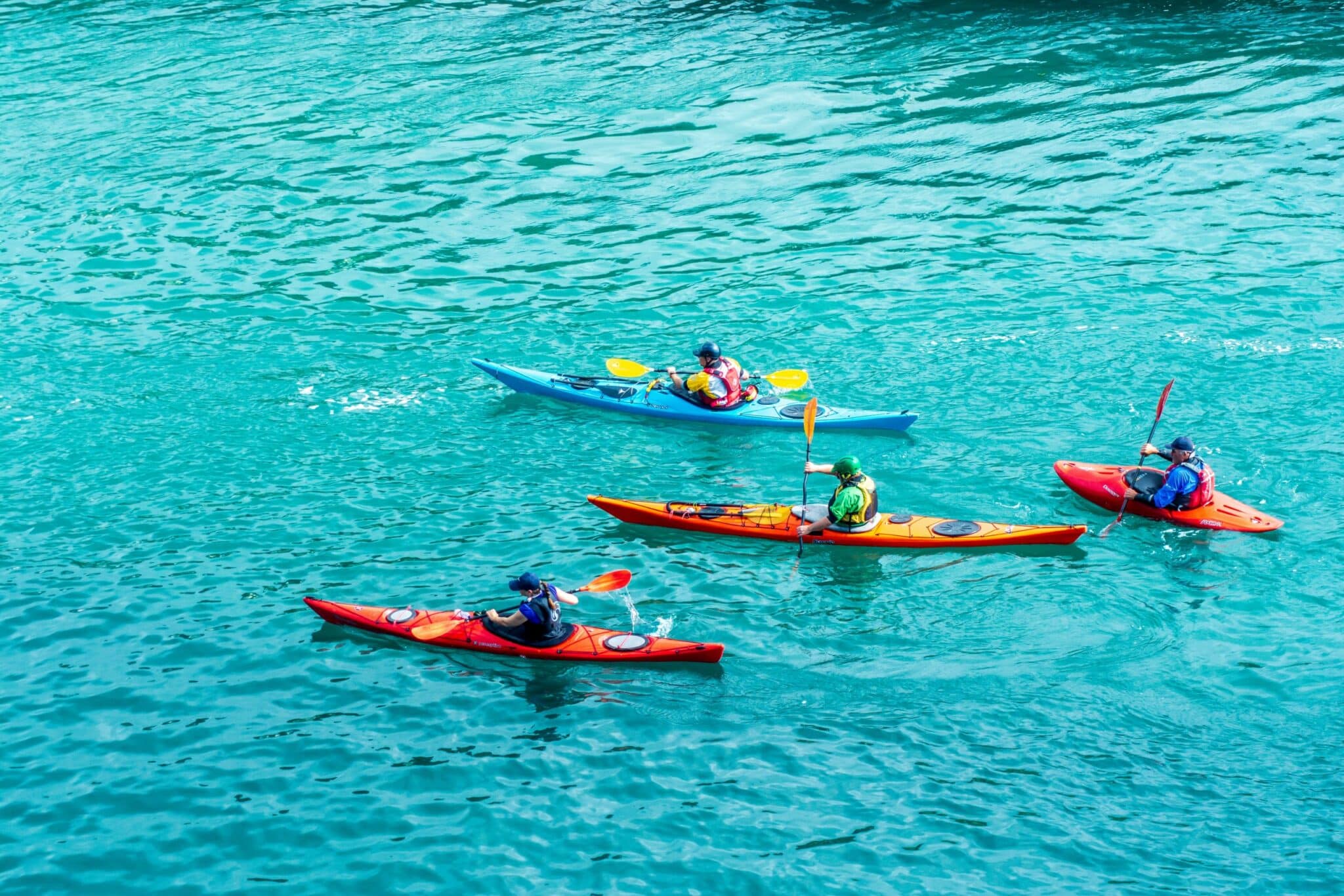
6 Amazing Places To Go Kayaking In Portugal
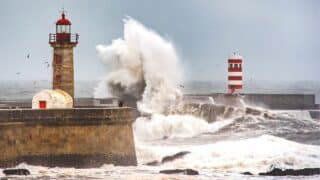
What is Portugal in Winter Really Like? Does it Snow?

9 Awesome Music Festivals in Portugal for Summer 2020

Visit Lisbon: Your Guide on Weather, Hotels, Things to Do and more
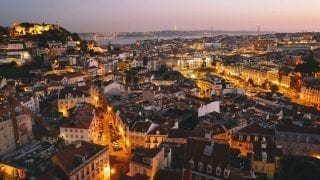
Leave a comment Cancel reply
Stay up to date.
Join our email list to receive weekly updates on webinars, promotions, announcements, social meet ups and more…
About BePortugal
Life in Portugal
Money in Portugal
Stay Connected
Keep up to date with industry insights and latest news.
Copyright © 2024 Expats Portugal
Privacy policy, terms of use.
Algarve-South-Portugal.com
The best independent guide to the Algarve
Monte Gordo, Portugal; a tourism guide for 2024
Monte Gordo is a lively resort town that is situated on one of the finest beaches of the eastern Algarve.
This glorious beach has transformed Monte Gordo from a minor fishing village into a modern and popular holiday destination. The town attracts a wide selection of nationalities, including the Portuguese - who simply adore the region.
Being a modern resort town that grew from the 1980s, Monte Gordo lacks any Portuguese charm or character. Huge apartment blocks dominate the coastline and mass tourism has completely replaced fishing.
As a holiday destination, Monte Gordo is purely focused on the beach, which is simply stunning. There are kilometres of soft golden sands that are lapped by calm waters and surrounded by pristine pine forests.
During the summer, Monte Gordo has a calmer atmosphere than the larger resort towns of the Algarve (such as Albufeira, Vilamoura or Lagos). This makes it ideal for families, or those who prefer somewhere less hectic.
The town also provides exceptional value (for the Algarve) when eating out and socialising. This is due to the large number of Portuguese tourists, who would not pay more than in the rest of their country.
An entire holiday to Monte Gordo could be easily spent lounging on its magnificent beach, but there is a lot to see and do within the eastern Algarve. Just a short train ride away is the historic town of Tavira, as well as Castro Marim, with its two castles, and the charming town of Vila Real de Santo António.
Monte Gordo may not be as well known as the resort towns of the central Algarve, but it has a lot going for it, especially for a beach-focused holiday. This guide will provide an introduction to Monte Gordo and show you why you should have a holiday here. Related articles: Tavira guide - Vila Real de Santo António
Highlights of Monte Gordo
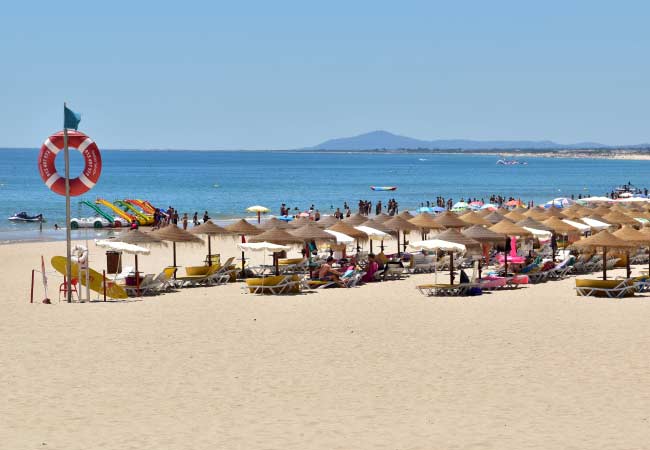
The Praia de Monte Gordo – A glorious beach, which is part of the 14km long sandy coastline that extends to the Spanish border. The Praia de Monte Gordo has some of the calmest seawaters in Portugal and is sheltered from the Atlantic sea breezes.
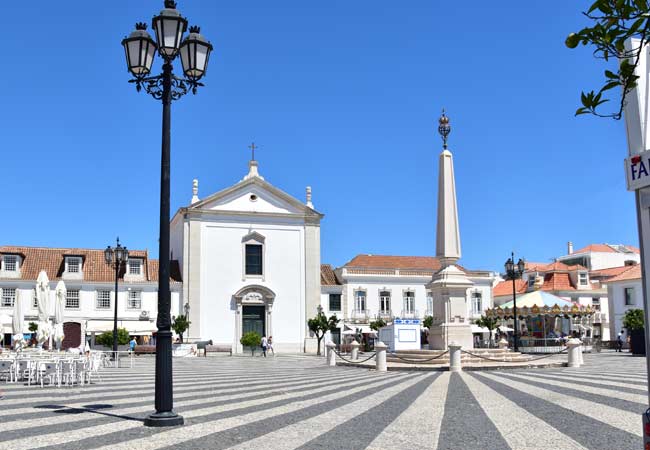
Vila Real de Santo Antonio – A delightful fishing town with grand Baroque architecture that sits on the mouth of the mighty Guadiana River. Vila Real is only 3.5km away and is the perfect balance to Monte Gordo's characterless modernism.

Monte Gordo holiday atmosphere – Relax on the beach, eat delicious food and socialise in the bars. What more could you want for the perfect holiday?

Mata Nacional das Dunas de Vila Real de Santo António – The pristine pine forests that surround Monte Gordo were planted to stabilise the region’s sand dunes. Today these established forests provide tranquil walks, deserted beaches and the perfect habitat for Mediterranean chameleon (the Chamaeleo chameleon) to hide.
Monte Gordo holiday rating

Monte Gordo and the eastern Algarve
Monte Gordo is the largest resort town of the eastern Algarve, but it is only small when compared to the larger beach towns of the region such as Albufeira or Vilamoura.
The town is surrounded by pine forests and the rolling Algarve countryside, and the giant apartment buildings of Monte Gordo seem out of place in the low-key eastern Algarve.
Within Monte Gordo is everything you need for an enjoyable holiday. There is a wide selection of restaurants, shops and bars, and even a casino (the Casino Monte Gordo). Along the beachfront is a pleasant beach promenade, which is lined with numerous restaurants and leads to deserted sections of the beach.
Being in the far eastern Algarve, Monte Gordo is a long distance from the waterparks and theme parks, and can feel remote from the buzz of the central Algarve. There are many fascinating sights and day trips to enjoy in the eastern Algarve, but these tend to be cultural, historical or nature-focused (such as Tavira, Castro Marim, or seeing the flamingos of the Castro Marim nature reserve).
The interactive map below shows the sights, beaches and day trips of the Monte Gordo region. The main tourist area of Monte Gordo is highlighted in yellow and is marker 1. ( Note: Zoom out to see all of the markers)
Sights of the region: 1) Monte Gordo town 2) Casino Monte Gordo 3) Mata Nacional das Dunas de Vila Real 4) Sapal de Castro Marim nature reserve 5) Parque Aventura (tree & high rope adventure course) 6) Monte Rei Golf 7) Cacela fort 8) Portugal-Spain ferry Day trips: 9) Vila Real de Santo António 10) Castro Marim 11) Tavira 12) Cabanas Beaches: 13) Praia da Manta Rota 14) Praia Verde 15) Praia do Cabeço 16) Praia de Monte Gordo 17) Praia de Santo António 18) Praia da Ponta da Areia
Is Monte Gordo good for your holiday?
If the beach and relaxing are your primary focus, then Monte Gordo is the perfect destination for your holiday.
It is ideal for families with young children or couples seeking a calm and low-key location.
Monte Gordo is great for young children, as the beach is one of the safest of the Algarve, with small waves, no strong currents or sea breezes. The town has a calm environment and does not have any of the excessive drinking culture or riotous behaviour found in the larger resort towns.
Older visitors will enjoy Monte Gordo, as the town has a very welcoming attitude and the atmosphere is relaxed and sociable.
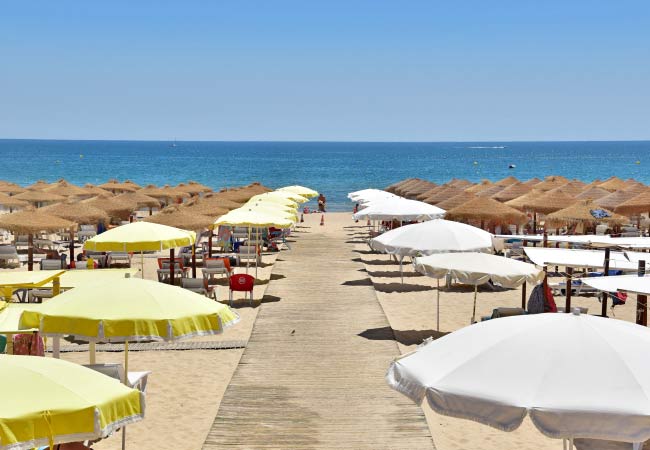
Heading down to the beautiful sea
Monte Gordo is not for everyone
For every person who would enjoy a holiday in Monte Gordo, there would be another that would feel disappointed.
The town has no Portuguese character and can feel very remote from everything.
The eastern Algarve is a long way from the bustling excitement of the central Algarve, and there are no waterparks or theme parks close by. Teenagers, twenty-somethings and party-focused groups should be based in the central Algarve.
If you are after a cultural or authentic Portuguese holiday, then Monte Gordo's modernism is not for you. The closest most tourists come to any Portuguese culture here is eating sardines or drinking a Sagres beer in one of the many cafes. For a holiday destination with Portuguese character, we would recommend Tavira , Lagos or Cascais near Lisbon.
Insight: Much of the eastern Algarve escaped the massive tourist development of the 1980s and 1990s. This was due to the majority of the coastline being lined by the lagoons and mudflats of the Ria Formosa Nature Park. The beautiful beach of Monte Gordo is the only one that is easily accessible, hence why it was developed.
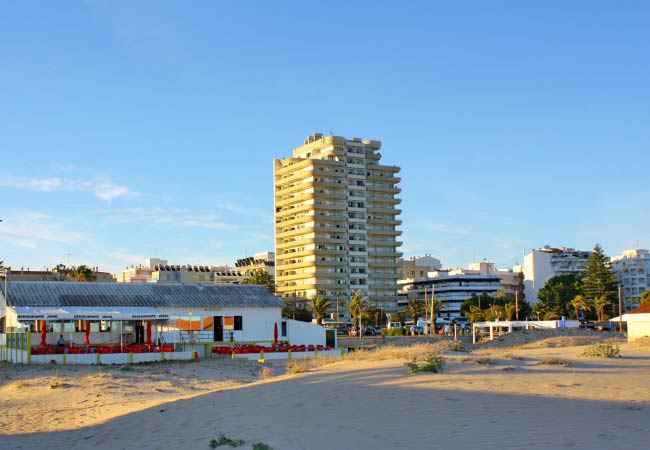
All of the modern apartments have removed any Portuguese charter that once was in Monte Gordo
Where to stay in Monte Gordo?
Monte Gordo is relatively small, and no hotel or holiday apartment is more than a couple of minutes’ walk from the beach or the main promenade of shops and restaurants.
Within Monte Gordo, there are many medium-sized hotels and even more holiday apartments in the huge blocks that line the beach.
Monte Gordo is a popular destination with Portuguese tourists and Spanish visitors (being only 150km from Seville). This means that in the summer months, the majority of accommodation options are sold out.
Some of the better hotels include 4-star The Prime Energize , which has a great rooftop pool. The Hotel Alba is slightly inland but always has good reviews. The 3-star Vasco da Gama has the prime position on the beach and boasts lots of facilities. Next door is the Hotel-Apartamentos Dunamar , which offers holiday apartments that are great option for families.
We have worked with Booking.com for the last seven years, and the interactive map shows the best hotels and rental rooms in Monte Gordo. If you adjust the dates to suit your holiday, it will display current prices and availability.
If the map does not load, please click here to see the best hotels in Monte Gordo .
The beaches of Monte Gordo
The main attraction of Monte Gordo is the beautiful sandy coastline that extends for 14km from the village of Manta Rota in the west to the Spanish border and the mouth of the Guadiana River in the east.
The Praia de Monte Gordo lies halfway along this sandy coastline and is the widest section of the beach, measuring 200 metres from the beach promenade to the edge of the sea. This huge beach can easily accommodate all of the summertime tourists visiting the town.
The prime section of the beach is reserved for paid parasols and sunbeds (€12 per day), but there is plenty of space if you wish to bring your own towels and parasols.
From the central area of the Praia de Monte Gordo, it is only a short walk (400 metres) to near-deserted sections of the beach. To the east is the pristine beach of Praia de Santo António.
The seawaters of Monte Gordo are the warmest in Portugal, but are still chilly - reaching a maximum of just 24C in the summer. Being on the eastern side of the Algarve, the Praia de Monte Gordo is a long distance from the powerful waves and strong sea breezes of the western Algarve. This is a calm and safe coastline that is great for families.

The Praia de Santo António beach is always deserted.
A suggested itinerary for a 1-week holiday to Monte Gordo
The majority of visitors to Monte Gordo come for the beautiful beaches and glorious climate, but there is actually a lot to do within the region.
A suggested itinerary for a 1-week holiday to maximise your time could include: Day 1 – A relaxing day on the beach with a stroll along the Praia de Santo António and a walk through the Mata Nacional das Dunas pine forests. Day 2 – A day trip to Vila Real de Santo António and catch the ferry to the Spanish town of Ayamonte Day 3 – A day trip to Tavira to explore the most characterful town in the Algarve. There is a train from Monte Gordo to Tavira. Day 4 – A visit to the tiny but picturesque fortified village of Cacela Velha, then head to the relaxing village of Cabanas. Day 5 – A day trip to Faro , a historic city with a delightful walled quarter and Bone Chapel (Train from Monte Gordo) Day 6 – If you have a car, drive to the scenic village of Mértola, positioned high above the Guadiana River (this is a long drive). Day 6 - (Alternative) – A day trip to the fishing town of Olhão , (by train), with its large fishing harbour and boat tours of the Parque Natural da Ria Formosa. Day 7 – Visit the two castles of Castro Marim and see the large flock of flamingos in the Reserva Natural do Sapal de Castro Marim salt marshes.

The Ponte Romana bridge spanning the Gilão River in the historic centre of Tavira.
When to visit Monte Gordo
The height of the summer season for Monte Gordo is from July through to August. During this season, the hotels are full, restaurants are busy, and there is a great atmosphere around the town. The weather is suitable for spending time on the beach from May until mid-October. Outside of the summer season, hotel bargains can be found, but the town will feel very quiet.

The average day time maximum and the nighttime minimum temperature for Monte Gordo
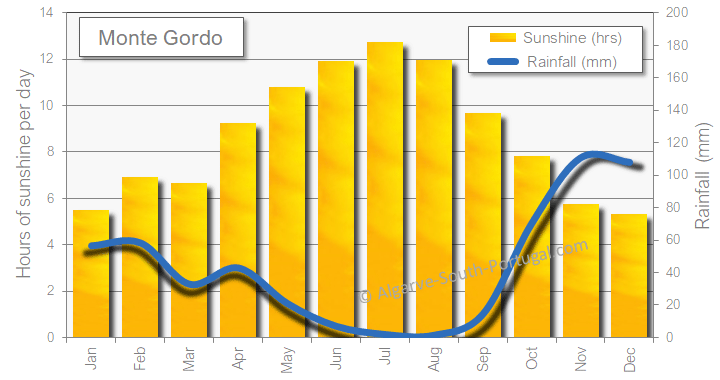
The average hours of sunshine per day and monthly rainfall (in mm)
Monte Gordo airport and transfers
The main international airport of the Algarve is Faro Airport, and Monte Gordo is located 60km to the east.
The majority of visitors to Monte Gordo organise a pre-arranged transfer, but it is possible to use a ride hailing app (Uber or Bolt) or to take the train.
A taxi from the airport will be the most expensive option (around €80), whereas an Uber or Bolt will cost less at €40. The issue with Uber and Bolt is that there can be very high demand in the summer when flights arrive, resulting in increased fares or long waits to connect to drivers.
It is possible to take public transport from the airport to Monte Gordo, which involves taking a bus from the airport to Faro train station then catching the train to Monte Gordo.
The train journey takes 1 hour 7 minutes and costs €5.45 for an adult. The latest timetable can be seen on the Comboios de Portugal website: www.cp.pt/
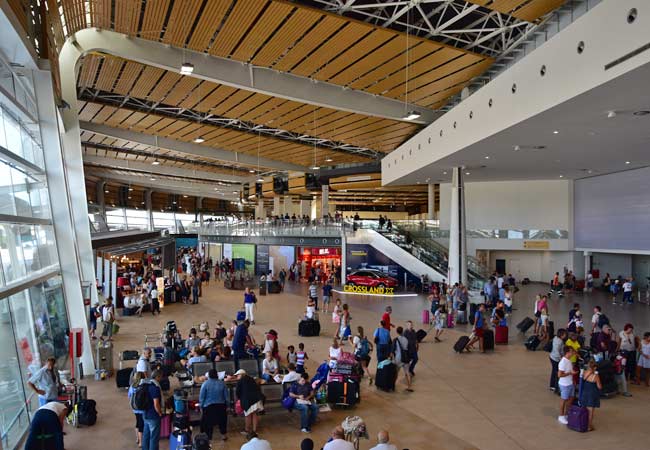
The main terminal building of Faro Airport
The Mata Nacional da Dunas Litorais de Vila Real de Santo Antonio
The Mata Nacional da Dunas Litorais de Vila Real de Santo Antonio is the largest forest in the Algarve. This forest was planted during the early 20th century to stabilise the sand dunes of the region.
Today the natural park provides a unique pine forest ecosystem, which is an important habitat of the Common Chameleon (Chamaeleo chamaeleon). These timid reptiles are extremely difficult to see. The forest is the perfect place to escape the summer crowds, and there are pleasant, shaded footpaths across the 440 hectares of forest.
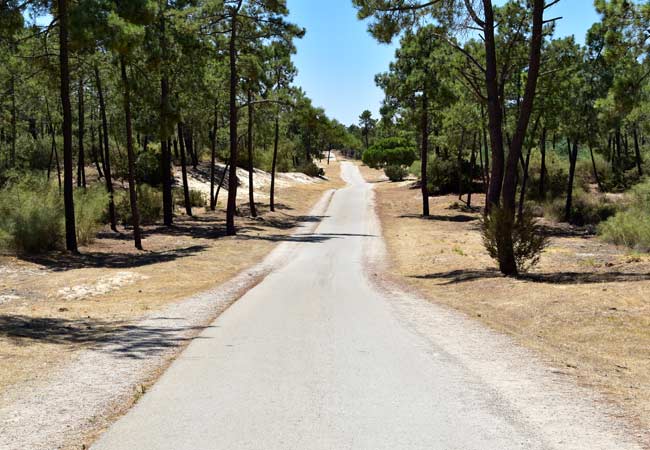
The shaded paths of the Mata Nacional da Dunas Litorais.
Monte Gordo Portugal Holiday Guide
Monte Gordo
Monte Gordo Introduction Best Hotels in Monte G Day Trips from Monte G Things to Do in Monte G Monte G Weather 3 days in Monte Monte Station Monte G to Lisbon
Vila Real de Santo Antonio
Introduction to Vila Real 3 days in Vila Real Vila Real to Lisbon
Lagos Guides
Lagos Introduction 1 Week in Lagos Lagos Day Trips Day trip to Sagres Dona Ana Beach Ponta da Piedade
Algarve Guides
Algarve Introduction Where to go in the Algarve? 1 week Tour Algarve Driving Airport Guide Monte to Tavira
Praia da Rocha
PDR introduction PDR Day Trips PDR beach guide
Silves Introduction Silves Day Trip Silves Walk Tour
Faro Introduction Faro 3 days Faro beach guide Silves Algarve Silves day tour
Tavira Guide
Tavira Introduction 1 Week in Tavira 2 days in Tavira Tavira Beaches Tavira Day Trips Santa Luzia
Albufeira Guides
Albufeira Introduction Albufeira for Families Albufeira stag/hen do Airport to Albufeira
Algarve Towns
Alvor Loule Olhão Praia de Luz Quarteira Portugal Sagres Vilamoura
Portugal Guides
Where to go in Portugal? Where to Live in Portugal Top 10 Portugal 1 week in Portugal A weekend in Portugal Top 10 beaches
Around Portugal
- The Alentejo
- Berlenga Islands
Monte Gordo, Portugal; a tourism guide for 2024 © 2024 Algarve-South-Portugal.com - Privacy Policy & Contact Page
Introduction to the beach resort of Monte Gordo
Things to Do?

What are the main activities in Monte Gordo?
Need a Hotel?

Find the best hotels at the lowest prices!

What are the best day trips from Monte Gordo?

Where to stay in the Algarve and the best resort
Monte Station

A guide to Monte Gordo station and train services
The Algarve Travel Guide
Book your individual trip , stress-free with local travel experts
Select Month
- roughguides.com
- Travel guide
- Itineraries
- Local Experts
- Travel Advice
- Accommodation
Plan your tailor-made trip with a local expert
Book securely with money-back guarantee
Travel stress-free with local assistance and 24/7 support
Just wanted to express my thanks to Joel and Rough Guides for a wonderful trip! Everything was well-chosen and we just loved all of the hotels, sightseeing...
With many of the country’s safest and loveliest beaches, and a year-round balmy climate, it is not surprising that the Algarve is the most popular holiday region with some of the best beaches in Portugal . The Algarve is the most southern region in Portugal, stretching the southern Atlantic coast from Vila Real at the border to Spain in the east to Sagres in the west.
Places to visit in the Algarve
Olhao and the islands, cacela velha, vila real de santo antonio and around, the central algarve resorts, armacao de pera, the serra de monchique, the western algarve, the west coast of portugal, carvoeiro and around, travel ideas for portugal, created by local experts.

7 days / from 3090 USD
Iberian Blend - Porto and Galicia
Neighbour countries - Portugal and Spain, different and similar at the same time, will surprise you with hospitality and loveliness. This itinerary includes the route of the Northwest part of Iberian Peninsula and offers you to meet beautiful Porto and stunning Vigo in Galicia/Spain.
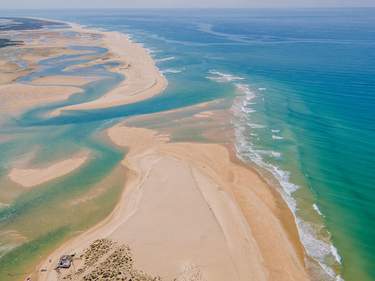
7 days / from 3047 USD
The Real Algarvian Experience
Experience and discover the real Algarve – taste local produce, drinks and traditional dishes, visit heritage sites and participate in culinary activities. If you are passionate about the people’s culture and gastronomy and want to learn more, this itinerary is for you.

11 days / from 1744 USD
A self drive to Portugal's North and Center
Starting in fascinating Lisbon, this trip allows you to discover Portugal both on your own as well as with guided tours. Driving further up north you'll explore Coimbra and Porto before heading to the Douro Valley and Alentejo.
When deciding where to go in the Algarve, take into consideration that stretches of the central coast between Lagos and Faro are mostly heavily developed, especially Faro . But even here the beaches are first-rate, as are the facilities. Also there are areas in the western Algarve around Sagres and Tavira where the surroundings are more attractive, with laidback resorts and low-key development.
To the west of Vilamoura, you’ll find the rocky outcrops and cove beaches for which the Algarve is best known, especially around the main resorts of Albufeira , Armacao de Pera (Armação de Pêra) and Lagos . The coast becomes progressively wilder as you head west, where attractive smaller resorts include the former fishing villages of Burgau or Salema, and the historic cape of Sagres – thought to be the site of Henry the Navigator’s naval school. The string of villages along the rougher west coast, as far as Odeceixe, are quieter still, with limited facilities but fantastic wild beaches ideal for surfing.
The eastern coast between Faro and the Spanish border is very different. Most of it is protected within the Reserva Natural da Ria Formosa, a series of barrier islands fronted by extensive sandy beaches. That means taking a short boat trip to reach the sands, which has helped preserve the towns from large-scale development. The resorts here have a more Portuguese feel than those in the central stretch, and first-choice bases here would be Faro itself – capital of the entire region – as well as Olhao, Fuseta, Cabanas or Tavira , all of which offer easy access to the sandbank islands.
Inland Algarve is still relatively undeveloped, especially around Alcoutim on the Spanish border. The Roman ruins of Milreu and the market town of Loulé are both worth an outing from Faro, while the old Moorish town of Silves is easily accessed from Portimão. Towards the west of the region, Caldas de Monchique is a quaint spa town in verdant woodland that makes up much of the picturesque Serra de Monchique mountain range.

Traditional portuguese town of Olhao, Algarve, Portugal © S-Studio/Shutterstock
There are few actual sights in Olhao (Olhão), 8km east of Faro . Still, with a vibrant market, attractive riverfront gardens and atmospheric backstreets, it’s an appealing place to spend some time. It also makes a great base from which to visit the surrounding sandbank islands of Armona and Culatra or the Quinta da Marim environmental centre.
The largely pedestrianized old town boasts some superb tile-fronted buildings, quirky shops and bars, while the flat roofs and narrow streets are striking and give a North African look to the place – perhaps not surprisingly, as Olhao had traditional trading links with Morocco.
The town was granted its charter by exiled king João VI to thank the local fishermen who sailed a small boat, O Caíque de Bom Sucesso, across the Atlantic to Brazil in 1808 to give him the good news that Napoleon’s troops had left Portugal. The amazing journey was completed with the most basic navigational aids. Today, a replica of the boat is moored on the water behind the market. It occasionally runs boat trips along the coast, ask at the turismo for details.
Around 10km east of Olhao, the fishing town Fuseta (Fuzeta) is one of the least “discovered” resorts on the Algarve. It is served by regular bus as well as the main Algarve rail line, probably because of its shortage of accommodation. It is not the most beautiful town in the region, but it retains some character as a working fishing port. Its daily routine revolves around its fishermen, whose colourful boats line up alongside the river in town. In summer Fuseta also attracts a lively community of campers. The two communities usually mingle at the line of lively kiosk-cafés spreading down from the ferry stop towards the river beach.
The town’s backstreets straddle a low hill facing the lagoon, sheltered by the eastern extremity of the Ilha da Armona. Many of the local fish find their way to the small covered market on Largo 1° de Maio, on the road running parallel to the river. On Saturdays the market expands into a flea market that lines the adjacent pedestrianized Rua Tenente Barrosa. Continue up this road to reach the town’s little palm-tree-lined central square.
The waterfront of modern shops and apartments faces broad gardens that are largely taken over by the campsite. Beyond this is the estuary beach, a fine stretch of white sand that weaves up to a wooden lifeboat house, though more exhilarating and cleaner waters are found over the lagoon on the Ilha da Armona.
Six kilometres east of Tavira – past the golf course at Benamor – lies Cabanas, named after the fishermen’s cabanas (huts) that formed the original settlement. Today a kernel of backstreets is still made up of pretty fishermen’s houses along with a line of low-rise shops, cafés, restaurants, and bars facing a picturesque river estuary edged by a neat wooden walkway. Moored fishing boats testify to the village’s former mainstay, though today the economy is largely driven by tourism thanks to the glorious sands on Praia de Cabanas over the estuary.
Things to do in Cabanas
Ferries shuttle passengers to the Praia de Cabanas from a small jetty opposite Restaurante O Monteiro in the east of town. Cross the dunes and you’re faced with kilometres of golden sand, plus a couple of seasonal beach cafés. A perfect spot for swimming, sunbathing and relaxing before grabbing a yummy lunch or sunset dinner.
There are three golf courses in the area for golfers, a 17th century Sao Joao da Barra fort, now turned into a luxury seafront hotel for those who love relaxing. For nature lovers, you can take a boat ride to the waterways of the Ria Formosa Natural Reserve, ideal for birdwatching.
Best time to visit Cabanas
The best time to visit Cabanas is typically during September and October, when the temperature is in the high 20s. The Summer months are of course the hottest, with temperatures sitting in the mid 30s. Spring is cooler, as with winter, at around 17 - 20 degrees; perfect if you want some winter sunshine.
Perched on a low cliff facing the estuary, 10km east of Cabanas, the whitewashed village of CACELA VELHA is a reminder of how the Algarve must have looked half a century ago. Apart from a few café-restaurants, there are no tourist facilities, just a pretty church and the remains of an eighteenth-century fort – and even that houses a maritime police station and is closed to the public. Offering exhilarating views from its clifftop, Cacela is highly picturesque and, despite the Quinta da Ria/Quinta da Cima golf courses just to the west, it’s rarely overrun by visitors. The only time the place gets busy is during the Moorish Nights in July – a four-day festival of Arabic food and Moorish-inspired events, including a souk.
The beach below the village has been rated as one of the best in the world, and it would be hard not to agree. To get to it, follow signs to “Fábrica”, just west of the village, around 1km downhill. From here a ferryman can take you over to the beach (daily in summer, but only during good weather the rest of the year).
Vila Real de Santo Antonio (aka Vila Real) is a pleasant border town, the terminus for the trans-Algarve railway line. The ferry across the Guadiana from here to Ayamonte is still the most fun way to cross the border. The construction of a modern road bridge just north of the town in the 1990s greatly affected the town’s former role as the Algarve’s main access point to Spain.
Nevertheless, it’s still an interesting place to spend a few hours, exploring a central grid of streets that radiates out from a handsome main square, Praça Marquês de Pombal, ringed by orange trees, low, white buildings and pleasant outdoor cafés. The square is named after the king’s minister, who helped rebuild the original town after it was destroyed in a tsunami following the 1755 earthquake. Indeed the grid plan, dating from 1774, is very similar to that of Lisbon’s Baixa.
On the north side of the square, Rua Teófilo Braga, the pedestrianized main street, leads inland from the riverfront Avenida da República to the Centro Cultural António Aleixo, the town’s former market building now used as an innovative space for temporary exhibits and the occasional film, and which also dispenses tourist information. The streets surrounding the cultural centre have a certain low-key charm, bristling with linen shops, electrical retailers and grocers, while the riverside gardens offer fine views across to the splash of white that is Ayamonte in Spain.
Some 40km north of Vila Real – and best approached by car along the road that hugs the Guadiana River – is the extremely attractive border village Alcoutim. It has a long history as a river port, dominated in turn by Greeks, Romans and Arabs who all fortified the heights with various structures; the castle dates from the fourteenth century and offers fine views over the river.
The entrance fee includes access to a small archeological museum by the main gates, which traces the history of the castle, its active service in various battles and the remnants of earlier structures on the site. From the castle, cobbled backstreets lead down to the small main square, below which is the appealing riverfront. Currents are too strong for safe swimming, but you can take a boat across the river to the Spanish village of Sanlúcar, a mirror image of Alcoutim, with its own ruined castle; or swim at the river beach (praia fluvial) in a small tributary off the Mértola road.
The central Algarve from Faro to Lagos encompasses some of the region’s best beaches – but also its most intense tourist development. Despite this, Quinta do Lago, Vale do Lobo and Vilamoura are low density and upmarket: purpose-built resorts with great facilities including marinas, top golf courses and tennis centres. These resorts don’t have much traditional culture, though there’s a little more of that at neighbouring Quarteira, a high-rise resort with a fine town beach and a renowned fish market.
For Getting around Central Algarve resorts, a road train trundles along the seafront, round town and back to the market every hour or so.
LOULÉ, 18km inland from Faro , has always been an important centre of commerce and is still best known for its markets. It has recently grown to a fair size, though its compact centre doesn’t take long to look around. The most interesting streets, a grid of whitewashed cobbled lanes, lie between the remains of its Moorish castle (now a museum) and the thirteenth-century Gothic Igreja Matriz, with its palm-lined gardens in front.
Armacao de Pera (Armação de Pêra), 15km west of Albufeira , fronts one of the largest beaches in the Algarve, which spreads east all the way to Galé. Beach aside, it is not the greatest looking of resorts; high-rise buildings and apartments straggle along the town’s main through-road, tempered only by a pedestrianized promenade overlooking the central part of the sands.
The remains of Armacao de Pera’s fortified walls are at the eastern end of the resort, where a terrace in front of a little white chapel provides sweeping views. But the town beach is fine and if the main section is crowded, just head further east, beyond the cluster of traditional boats on the fishermen’s beach towards Galé, where things are quieter. Aside from the beaches, the other local attraction is 4km up the main N125 at Porches, where the most famous of the Algarve’s chunky and hand-painted pottery comes from – the main road is lined with shops that sell it.
Eighteen kilometres northeast of Portimão, with a superb castle whose dramatic ring of red walls gradually reveal themselves as you approach, SILVES is well worth at least a half-day’s visit. While under Moorish occupation, the town was the capital of the Algarve – indeed it was the Moors who named the region al-Gharb (“the west”), and built Silves into a well-fortified and sophisticated place. The town’s golden age came to an end, however, in 1189 with the arrival of Sancho I and his large, unruly army of Crusaders, who laid siege to thirty thousand Moorish inhabitants in the citadel for three months. When the Moors’ water and food supplies finally ran low they agreed to open the citadel gates in return for Sancho guaranteeing the safety of its inhabitants. The Crusaders, however, ignored Sancho’s pledge and killed some six thousand Moors as they gleefully took the fortress. Silves passed back into Moorish hands two years later, but by then the town had been irreparably weakened, and it finally fell to Christian forces for good in 1249.
The Serra de Monchique is a rolling mountain range separating the Algarve from the neighbouring Alentejo district. Its slopes are made up of deciduous oaks and chestnut woods and it’s one of the few areas of Portugal that shows off dazzling autumn colours. Its highest peak – at nearly 900m – is Fóia, from where, on a clear day, the views stretch over the south coast of the Algarve and west across to Cabo de São Vicente. Sadly this area also bears the brunt of the summer fires that seem to rage annually, though the woodland is generally quick to recover.
Caldas de Monchique
Set in a beautifully wooded ravine, CALDAS DE MONCHIQUE was a spa even in Roman times and was once popular with Portuguese royalty. It was sympathetically restored in 2000, transforming a somewhat ramshackle spa resort into a tourist village – and the results have been fairly successful. The cobbled, tree-shaded main square, fronted by the pseudo-Moorish windows of the former casino (now an exhibition hall), is surrounded by lovely nineteenth-century buildings and the wooded setting is a delight. At the foot of the village, the modern thermal spa offers specialist treatments – including water massage, jet-showers and a steam room.
MONCHIQUE, 6km from Caldas, is a sizeable hilltown best visited for its market, held on the second Friday of each month (by the helipad): check out the local smoked hams and distinctive wooden furniture – especially the distinctive x-shaped chairs. There’s also a weekly Sunday market on the main square, Largo 5 de Outubro, though the town is liveliest during the Feira dos Enchidos Tradicionaes (Traditional Sausage Fair) in March, when restaurants lay on special menus. The old town is dotted with beautifully crafted metal sculptures of local characters made by a contemporary Lisbon artist, which you can spot on the waymarked route to the ruined seventeenth-century monastery of Nossa Senhora do Desterro, signed uphill from the bus station. Only a rickety shell of this Franciscan church remains, but it’s a lovely fifteen-minute walk up.
There’s a beautiful, winding 8km drive from Monchique up to the Serra’s highest peak at Fóia, though the summit itself – bristling with radio masts, and capped by an ungainly modern complex sheltering a café-restaurant and shop – can be an anticlimax, especially if clouds obscure the views. On a clear day, however, the vistas are superb.
The coast west of Lagos , as far as Sagres , remains one of the least spoiled parts of the Algarve, largely thanks to the Parque Natural da Costa Vicentina which prohibits large-scale building on the coastline west of Burgau. As a result, the resorts – certainly west of Luz at Burgau and Salema – remain largely low-rise and low-key. Most of the coast is linked by a craggy coast path and you can easily walk between the villages: Salema to Luz, or Luz to Lagos , in particular, are beautiful routes.
Once past the modern suburbs, Burgau, 5km west of Luz, is a pretty little former fishing village of narrow cobbled lanes which tumble down a steep hillside to a fine sandy beach set below low cliffs. Fishing boats still line the lower roads, which double up as slipways, while narrow alleys weave around to a miradouro viewpoint. In July and August the village is somewhat mobbed, but at other times it retains a distinct character, with locals cooking fish on tiny grills outside their homes.
At the bottom of an attractive valley, Salema is no longer the thriving fishing village it once was, but its tight warren of fishermen’s houses above the eastern end of a fine, sandy bay now form the hub of an attractive resort. Many of the old houses are now converted into inexpensive holiday lets: look for signs in the windows. A plume of modern development spreads steeply uphill, but at least the white villas are in keeping with the old town, and its beach only gets busy in high season.
The west coast of the Algarve faces the full brunt of the Atlantic, whose crashing breakers and cooler waters have largely deterred the developers. Nevertheless, the rocky coastline is punctuated by fantastic broad beaches accessible from the small villages of Carrapateira, Odeceixe or, a little further inland, Aljezur.
This is popular territory for surfing, camping and hardy nudists who appreciate the remote beaches. Be warned though: the sea can be dangerous and swimmers should take great care. In 1995 the stretch of coast from Burgau to Cabo de São Vicente and up through the Alentejo was designated as a nature reserve, the Parque Natural da Costa Vicentina. This afforded the rugged scenery a certain amount of protection, though it also means that accommodation is scarce and it is better to have your own transport.
Aljezur (pronounced “alj-ezoor”), 16km north of Carrapeteira, is the liveliest town on this coast, though some way inland from any beaches. The main coast road passes through a prosaic, modern lower town where you find banks, the post office and a range of cafés and restaurants. The more interesting historic centre spreads uphill beyond the bridge over the Aljezur River, a network of narrow cobbled streets reaching up through whitewashed houses to the remains of an eleventh-century Moorish castle, a lovely picnic spot and where you can see the remains of the cistern and grain silos. It’s a lovely walk up to the castle with sweeping views over the valley, via a cluster of museums (see also Walks in and around Aljezur).
The Casa Museu Pintor José Cercas displays the works and collections of local artist José Cercas, who lived in the house until his death in 1992. His well-observed landscapes and religious scenes are complemented by the attractive house and pretty garden.
Some 10km southwest of Aljezur, Praia da Arrifana is a superb, sandy sweep set below high, crumbling black cliffs which shelter a tiny fishing harbour. The beach is excellent, and surf competitions are sometimes held here. Several simple café-restaurants lie along the road above the beach, all serving grilled fish at moderate prices.
Walks in and around Aljezur
The active historical society in Aljezur has marked out an attractive 4km Circuito Histórico around the old town, with historical sights marked by plaques in English and Portuguese. Before the river silted up in the fifteenth century, Aljezur was a major port, and the route passes buildings such as the tollhouse, once used to check weights and goods as they arrived. The town also marks the crossover point of two major long-distance walking trails: the Via Algarviana, which runs for 300km from Alcoutim in the west to Cabo de São Vicente in the south; and the Rota Vicentina, which runs for 340km from Santiago de Cacém in the Alentejo, sharing the southern route to Cabo de São Vicente with the Via Algarviana.
The attractive village of Odeceixe tumbles down a hillside opposite the broad valley of the Ribeira da Seixe, below the winding, tree-lined main coast road. Sleepy out of season, its character changes in summer when it attracts a steady stream of surfers, campervanners and families, lured by a superb beach and a very laidback atmosphere. Everything centres on the single main street and a small square, Largo 1 de Maio, where you’ll find some lively bars, plenty of cafés, a couple of minimarkets, post office, bank and craft shops.
The beach, Praia de Odeceixe, is 4km west of the village, reached down a verdant river valley, the fields either side neatly cultivated with corn. A road-train trundles between village and beach during July and August, but it’s a lovely walk along the road as well, following the river to a broad, sandy bay framed by low cliffs. Praia de Odeceixe is one of the most sheltered beaches along this stretch of coast, offering superb surfing and relatively safe swimming, especially when the tide is out. There’s lots of parking above the bay, as well as a cluster of houses and cafés, some offering quartos (rooms to rent).
Carrapateira and its beaches
Some twenty kilometres to the north of Sagres is the low-key village of CARRAPATEIRA. There’s not much to the village itself, but most people are drawn by the nearby Praia da Bordeira, a spectacular beach backed by giant dunes, a tiny river and crashing surf. A couple of kilometres south of Carrapateira (signed off the main road), there’s a further fantastic broad, sandy bay, Praia do Amado, with a couple of seasonal cafés. Backed by low hills, it’s particularly popular with surfers, and there’s a surf school here.
A whitewashed former fishing village nestled into sea cliffs, the small resort of Carvoeiro must once have been very attractive, but now its small cove beach has to support the prostrate bodies of hundreds of tourists shipped in to what has become an overblown resort.
Things to Do in Carvoeiro
Apart from the obvious activities such as swimming, sunbathing and generally just relaxing and enjoy the beach, there are other places to explore should you want more of an adventure. From the beach itself, local fisherman run boat trips to the nearby caves. You can also visit the impressive rock formations of Algar Seco, 1km east of town, where steps lead down low cliffs to a series of dramatic overhangs above blow holes and grottoes. They are accessible via the coast road, or by a road train that trundles out from Carvoeiro every hour or so.
There are two superb cove beaches a few kilometres to the west of Carvoeiro, though you’ll need your own transport to reach them from town. First up is Praia da Caneiros, with a rock stack jutting from the sea off its lovely beach and a superb beachside restaurant, Rei das Praias. A couple of kilometres further on, Praia Pintadinho is almost as appealing, with a simpler café-restaurant.
Best time to visit Carvoeiro
The Summer months in Carvoeiro can be quite hot, the best time to visit the Algarve region is between April and June, when temperatures sit nicely at around 25 degrees, the same for September and October. It is never particularly cold, with the lowest avergae temperature sitting at 11 degrees in January, when rainfall is at its highest.
Around Carvoeiro
Carvoeiro is a small town, so once you've explored it's streets and relaxed on the beaches, you may be looking for a day trip. Nearby is Silves, a historical town with a Moorish castle and pretty riverside walks. A nice way to see Silves is by taking a boat trip up the Arade River from Portimao.
Facing the sprawl of Portimão across the Rio Arade estuary, FERRAGUDO is an attractive former fishing village centred on a strip of palm-fringed gardens that spread up to the cobbled main square, Praça Rainha Dona Leonor. A waterfront promenade lined with fish restaurants skirts the estuary – you can take various boat trips from here, most linking up with those departing from Portimão.The old town spreads steeply uphill behind the estuary, its warren of atmospheric cobbled backstreets gathered around Ferragudo’s church, with a terrace that offers great views. The town has an estuary beach, which gets progressively more appealing as it approaches the impressive Castelo de São João do Arade. The castle (closed to the public) faces its partner fort in Praia da Rocha across the river, both of which were built in the sixteenth century to defend Portimão against attack.
The nearest ocean beach lies a couple of kilometres south, where you’ll find the broad sands of Praia Grande at the mouth of the Rio Arade, with a scattering of restaurant-bars.
Sited on the broad estuary of the Rio Arade, Portimão has made its living from fishing since pre-Roman times, but today it's a sprawling modern port of around forty thousand people. Few of Portimão’s buildings made it through the 1755 earthquake – the Igreja da Nossa Senhora da Conceição is a rare survivor, retaining a fourteenth-century Manueline door, though most of the church was rebuilt in the late seventeenth century. The surrounding streets are pleasant enough, filled with shops selling lace, shoes, jewellery, ceramics and wicker goods, while the main shopping streets are around the pedestrianized Rua Diogo Tomé and Rua da Portades de São José.
The most attractive part of town is the riverfront, where a series of squares – Largo do Dique, Praça Manuel Teixeira Gomes and Praça Visconde de Bivar – are filled with outdoor cafés by gushing fountains. Heading up the river and under the road bridge you’ll find a series of open-air restaurants serving inexpensive grilled-sardine lunches. The narrow streets just back from the bridge – off Largo da Barca – are Portimão’s oldest, with more than a hint of their fishing-quarter past.
Set slightly inland on the Rio Alvor, the port of Alvor, 6km west of Praia da Rocha , briefly achieved fame as the place where Dom João II died in 1495. Although much of the town was razed in the 1755 earthquake, it still boasts a sixteenth-century Igreja Matriz with Manueline doors and pillars carved into fishing ropes and plants. Despite the inevitable development, the old core around the church and the central Praça da República retains some character, while the harbour itself is a delight, lined with colourful fishing boats and aromatic fish restaurants. Two-hour boat trips to various places along the coast leave from here. From the harbour it's a short walk uphill to the ruins of Alvor’s castle, which dates back to the thirteenth century but now houses a children’s playground.
Exploring Alvor
From here, Rua Padre David Neto leads onto Rua Dr Frederico Romas Mendes, the main drag lined with bars and restaurants. This stretches down to the riverside Largo da Ribeira, marked by a modern statue of a fish, where you’ll find half a dozen fish restaurants overlooking the picturesque Rio Alvor. Head right as you face the river and a path leads up the estuary for a tranquil walk; bear left and it is a ten-minute stroll past fishermen’s huts and riverside cafés to the Praia de Alvor, an enormous beach backed by café-bars.
Praia de Alvor
Praia de Alvor is a beach of stunning measures - spanning several kilometres, the sands are soft and the waters blue. You will find a long boardwalk close to the beach that leads you to the pretty Ria de Alvor Nature Reserve. When you're not busy enjoying the beach and sunshine, check out the local church and castle.
Getting to Alvor
If you are staying in the town of Alvor, the beach is just a short walk away. From Lagos and Portimao there are buses to the village, and if traveling by car; Alvor is well sign-posted. Close to the beach is a parking lot that is shockingly cheap at 1.50€ for the full day.
Related articles from the blog

Discover more places in Portugal

- Sagres and around
- Tavira and around
The Rough Guides to Portugal and related travel guides
In-depth, easy-to-use travel guides filled with expert advice.
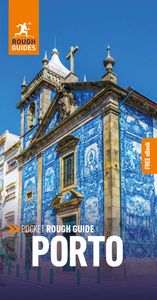
Find even more inspiration here
Planning your own trip prepare for your trip.
Use Rough Guides' trusted partners for great rates

written by Mani Ramaswamy
updated 17.04.2024
Ready to travel and discover Portugal?
Get support from our local experts for stress-free planning & worry-free travels.
- Where to stay
- Travel advice
Faro Tourism Guide
The best faro travel tips, trip planner and insider's guide.
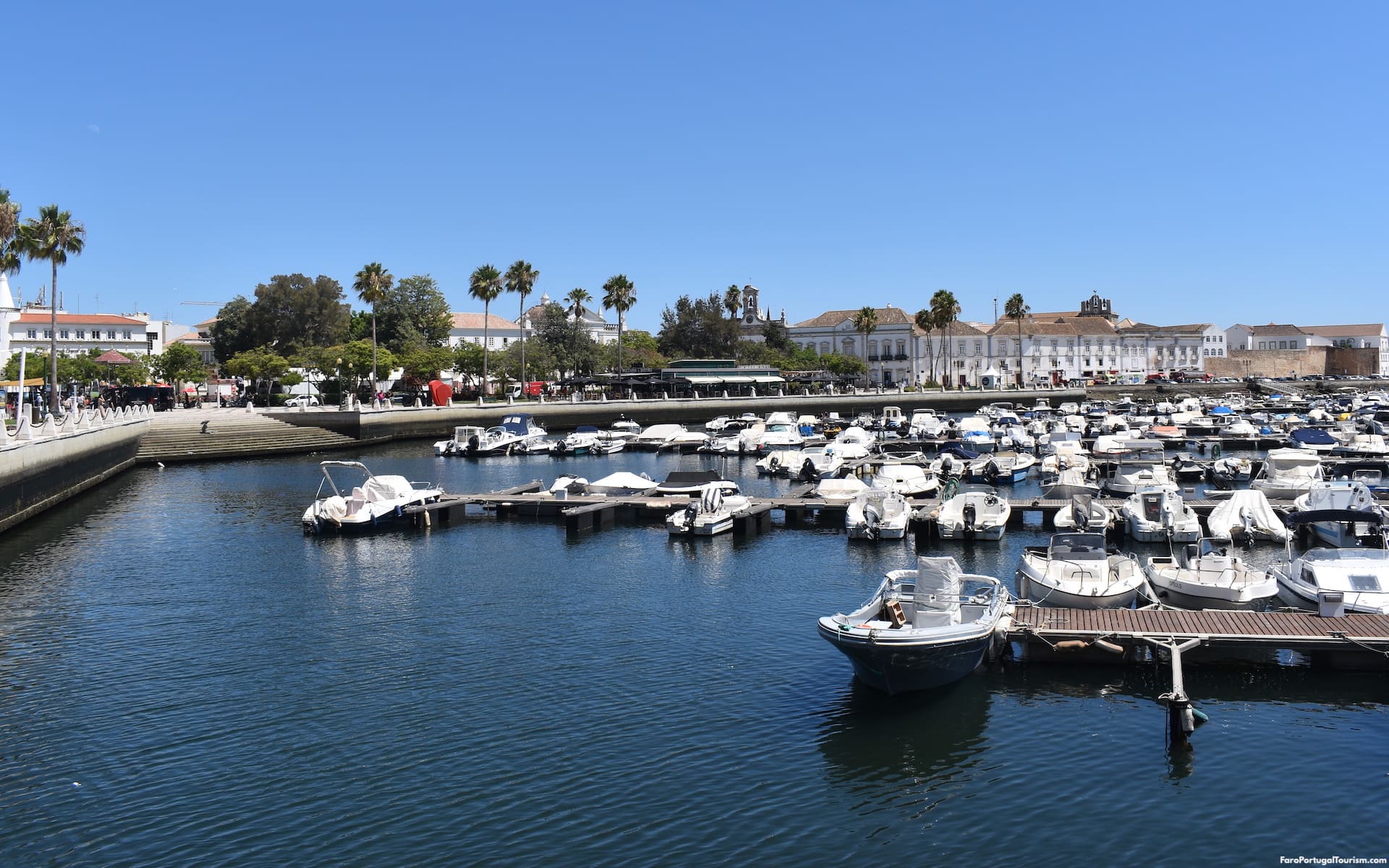
T he capital of Portugal's Algarve region is home to the country’s third largest airport, and therefore serves as the gateway to the beautiful beaches on the southwestern edge of Europe . Those who land in the city often head straight to their resorts and completely overlook what it has to offer, but those who stay, end up finding a delightful walled town and wonderful beaches, including one in a desert island!
Located roughly at the center of the region, it’s a great base to explore all of Algarve , with good public transportation to the major towns. Ferries also connect it to the Ria Formosa Natural Park, with its lagoons, mud flats, and barrier islands.
Like all of southern Portugal, it was devastated by a major earthquake in 1755, but has the largest concentration of monuments and historical sights in Algarve . That makes it the perfect destination for those who like to combine culture and beach . Even if all you want is to relax at a resort elsewhere in Algarve, at least one day in Faro is the perfect introduction to the region.
Faro Travel Planner
Helpful insider tips to plan the perfect days in the city:.
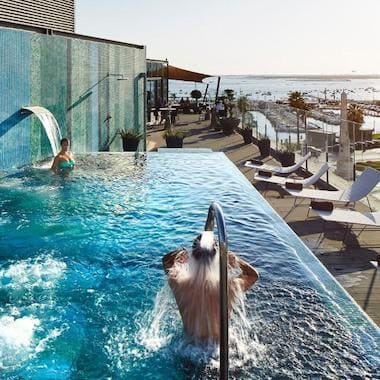
Where to Stay The Best Areas and Hotels
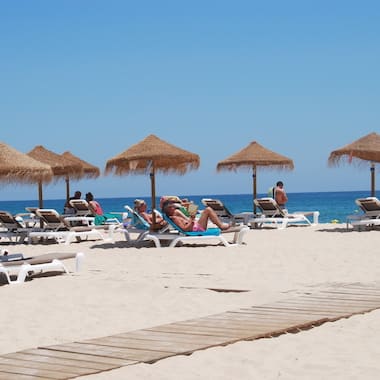
The Best Beaches Choose the right beach for you
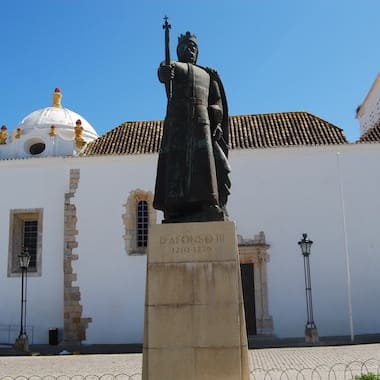
Top 10 Attractions The Best Things to See and Do

The Best Day Trips Where to Go Around Faro
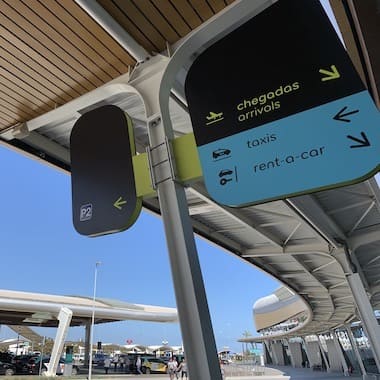
Transportation Guide How to Get There and Around

Algarve Guide The Other Destinations in Southern Portugal
When to visit faro.
Northern Europeans visit Algarve throughout the year, looking for sunnier and warmer days. However, it’s only warm enough for sunbathing at the beach between April and October. It has a wonderful Mediterranean climate, with mild springs and autumns, and warm summers. There are many rainy days between November and March, but this is one of the driest regions in Europe and with the most sunshine hours. The busiest month is August, but Faro is never as crowded as other Algarvian towns. Late June, July and early September are the best times to go.

How Many Days in Faro?
You can see the Old Town and the historic attractions in just one day and should add a second for one of the islands. A third day, for a second island, is ideal. You can also choose to stay in Faro and take day trips to other towns in Algarve.
Where to Go After Faro
If you like historic cities with beaches, head to Tavira to the east. If you prefer resort towns, choose Albufeira to the west. Further west is the stunning coastline of Lagos and Europe’s southwestern tip, Sagres , which was once thought to be “the end of the world.”
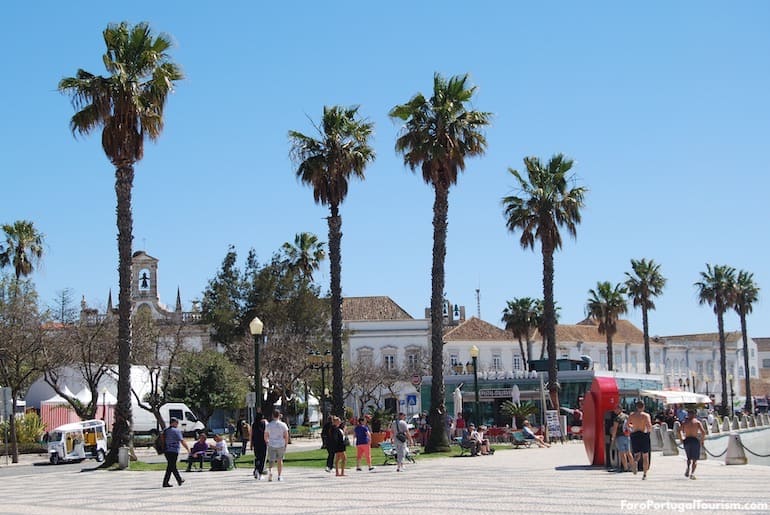
What is Faro?
First settled by the Phoenicians, Faro boomed as the Roman city of Ossonoba , was conquered by the Visigoths in 418 AD, and became a Moorish city in the 8th century. It was made part of the Kingdom of Portugal in 1249, and King Afonso III built a protective wall around it. The entire city was what is now the Old Town, within the preserved walls. Faro was a major cultural center by the 1400s, printing Portugal’s first books. In 1597, the Earl of Essex was heading back to England from Spain, when he stopped in Faro and plundered it. Many of its treasures are now in English museums, libraries (mainly at Oxford University) and palaces. The city recovered, but was almost completely destroyed in an earthquake in 1755. Much of the Old Town survived, but everything else was rebuilt. In 1834, it became the capital of Algarve .
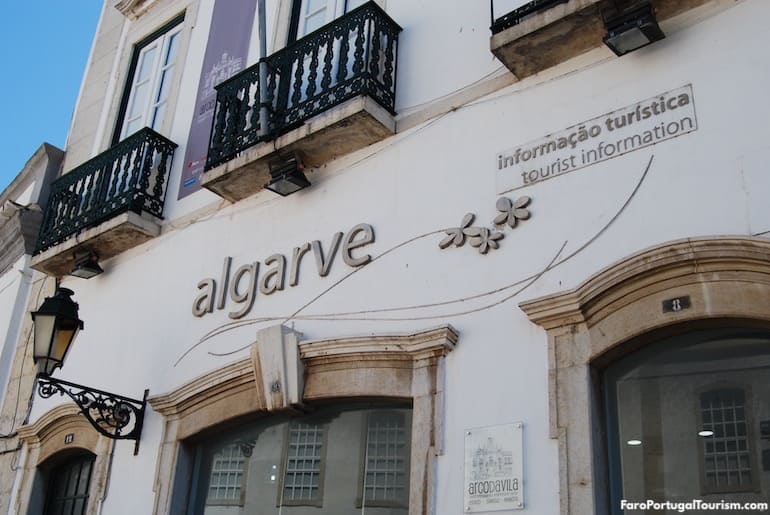
Official Faro Tourism Office
Everything you need to plan your visit to Faro is on this website. It provides complete and entirely independent information from locals and travel experts, not sponsored by or associated with any local institution or organization. However, if you still have any questions when you’re in town, pass by the official tourism office, which is located in the heart of the city, in the arch that opens to the old town. It also provides information on the entire Algarve region, as does the tourism office at the airport .
Complete Faro Guide
Where to stay.
Top 10 Hotels
Beach Hotels
Hostels and Budget Hotels
What to See and Do
Top 10 Attractions
Igreja do Carmo
Igreja de São Pedro
Igreja de São Francisco
Igreja-Museu da Misericórdia
Arco da Vila
Faro Museum
Algarve Regional Museum
Roman Ruins of Milreu
Estoi Palace
Beaches Guide
Ilha Deserta
Ilha do Farol
Ilha da Culatra
Ilha de Faro
Transportation
Faro Transportation
From Lisbon
Faro Airport
Other Algarve Guides
Algarve Tourism
Albufeira Tourism
Lagos Tourism
Tavira Tourism
Other Portugal Destinations
Lisbon Beaches
Algarve-Tourist.com
The best independent guide to the Algarve
Home page - Top 10 Algarve - Where to stay? - Best beach - For families - Day trips
Alvor, Portugal; an independent tourism guide for 2024
Alvor is one of the finest resort towns of the Algarve, and is the perfect destination if you want a relaxing, beach-based holiday. The town sits on the banks of the Ria de Alvor Estuary, while to the south of the town is the Praia do Alvor, one of the largest sandy beaches of the Algarve.
Alvor is a delightful town with a distinctively Portuguese ambience; there are traditional whitewashed houses, narrow cobbled streets, and fishing boats are moored along the banks of the river. Alvor may be a relatively small town, but it contains a surprisingly large selection of restaurants, shops and late-night bars, all of which are found within the pretty historic centre.
During the summer, the calm atmosphere of Alvor makes it a favourite with families, while outside of the peak season, it is popular with older visitors.
A holiday to Alvor is often focused around the beach, but there is a lot to see and do within the surrounding region. There are exciting waterparks, boat tours, golf courses, nature trails, dolphin watching trips, along with day trips to the fortified town of Silves, the historic city of Portimão, or the lively resort of Praia da Rocha.
Alvor also makes for a pleasant destination for a day trip. A common day trip visits the town, sees the harbour and wanders around the Ria de Alvor Nature Reserve (a detailed day trip guide is later in this article). There is a lot to love about Alvor, and this article will show you why you should visit, and help you get the most from the region. Related articles: Silves guide – Algarve top 10
Highlights of Alvor
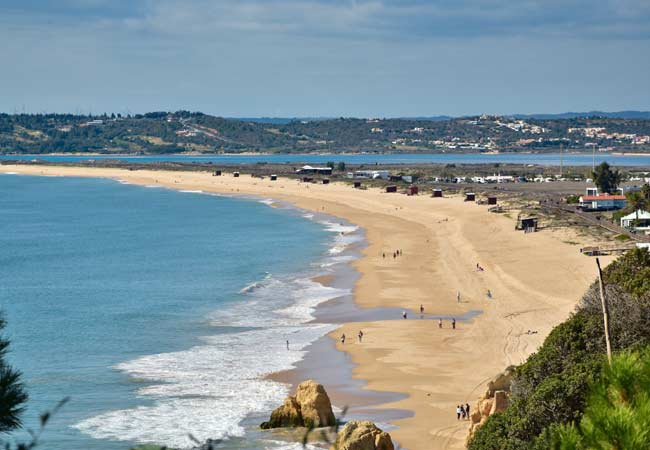
Praia de Alvor – The magnificent sandy beach that extends for 3.5km along the coastline of Alvor. This vast beach provides soft golden sands, clean sea waters and ample space for all of the summertime tourists.
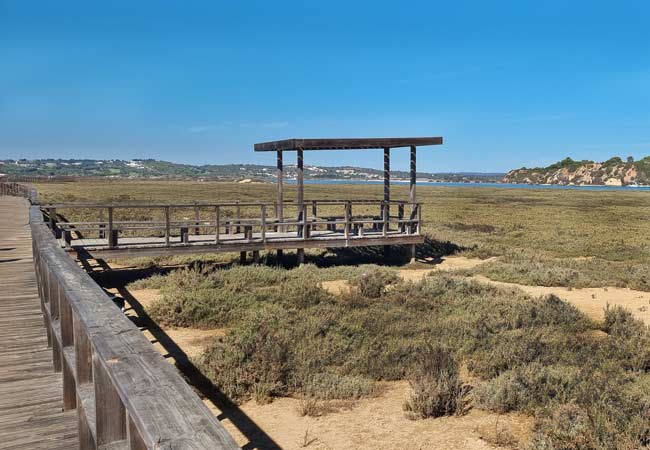
The Passadiços de Alvor – The series of raised walkways that pass through the protected sand dunes of the Ria de Alvor Nature Reserve and along the Praia de Alvor beachfront.
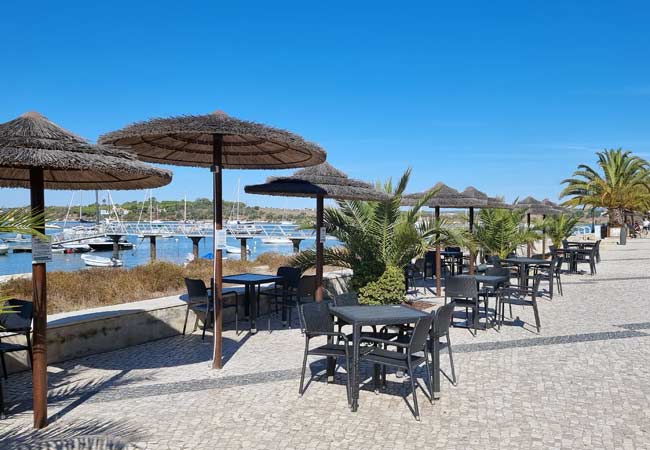
The relaxed ambience of Alvor – The town has a calm and unhurried pace, where days are spent relaxing on the beach, eating delicious Portuguese food, and socialising in the late-night bars and cafes.
Is Alvor the ideal holiday destination for you?
Alvor effortlessly combines all of the aspects needed for an amazing beach-based holiday. There is a vast sandy beach, the weather is glorious, and Portugal provides exceptional value for money.
Alvor was historically a fishing village, but it has responsibly grown into a popular tourist destination. Along the coastline are modern hotel complexes, while in the town are authentic Portuguese restaurants and lively bars. Alvor still retains its traditional Portuguese charm and character, and has not succumbed to mass tourism, as with many other beach towns.
Being a mid-size resort town, means Alvor has a decent selection of restaurants and shops, but it is still small enough to feel personable and welcoming. Being slightly smaller, Alvor does not attract focused party groups, and is much calmer in the summer than the larger resort towns (such as Albufeira, Praia da Rocha, Lagos and Vilamoura). This calmer atmosphere makes the town popular for families and older tourists.
The location of Alvor benefits from being close to the buzz of the central Algarve but is sufficiently distant not to feel overrun with hordes of package tourists. Activities within the Alvor region include boat tours, coastal hikes, golf courses, waterparks, surfing, and day trips to historic towns.
Alvor is calm and low-key, but the surrounding region certainly is not, and a holiday here can be peaceful or exciting as you wish to make it. Related articles: Day trips from Alvor
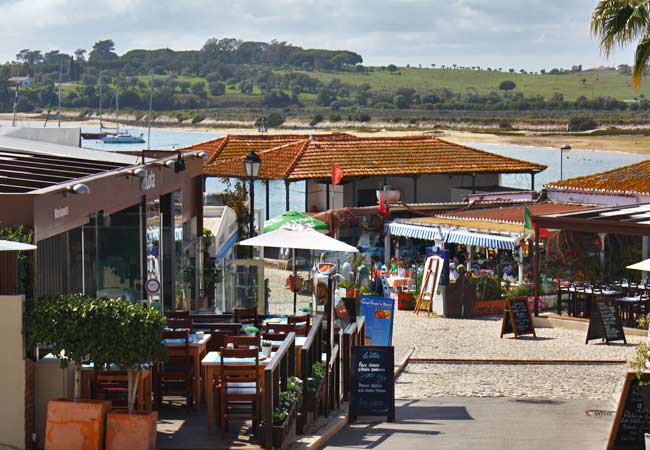
The bars and restaurants leading down to the waterfront of Alvor
Alvor holiday rating
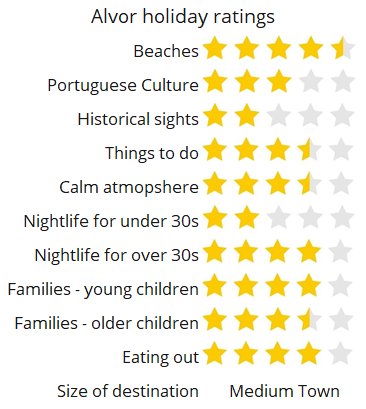
Alvor for 2024
Alvor is expecting a sell-out summer season for 2024, as more visitors seek holidays to safe and established destinations within Europe.
In 2024, the Algarve is expecting to attract many new tourists, and this will be in addition to the large number of returning visitors, who know just how great the region is.
Due to this increased popularity, Alvor is expecting a sell-out 2024 summer season. We strongly advise you to book your flights and accommodation as soon as possible before prices increase and sell out.
The map below displays the best hotels and accommodation in Alvor; if you adjust the dates to your holiday, it will display current prices and availability.
Insight: Many of the large hotel complexes, line the Praia de Alvor beach or are close to the João de Arens headland. From these locations, it is only a short walk into the centre of Alvor. There is also a regular bus service connecting Alvor, Praia da Rocha and Portimão that passes the hotel areas. The Algarve has ride-hailing apps (such as Uber and Bolt), and these provide an inexpensive method to travel around the region.
A day trip to Alvor
Alvor is not a common destination for a day trip, but an enjoyable half-day can be spent within the town.
A typical trip would visit the town centre, the fishing harbour and the Ria de Alvor Estuary (by following the Estação da Biodiversidade de Alvor nature trail). The later part of the day could wander along the footpaths of the Ria de Alvor Nature Reserve and visit the Praia de Alvor beach. Alvor does not have any historical monuments, it’s main draw is its Portuguese character and pretty setting.
Below is an interactive map for a suggested tour of Alvor (green line) and the sights of the region. The centre of Alvor, where most of the bars and restaurants are found, is highlighted in yellow. ( Note: zoom out to see all of the markers)
Sights of day trip: 1) Igreja do divino Salvador church 2) Biodiversidade de Alvor footpath 3) Alvor harbour front 4) Passadiços de Alvor and the Ria de Alvor Nature Reserve 5) Praia de Alvor beach 6) Praia dos Três Irmãos beach Sights around Alvor: 7) Slide & Splash (water park) 8) Alto Golf (golf course) 9) Aeródromo de Portimão (skydiving) 10) Ponta João de Arens headland Day trips from Alvor: 11) Lagos (a historic city) 12) Silves (a fortified town) 13) Praia da Rocha (lively beach resort) 14) Ferragudo (pretty fishing village) 15) Portimão (a port city)
Sights of the day trip The Igreja do Divino Salvador is a simple whitewashed church with a decorative Manueline entrance. The church dates from the 14th century but was completely rebuilt after the 1755 earthquake. The most notable feature is the 16th-century altar.
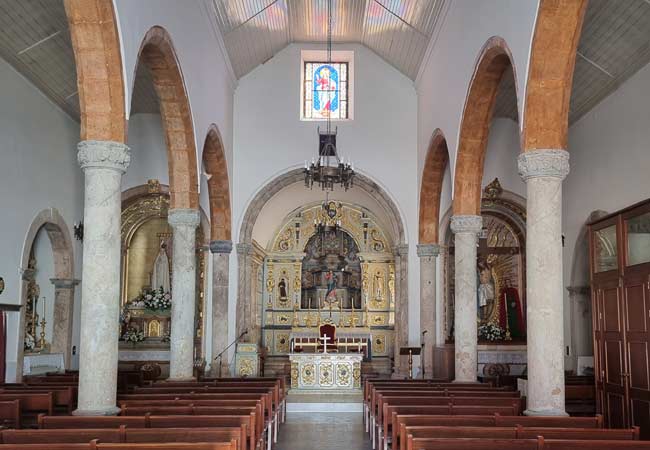
The Biodiversidade de Alvor is the footpath that weaves along the cliff tops of the Ria de Alvor up to the Torre dam and Torre Lake. Note: This is a very rough footpath and follows the top of a cliff, so good shoes are needed.
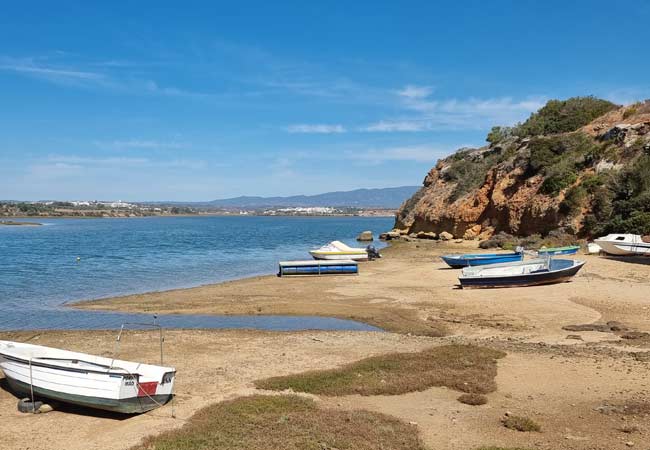
Alvor has an extremely pretty harbour and waterfront . The northern side is lined with restaurants and cafés, while to the south are traditional fisherman’s huts.
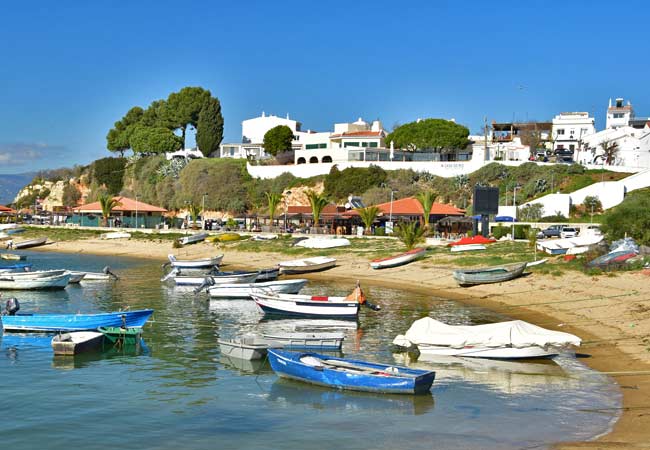
The waterways of the Ria Alvor are sheltered from the powerful Atlantic Ocean waves by the sandbanks of the Praia de Alvor. There has been a fishing community based on these calm waters since the Moorish era (8th century) when Alvor was called as Al-bur.
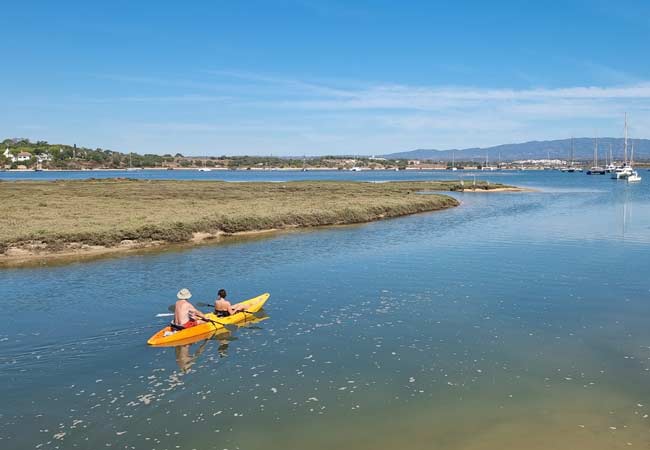
At the far eastern side of the Praia de Alvor beach is the picturesque Praia dos Três Irmãos beach , which nestles at the base of golden sandstone cliffs.
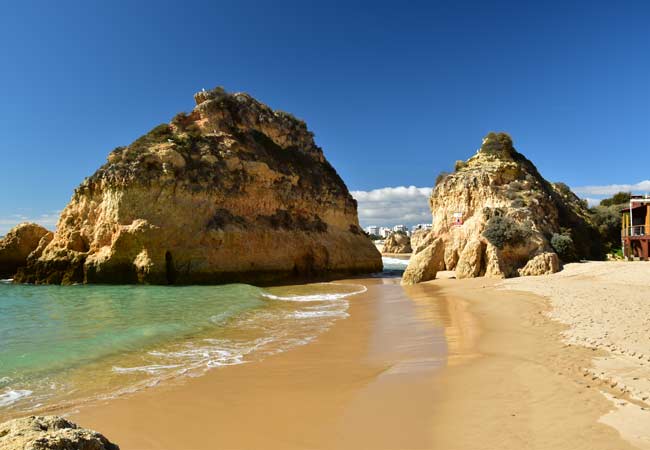
These cliffs lead up to the João de Arens headland, one of the few untouched areas of the central Algarve coastline. Within this headland are forested walks and pristine cove beaches.
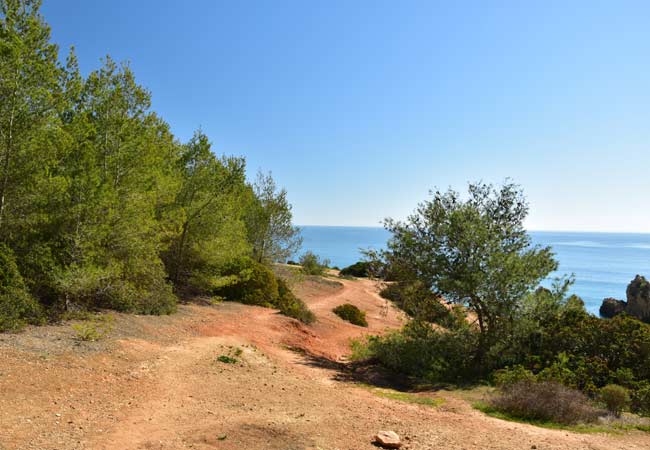
Where are all of Alvor’s historical monuments?
Alvor has an extensive history. It was originally established by the Romans, and grew to be an important trading town during the Moorish era. In 1189 the town was conquered by King Sancho I, who fortified the castle and improved town defences. In 1495, King John II (who is regarded as one of Portugal’s greatest kings) died in Alvor castle.
With all of this varied history, you would expect numerous historic monuments, but they were all destroyed by the 1755 earthquake. The only remnants from prior to the earthquake are the foundations of the castle, which has been converted into a children’s playground.
When to visit and Alvor weather
Alvor has hot summers, pleasant spring and autumn seasons, and mild but unpredictable winters. July and August are the height of the tourist season and is when the beaches are packed, and hotels are sold out.
Outside of the peak season, Alvor becomes a calm and relaxed town, and the best season to visit is during the late spring or early autumn. The weather in southern Portugal is suitable for spending time on the beach from May through to the end of October.
Alvor closes down for winter at the end of October and reopens at Easter. During the closed season, the town will feel very quiet. Related articles: When to visit Alvor?
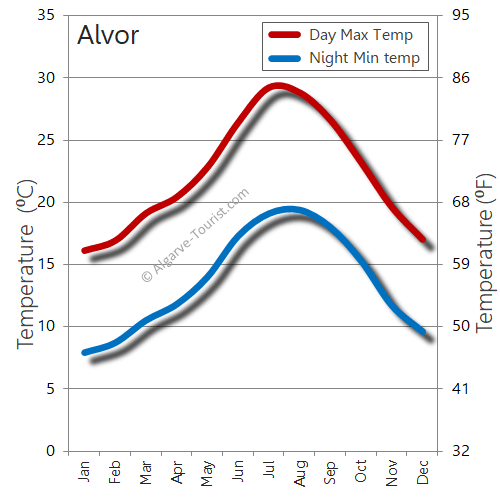
The daytime maximum temperature (measured in the shade) and night-time minimum
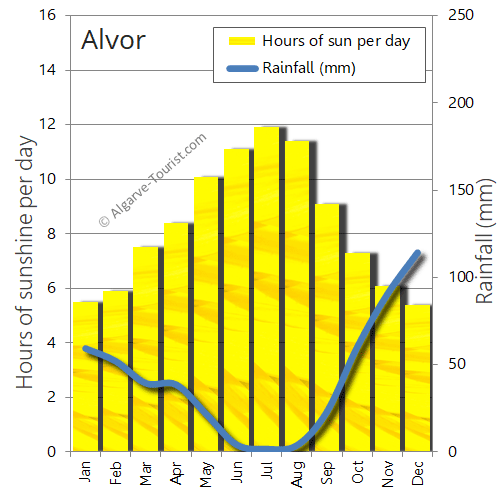
The average hours of sunshine per day and monthly rainfall
Alvor airport and transfers
Faro airport is the main international airport of the Algarve region, and this is located 70km to the east of Alvor.
For the transfer from the airport to Alvor, it is recommended to pre-book a transfer, as the journey by public transport is very difficult and time-consuming. The route from Faro airport to Alvor by public transport requires two buses and one long train journey and, depending on connections, can take more than four hours.
Private transfer ranges between €70-80 while a shared transfer by coach will be around €20-30 per person. A taxi hired from Faro airport will be significantly more than a private transfer. Related articles: Faro airport to Alvor

Faro airport is modern and relatively easy to travel through
Does Alvor have good beaches?
Alvor has an amazing sandy coastline that extends for over 3.5km from the mouth of the Ria de Alvor in the west to the João de Arens headland in the east.
This is a beautiful sandy beach with clean seawaters and large waves depending on the weather conditions. During the summer, the beach is supervised by lifeguards and is safe for children. On the beach, sunshades and parasols can be hired for €15 per day.
To the rear of the beach are numerous beach bars and restaurants (Restinga, Cinco Quinas and Dunas Restaurante).
The sea temperature at Alvor is always chilly, reaching a maximum of just 21C in the hot summer months.
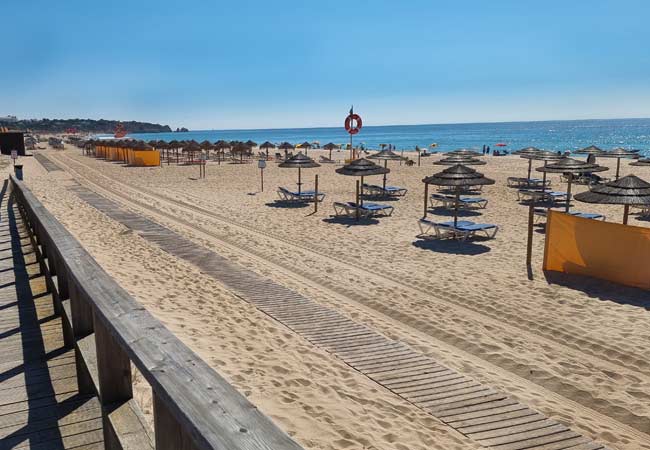
The Praia de Alvor, early in the morning before the summertime crowds arrive
Day trips from Alvor
From Alvor it is very easy to visit the towns of Portimão and Praia da Rocha, as these two destinations are connected by the inexpensive local bus network.
Praia da Rocha is a busy and hectic resort town that is situated on a beautiful beach. This is the perfect place to head to for a big party night out, as the town is crammed full with themed bars and late night venues.
Portimão is a large residential city that offers a scenic harbour, good shopping, and a chance to experience typical Portuguese daily life. Portimão is a major transport hub and from here it is possible to catch further buses to the historic towns of Silves and Lagos.
Silves was the ancient capital of the Algarve and contains the Algarve’s best-preserved castle along with other monuments that reflect the once importance of the town.
Lagos is a much larger city and was the centre for Portugal’s glorious 14th century age of exploration. Lagos’ attractions including a fort, city walls, decorative churches and even a former slave market. Within walking distance of Lagos are the highly weather cliffs of the Ponta da Piedade, which are regarded as best natural feature of the Algarve. Related articles: Portimão - Praia da Rocha - Lagos - Silves
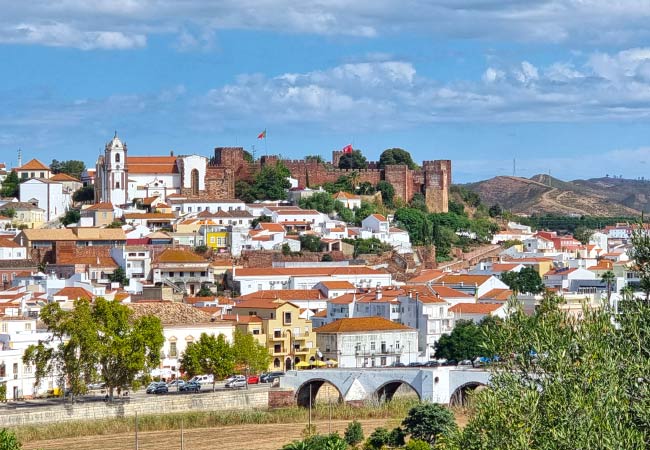
Our most popular guides to the Algarve
Where to stay?

What Algarve town is the best for your holiday?
Top 10 Algarve

What are the top 10 sights and activities in the Algarve?
Best Beaches

Discover the finest beaches of the Algarve
For families

Is the Algarve a good destination for a family holiday?

What are the best places to visit during my holiday to the Algarve?

The largest and liveliest resort town of the Algarve

History, beaches, and nightlife -Lagos is rightful popular!

The most charming town of the eastern Algarve

Family-holiday destination on a magnificent coastline

The historic city of Faro has much more than just it's airport

The Algarve's slice of sophistication and exclusivity

The ancient capital of the Algarve, with an impressive castle
Praia da Rocha

Exciting resort town set on a stunning beach

Experience authentic Algarve in this pretty market town

The Algarve's finest mid-size resort town
Praia da Luz

Where to escape the masses, to relax and unwind

Dramatic scenery and outstanding surfing, at the far western Algarve
V ila Nova de Milfontes

Authentic Portugal on the undiscovered Alentejo coastline
Algarve Guides
- Algarve Introduction
- Best town in the Algarve?
- Itineraries and tours
- Algarve for Families
- Day trips in the Algarve
- Algarve for Christmas
- Slow travel in the Algavre
- Algarve's best golf courses
- Lisbon to the Algarve
- Praia da Marinha beach
- Praia da Falésia
- The Algarve in September
- Faro Introduction
- Faro top 10
- Faro's beaches
- Airport to Faro
- Day trip to Faro
- Bone Chapel
Carvoeiro guide
- Carvoeiro introduction
- Carvoeiro beaches
- Sete Vales Suspensos hike
- Carvoeiro day trips
- Ferragudo day trip
Alvor Guide
Alvor Introduction Alvor weather Alvor day trips Airport to Alvor
Vilamoura guides
- Vilamoura introduction
- Sights & activities
- 1 week in Vilamoura
- When to visit Vilamoura?
- Vilamoura Beaches
- Vilamoura day trips
- Airport to Vilamoura
Lagos guides
- Lagos Introduction
- 1 Week in Lagos
- The Ponta da Piedade
- Praia da Rocha intro
- Portimão guide
- Rocha beaches
Albufeira guides
- Albufeira introduction
- 1 week in Albufeira
- Albufeira beaches
- Albufeira day trips
- Praia de São Rafael beach
- Airport to Albufeira
Portugal guides
- Where to go in Portugal?
- Top 10 Portugal
- When to visit Portugal
- Top 10 beaches
Tavira guides
- Tavira Introduction
- Tavira top 10
- 1 Week in Tavira
- Tavira beaches
- Tavira day trips
- Anchor cemetery
Wedding Website
- Bridesmaids: who to ask?
- Seating plan
- Creating wedding invitations
Algarve Towns
- Armação de Pêra
- Monte Gordo
- Olhos de Água
- Praia de Luz
- Vila Nova de Milfontes
The best tourist destinations in Portugal
Aveiro , Braga , Batalha , Cascais , Coimbra , Estoril , Evora , Guimaraes , Lisbon , Nazaré , Obidos , Madeira , Peniche , Porto , Sesimbra , Setubal , Sintra , Tomar , Troia Peninsula , Viama Do Castelo
England guides
Winchester Salisbury Arundel Lymington New Forest
- Bridal party gift ideas
- Wedding Budget
- Hiring a wedding caterer
- Wedding dress shopping
- Finding a wedding dress
Alvor Algarve Portugal Tourist Guide © 2024 Algarve-Tourist.com - Privacy Policy & Contact Page

The best guide to Alvor
Lagos Tourism Guide
The best lagos travel tips, trip planner and insider's guide.
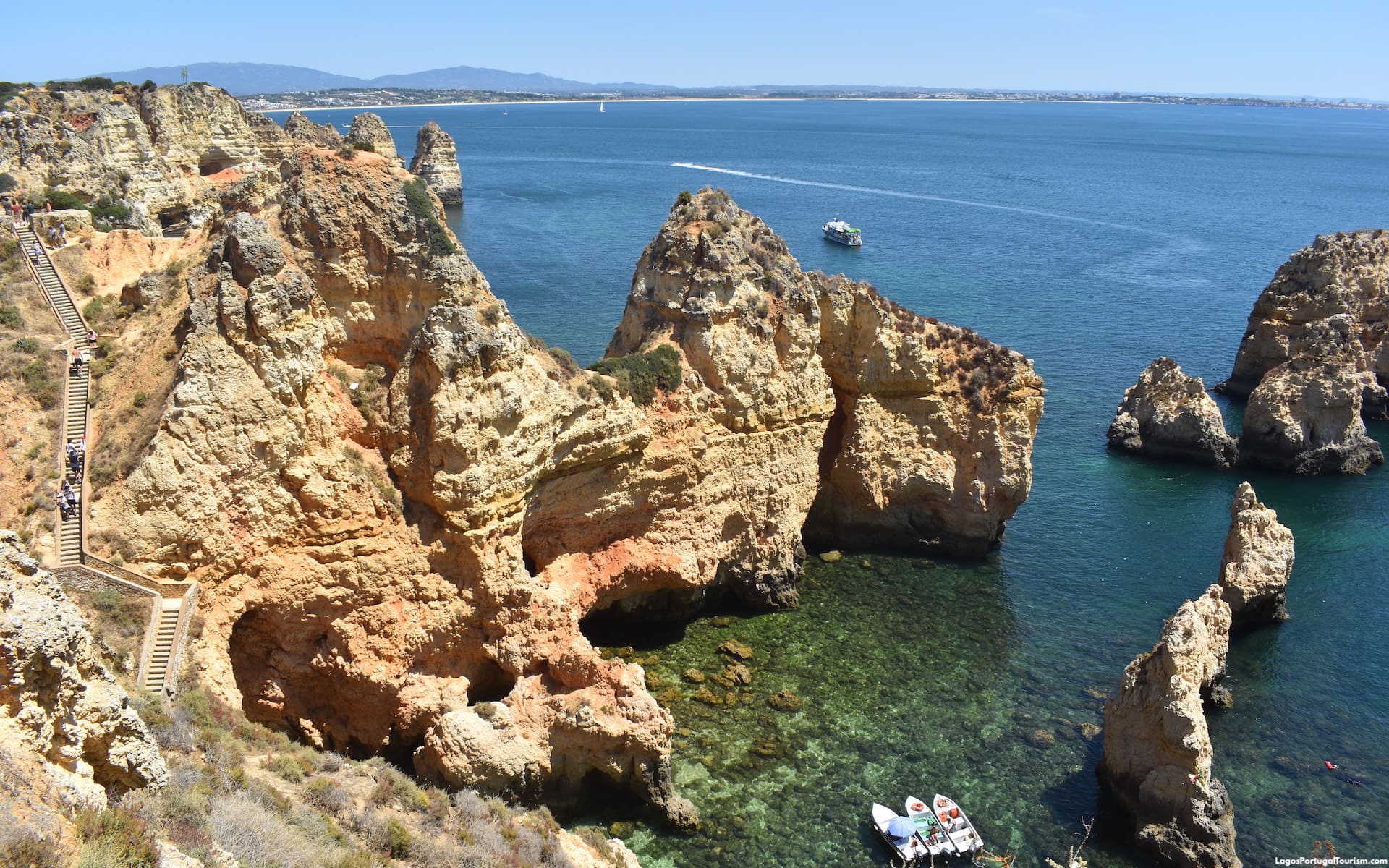
H ome to some of Portugal’s (and the world’s!) most beautiful beaches , Lagos has become a favorite tourist destination. Its ochre rock formations and cliffs sculpted by the wind and the sea are symbolic of the Algarve (Europe’s southwesternmost region) and are popular images on social media. The edge of the continent is found nearby, which ancient Europeans thought to be the end of the world. This coastline’s history and stunning natural beauty , as well as the town’s relaxed atmosphere, guarantee that visitors always leave wanting to return. You will too.
Lagos Travel Planner
Helpful insider tips to plan the perfect days in the city:.
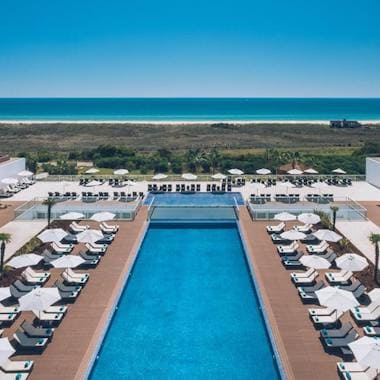
Where to Stay The Best Areas and Hotels
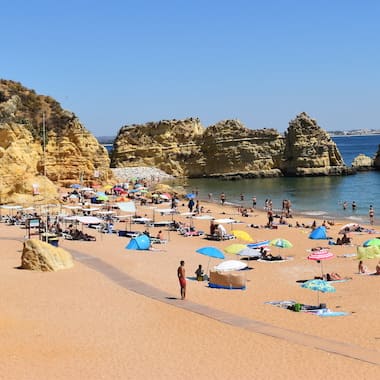
The Best Beaches Choose the right beach for you
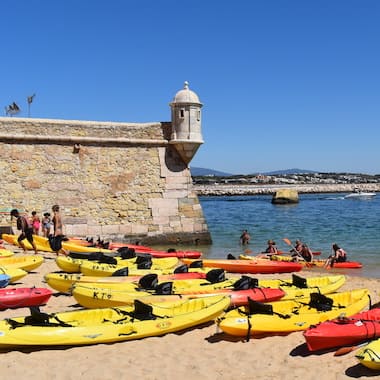
Top 10 Attractions The Best Things to See and Do
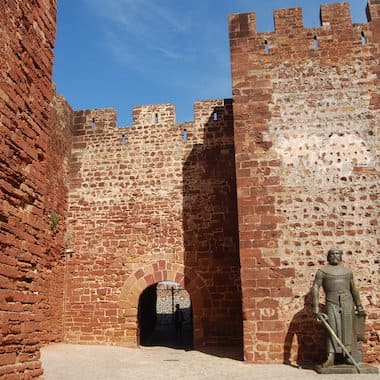
The Best Day Trips Where to Go Around Lagos
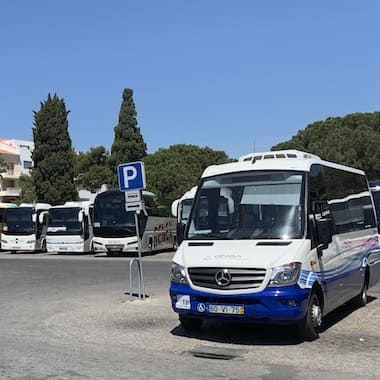
Transportation Guide How to Get There and Around

Algarve Guide The Other Destinations in Southern Portugal
When to visit lagos.
Blessed with a climate of warm summers and mild springs and autumns, Lagos is a destination for almost any time of the year. Temperatures in the dry summer days can reach 35 to 40 degrees celsius (95 to 105 degrees Fahrenheit), but nights are always much cooler and pleasant. Spring and autumn months are mostly sunny, with the occasional rainy day. Keep in mind that Portugal’s Algarve region has over 3000 hours of sun per year (compare that to London’s 1450 hours and New York’s 2150 hours), so consider yourself unlucky if you happen to be in town on a rainy or stormy day! You can have a pleasant beach day as early as May and as late as mid-October . In winter, it will never be warm enough for sunbathing.
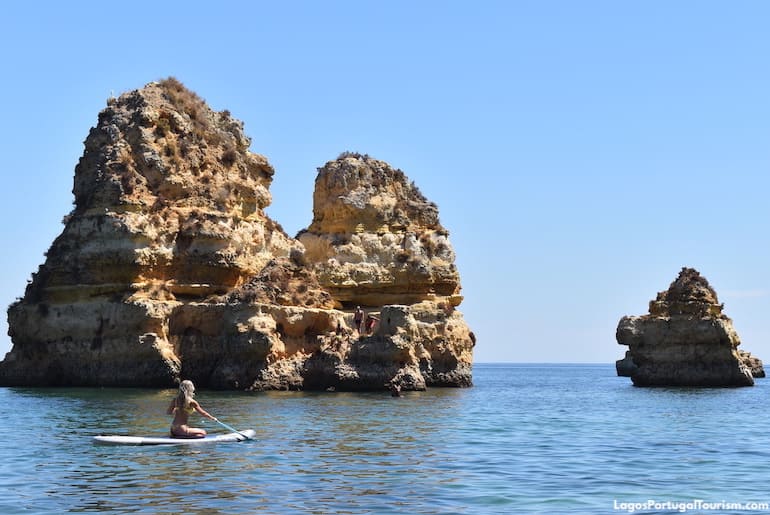
How Many Days in Lagos?
Lagos is a perfect destination for an extended summer holiday. If you’re on a tour of Portugal or exploring the region of Algarve, you should dedicate two days to Lagos, in order to experience its cultural sights, dramatic coastline, and the main beaches. However, those looking for a destination to relax in the sun and by the sea often stay for a week or more . You can go to a different beach on each day of the week, and also take day trips to towns nearby, on the coast and inland (such as the Sagres promontory or the castle in Silves ). In fact, as a major transportation hub in the region, Lagos is an excellent base to explore Western Algarve.
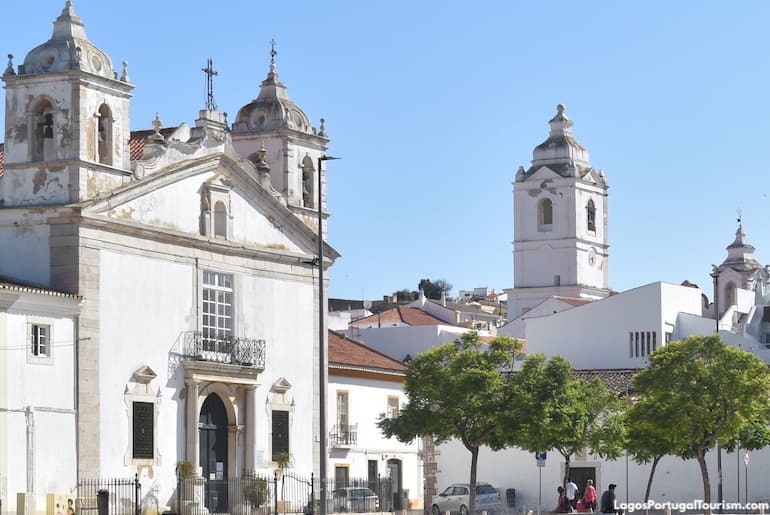
What You Need to Know Before You Go To Lagos
It’s one of portugal’s most historic cities.
Originally the Celtic settlement of Lacóbriga, Lagos prospered during the Roman occupation, and was also a significant Moorish city before becoming part of the Portuguese kingdom in the 13th century. It played an important role during the Age of Discovery, with Prince Henry the Navigator (governor of the province of Algarve, and responsible for the early days of European exploration and maritime trade) sponsoring an expedition by local explorer Gil Eanes, who ended up being the first to make it past Cape Bojador in 1434. This opened the way for other explorers, such as Vasco da Gama, who later found a new maritime route to the East, creating the modern age of global trade.
It Had the First African Slave Market in Europe
At first, the trade of the new maritime routes consisted mostly of Asian spices, but as they went down the coast of Africa, the Portuguese navigators also traded slaves and Lagos established the first African slave market in Europe. From Portugal, these “servants” were sent across the Atlantic to the colony of Brazil, but were also bought by the British, Spanish, French, and Dutch empires. The market where these transactions took place still exists, and has been turned into a small museum, telling this story and serving as an “international center for living memory of human dignity.”
It Was Largely Destroyed by an Earthquake in the 18th Century
A major earthquake in 1755 destroyed much of southern Portugal, including Lagos, so this is mostly a late-18th-century city. Its churches and other buildings had to be rebuilt or restored, and reflect the baroque style of the time. The greatest monument is Igreja de Santo António ( Church of St. Anthony ), with its gold-covered interior from 1769.
It’s a Destination for Everyone
Couples, families with children, backpackers, gay, senior and active travelers will all find Lagos to be perfectly suited for them. There are beaches for every taste and lifestyle, as well as activities and historic sights for those who like to combine adventure or culture with days at the beach.
It Has a Lively Nightlife
The largely pedestrianized Old Town of Lagos is lined with outdoor restaurants and bars open until late. This isn’t a party town (for that, you’ll want to head to Albufeira instead), but it’s a place to enjoy the warmer summer nights and relax with a few drinks.
You Should Book Early
Lagos is not a big city, and although it has a considerable number of hotels, everything gets fully booked quite early for the high season. If you’re planning to visit between June and September, make sure you book accommodation well in advance. Check prices and availability here : Lagos Hotels, Apartments, Hostels
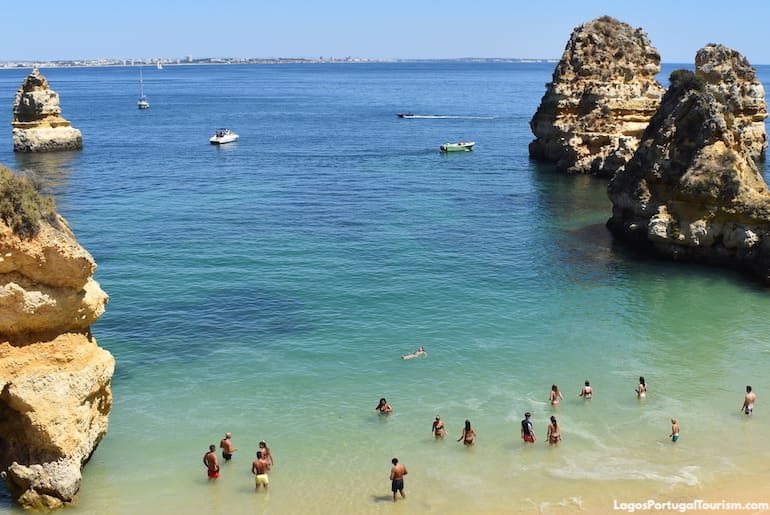
Official Lagos Tourism Office
Everything you need to know about Lagos and to plan your visit is on this website. It offers entirely independent and complete information from locals and travel experts, not sponsored by or associated with any local institution or organization. However, if you still have any questions when you’re in town, pass by the official tourism office, which is located in the heart of the city, in Praça Gil Eanes . It also provides information about the entire Algarve region, as does the tourism office at Faro Airport, if you’re arriving by plane.
Complete Lagos Guide
Where to stay.
Top 10 Hotels
Beach Hotels
Romantic Hotels
5-Star Hotels
Hostels and Budget Hotels
What to See and Do
Top 10 Attractions
Ponta da Piedade
St. Anthony Church
Slave Market
Ponta da Bandeira Fortress
The Best Day Trips
Day Trip to Silves
Day Trip to Sagres
Cruises and Boat Tours
The Best Beaches
Praia do Camilo
Praia da Dona Ana
Praia da Batata
Praia dos Estudantes
Praia do Pinhão
Praia do Porto de Mós
Praia dos Pinheiros
Praia do Canavial
Praia da Luz
Beaches Map
Transportation
Lagos Transportation
From Lisbon
From Faro Airport
Bus from Faro
Bus to Sagres
Other Algarve Guides
Algarve Tourism
Albufeira Tourism
Faro Tourism
Tavira Tourism
Other Portugal Destinations
Lisbon Beaches
Tavira Tourism Guide
The best tavira travel tips, trip planner and insider's guide.
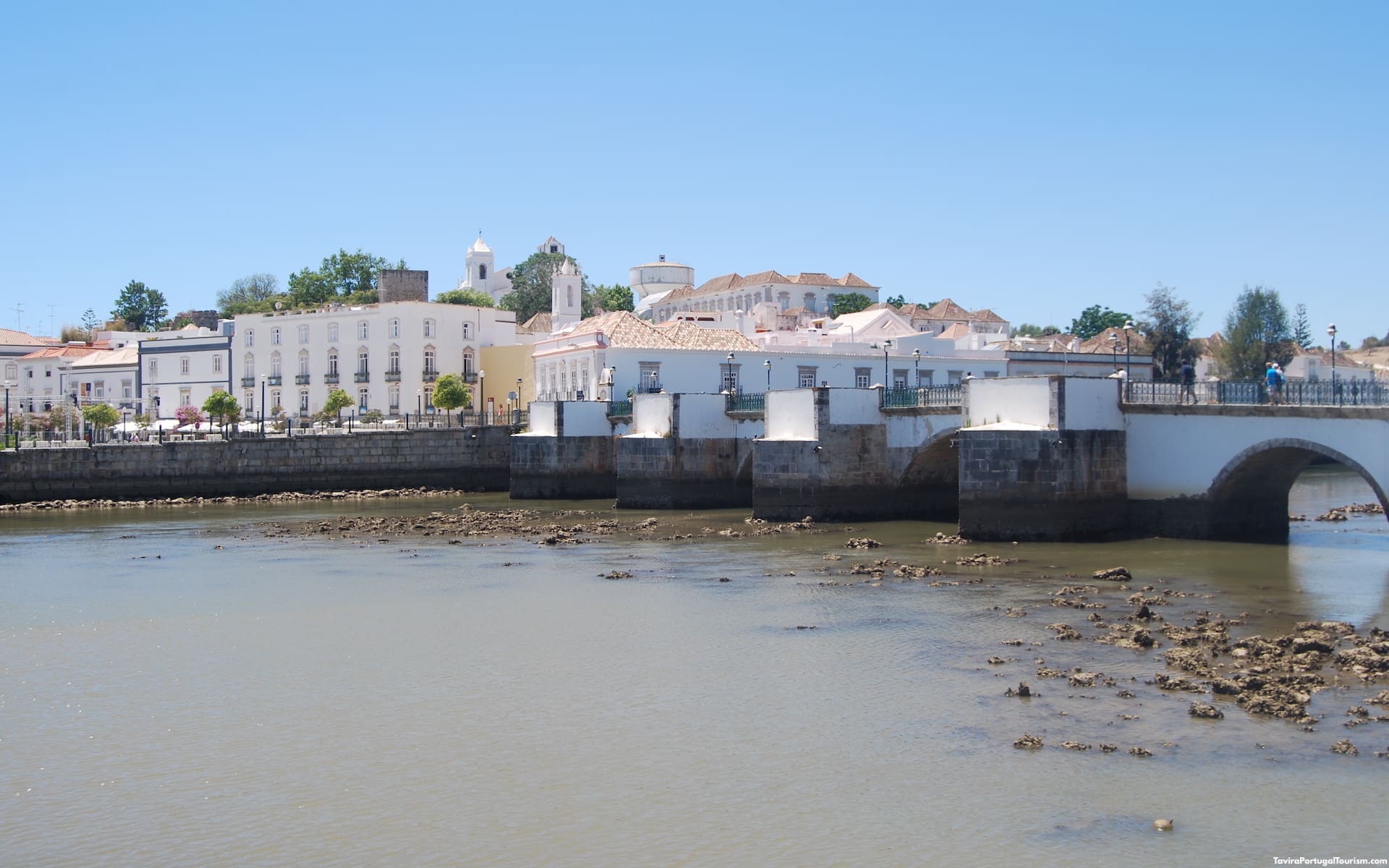
T avira is widely considered the Algarve's most romantic town and one of the most delightful in southern Portugal. The Gilão River meanders through it, and the Old Town is a pretty maze of cobblestone streets leading to whitewashed churches, shady squares, and homes that preserve the traditional architecture with pyramid-shaped rooftops. Boats go to the barrier islands of the Ria Formosa Natural Park, which have some of the best beaches in the region . All this makes it a perfect destination for those looking for a holiday combining culture and beach .
Tavira Travel Planner
Helpful insider tips to plan the perfect days in the city:.
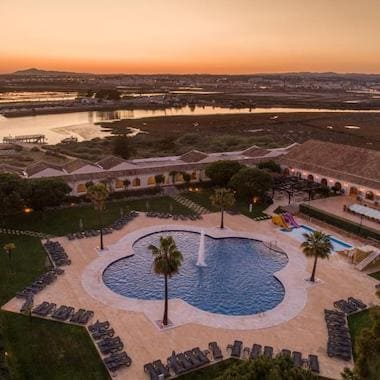
Where to Stay The Best Areas and Hotels
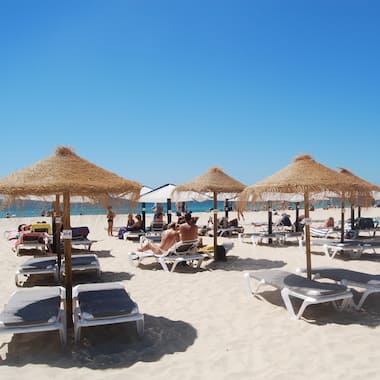
The Best Beaches Choose the right beach for you
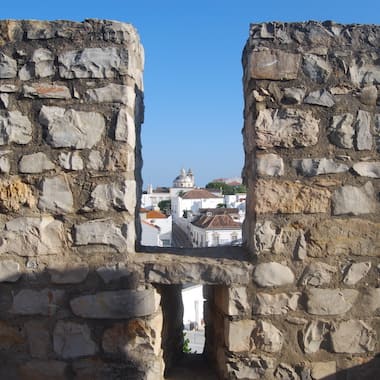
Top 10 Attractions The Best Things to See and Do
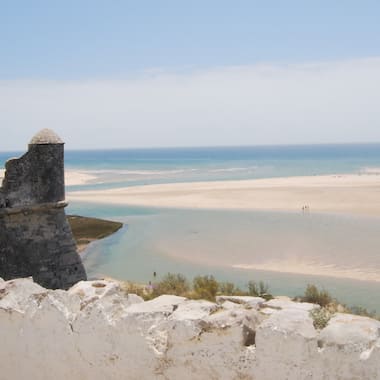
The Best Day Trips Where to Go Around Tavira

Transportation Guide How to Get There and Around

Algarve Guide The Other Destinations in Southern Portugal
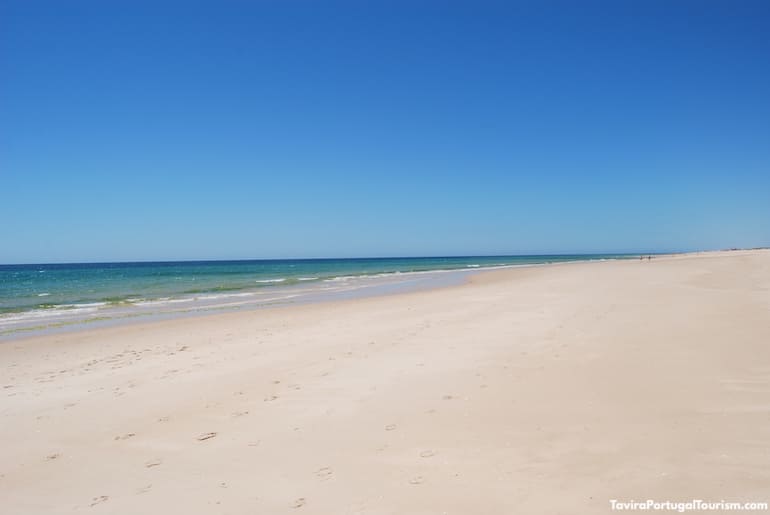
When to Visit Tavira
Tavira attracts tourists throughout the year, especially Northern Europeans looking for warmer temperatures and sunnier days. However, this is not a “winter at the beach” destination, as it’s only warm enough for sunbathing between the months of April and October. Spring and autumn are mild, and summers are warm, but there are plenty of rainy days in winter, despite this being one of the driest regions in Europe and with the most hours of sunshine. August is when the city and its beaches are more crowded, so late June, July and early September are the best times to visit.
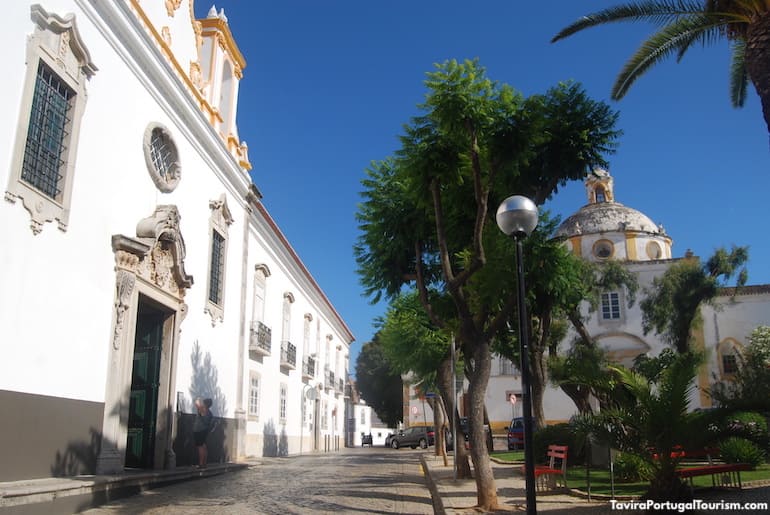
How Many Days in Tavira?
You can see all of Tavira’s monuments in just a few hours, but the main reason for a visit is to relax in a charming town and its beaches. You’ll therefore want to stay at least two or three days . Of course many people stay for an extended summer holiday, taking day trips to the towns nearby and enjoying the different beaches in the surroundings. Its location also makes it a good base for southwestern Spain -- it’s just 30 minutes from the border, with a highway heading straight to Seville, one of the great historic cities in the Iberian Peninsula.
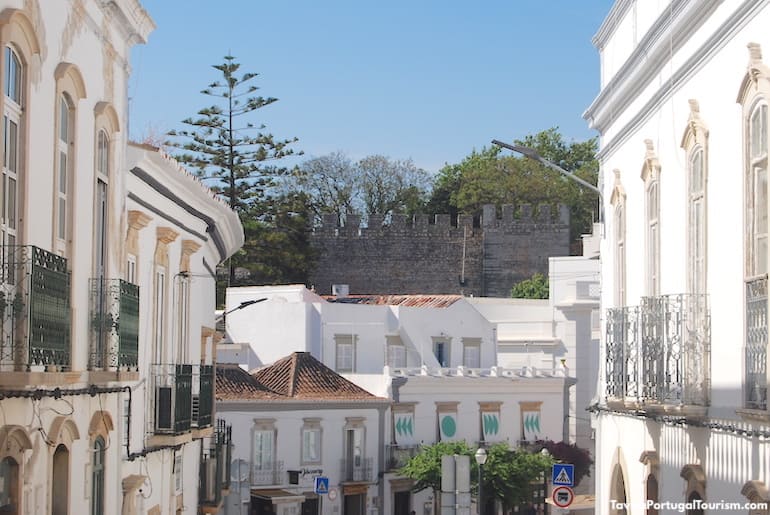
What is Tavira?
Tavira was first settled by the Phoenicians, then came the Celts, the Romans, the Visigoths and finally the Moors, before becoming part of the Kingdom of Portugal, which expanded its territory to the south in the 13th century. The Romans built the first bridge in the center of town, and the Moors erected the walls of the castle, but most historic monuments date from the 16th to the 18th centuries. In the 1500s, the city was a major port, exporting salted fish, almonds and wine to northern Europe. It declined a century later, when the river silted up and large boats could no longer enter the port. A major earthquake in 1755, which devastated most of southern Portugal, damaged much of the city, and it remained a quiet fishing town until the 20th century, when tourism became the main industry.
Official Tavira Tourism Office
Everything you need to plan your visit to Tavira is on this website. It offers complete and entirely independent information from travel experts and locals, not associated with or sponsored by any local organization or institution. However, if you still have any questions when you’re in town, pass by the official tourism office, which is located right in the city’s main square (Praça da República) and also offers information about other destinations in Algarve.
Complete Tavira Guide
Where to stay.
Top 10 Hotels
Beach Hotels
Romantic Hotels
What to See and Do
Top 10 Attractions
Igreja da Misericórdia
Beaches Guide
Ilha de Tavira
Praia do Barril
Praia da Terra Estreita
Praia do Homem Nu
Ilha de Cabanas
Beaches Map
Transportation
Tavira Transportation
From Lisbon
From the Airport
Tavira Buses
Tavira Ferries
Other Algarve Guides
Algarve Tourism
Albufeira Tourism
Faro Tourism
Lagos Tourism
Other Portugal Destinations
Lisbon Beaches

IMAGES
VIDEO
COMMENTS
Algarve. It was here that, in the 15th century, the Portuguese set off on the epic journey that led them to discover other peoples and cultures… and it is in the Algarve that we cheerfully welcome many of our visitors. Even the climate is mild and sunny all year round! There's no shortage of high quality beaches either.
The Algarve - A tourism guide for 2024. The Algarve is the beautiful southern coastline of Portugal. It is a region blessed with glorious sandy beaches, picturesque fishing towns and a glorious climate, all of which combine to create the perfect holiday destination. The Algarve is wonderfully varied; there are pristine beaches for families ...
Albufeira Tourist Office At: Rua 5 de Outubro, 8200-109 Albufeira Tel: 289 585 279 email; Alcoutim Tourist Office At: Rua 1º de Mayo. 8970-056 Alcoutim Tel: 281 546 176 email; Lagos Tourist Office At: Rua Vasco da Gama (S. João), 8600-722 Lagos Tel: 282 763 031 email; Loulé Tourist Office At: Av. 25 de Abril 9, 8100-506 Loulé Tel: 289 463 ...
Official Algarve Tourism Office. Everything you need to plan your visit to Algarve is on this website. It offers complete and entirely independent information from locals and travel experts, not sponsored by or associated with any local institution or organization. However, if you still have any questions when you arrive, pass by the official ...
The Algarve. Portugal, Europe. Soaring cliffs, sea caves, golden beaches, scalloped bays and sandy islands draw over four million visitors to the Algarve each year. Surrounded on two sides by the Atlantic, it's a paradise for surfers, especially along the refreshingly undeveloped west coast. Best Time to Visit.
Visit Algarve, Faro (stad). 221,419 likes · 1,039 talking about this · 285 were here. Welcome to the official Facebook page of Algarve Tourism Board and the Algarve Tourism Bureau. Join
8. Galé. Best place for couples. The quiet village of Galé is one of the best places in the Algarve for a romantic getaway. The town's picturesque beach ( Praia da Galé) is an obvious choice for a day on the waterfront, and even more secluded spots (like Praia das Salamitras) are a short hop from town.
Algarve. The Algarve is the southernmost region of Portugal, on the coast of the Atlantic Ocean. It is Portugal's most popular holiday destination due to the approximately 200 km (120 mi) of clean beaches, the cool, unpolluted water, and the fact that it is relatively cheap, very safe, and overall welcoming.
Tourist Information. The Faro Tourist Office is on Rua da Misericordia 8-12 (tel. 289 803 604). Igreja do Carmo, Faro, the Chapel of Bones is at the back. Doca de Recreio, Faro ... Other places to visit in the Algarve region of Portugal include Albufeira, Alcoutim, Aljezur, ...
AccommodationHow to get to AlbufeiraPlan your trip. Events calendar. Visit Albufeira. The sea breeze on your face, sun-kissed warmth on your skin and a heart set on new adventures…can you feel it? Albufeira has thrills for every traveller. Explore More. Urbanização Quinta da Bolota, Lote 4, 8200 Albufeira. Tel: (+351) 289 580 533.
1. Faro. Faro's Old Town. Busy Faro is the capital city of the Algarve, and its international airport is the gateway for many tourists arriving in southern Portugal. As the largest city in the region, Faro accommodates around 50,000 inhabitants and is a modern industrial and manufacturing hub.
Faro is a historic and culturally rich city that boasts a variety of fascinating tourist attractions. Sadly, Faro is often overlooked, considered only for its airport, but if you spend time in Faro, you will discover a charming Portuguese city. Found within the historic quarter (the Cidade Velha) is a Gothic cathedral, the Paço Episcopal ...
Rent a car: 40 euros per day + 50€ for the tank (for one week) Fun and activities: 350€ per week. Calling a Taxi or Uber: 30 euros per week. Flights 250€ come and go (if bought in advance) Total: 4940€ So you'd need at least 4940€ to spend a decent time in the Algarve, for 4pax.
Monte Gordo, Portugal; a tourism guide for 2024. Monte Gordo is a lively resort town that is situated on one of the finest beaches of the eastern Algarve. This glorious beach has transformed Monte Gordo from a minor fishing village into a modern and popular holiday destination. The town attracts a wide selection of nationalities, including the ...
Experience and discover the real Algarve - taste local produce, drinks and traditional dishes, visit heritage sites and participate in culinary activities. If you are passionate about the people's culture and gastronomy and want to learn more, this itinerary is for you. view trip ⤍. 11 days / from1744 USD.
It also provides information on the entire Algarve region, as does the tourism office at the airport. Faro 2024 Deals! Get a discount of 15% to 70% on accommodation in Faro! Look for deals here: Faro Hotels, Apartments, Hostels. Before You Travel: 1. Discover Faro's beaches. 2.
Alvor, Portugal; an independent tourism guide for 2024. Alvor is one of the finest resort towns of the Algarve, and is the perfect destination if you want a relaxing, beach-based holiday. The town sits on the banks of the Ria de Alvor Estuary, while to the south of the town is the Praia do Alvor, one of the largest sandy beaches of the Algarve.
It also provides information about the entire Algarve region, as does the tourism office at Faro Airport, if you're arriving by plane. Lagos 2024 Deals! Get a discount of 15% to 70% on accommodation in Lagos! Look for deals here: Lagos Hotels, Apartments, Hostels. Before You Travel: 1.
A major earthquake in 1755, which devastated most of southern Portugal, damaged much of the city, and it remained a quiet fishing town until the 20th century, when tourism became the main industry. Official Tavira Tourism Office. Everything you need to plan your visit to Tavira is on this website.
Portugal's government vowed on Thursday to speed investments worth 366 million euros ($397.7 million) to combat a "systemic drought" in the tourism-dependent southern region of Algarve and quickly ...